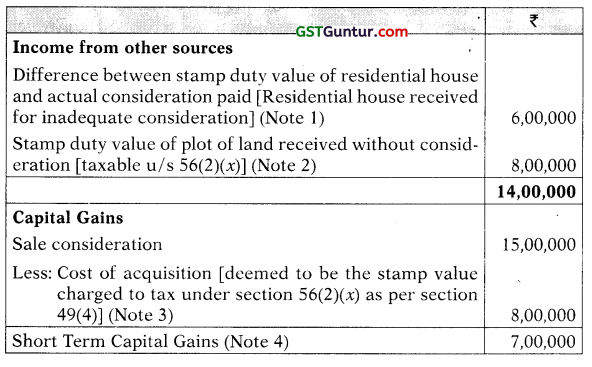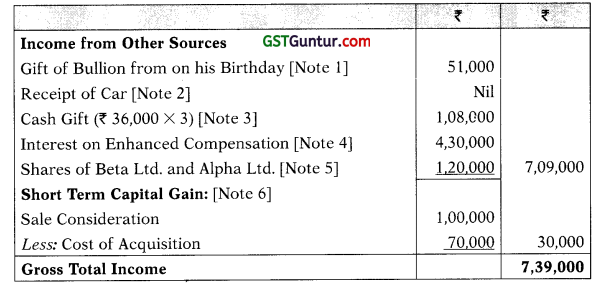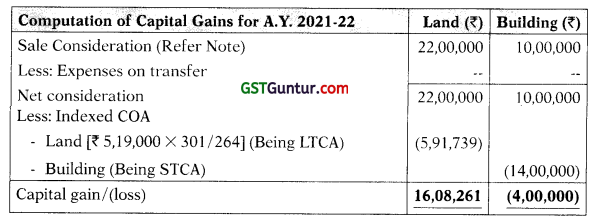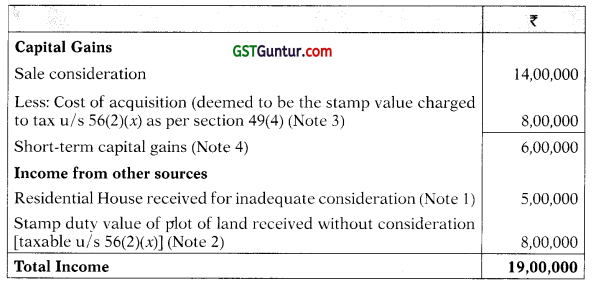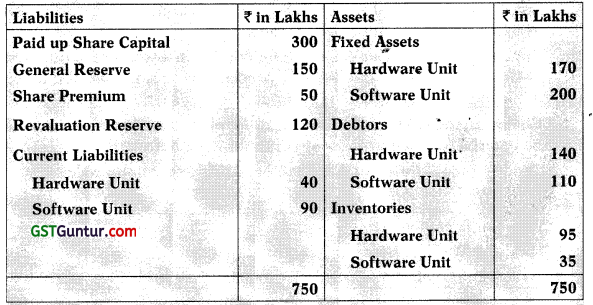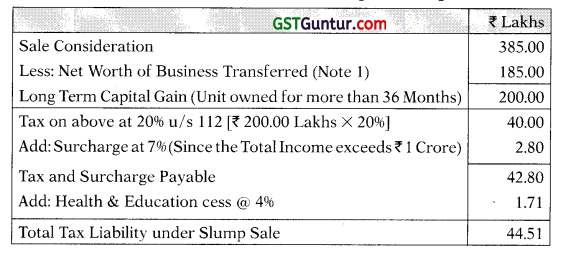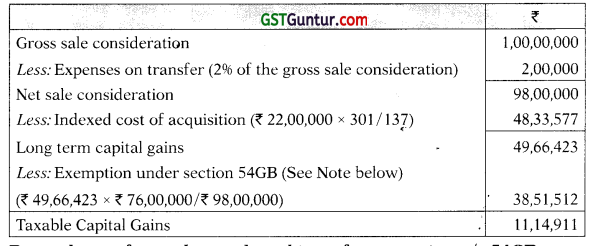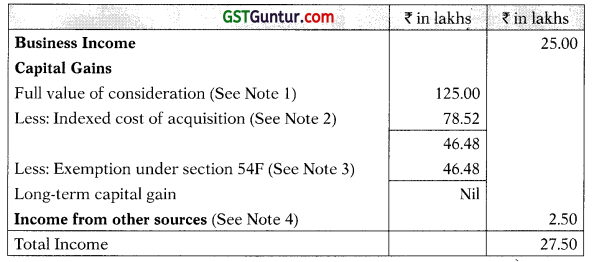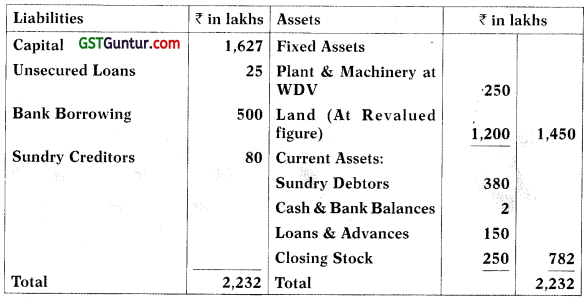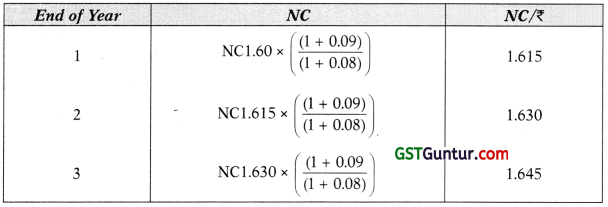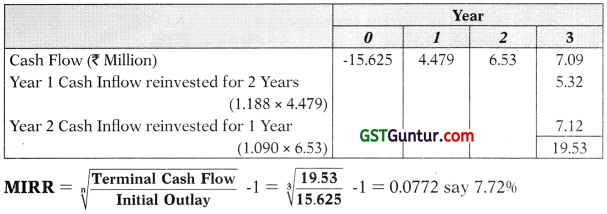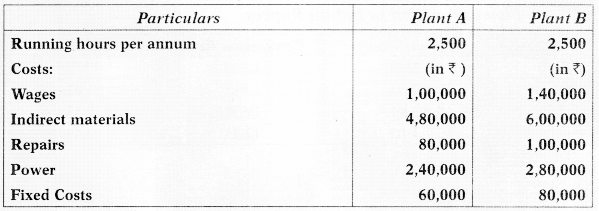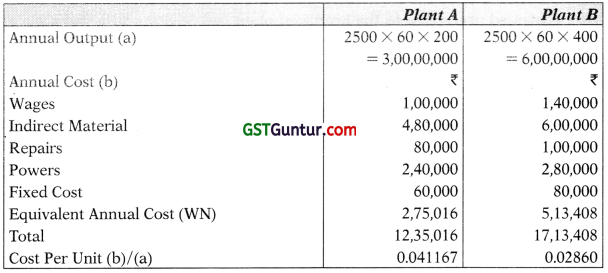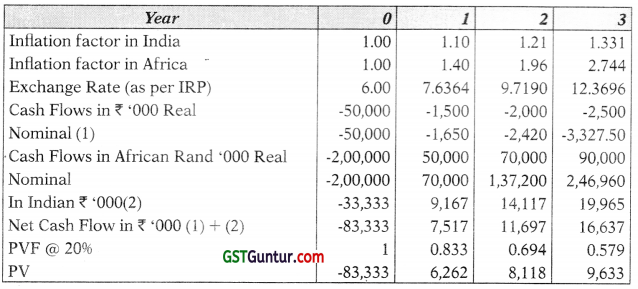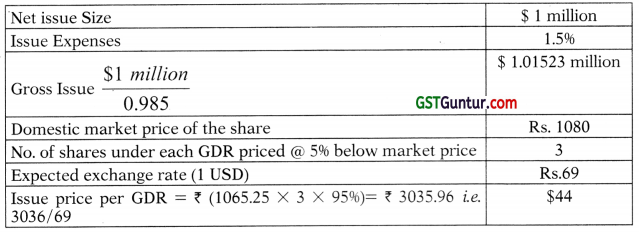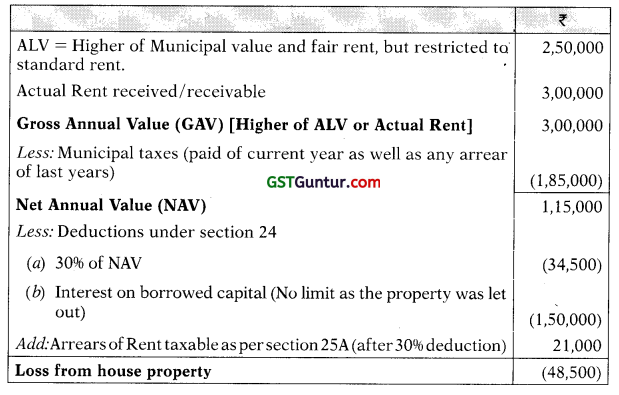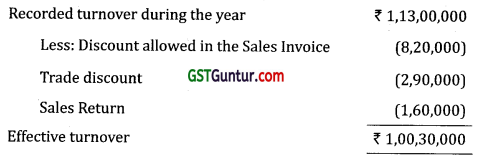Profits and Gains of Business or Profession – CA Final DT Question Bank is designed strictly as per the latest syllabus and exam pattern.
Profits and Gains of Business or Profession – CA Final DT Question Bank
Question 1.
Explain in brief, the treatment as to the taxability and/or allowability, under the provisions of Income-tax Act, 1961:
‘C’ Ltd., which did not have any active business carried on by it incurred capital expenditure on scientific research amounting to ₹ 5,00,000 that related to its subsidiary companies. [CA Final May 2010] [3 Marks]
Answer:
As per section 35(1)(iv), deduction in respect of capital expenditure on scientific research shall be allowed only if the scientific research relates to the business carried on by the assessee.
However, in the given case, ‘C’ Ltd., did not have any active business carried on by it to which the said scientific research related to. The capital expenditure incurred by ‘C’ Ltd. related to its subsidiary companies and therefore, ‘C’ Ltd. is not eligible for deduction.

Question 2.
Indian Gas Limited commenced its operation of the business of laying and operating a cross country natural gas pipeline network for distribution on 1st July, 2019. The company incurred capital expenditure of ₹ 300 lakhs (including cost of land ₹ 45 lakhs and cost of financial instrument ₹ 5 lakhs) during the period from 1st April, 2018 to 30th June, 2019. The company did not claim deduction for such expenditure in the earlier assessment years. The entire expenditure was capitalised on 1st July, 2019. Further, during the previous year 2020-21, the company incurred capital expenditure of ? 200 lakhs exclusively for the said business.
(i) Compute the amount of deduction allowable under section 35AD assuming that the company has fulfilled all the conditions specified in section 35AD.
(ii) If the company has loss from such business in the assessment year 2021-22, how the same is to be set off and carried forward? [CA Final May 2010] [6 Marks]
Answer:
(i) As per Sec. 35AD, where the assessee commences the business of laying and operating a cross-country natural gas or crude or petroleum pipeline network for distribution, including storage facilities, he shall be eligible for, if it has opted, 100% of the capital expenditure incurred during the previous year, wholly and exclusively for the above business as deduction from the business income. However, expenditure incurred on acquisition of any land, goodwill or financial instrument would not be eligible for deduction.
If the capital expenditure is incurred before commencement of such specified business, then deduction shall be
allowed in the year of commencement provided such expenditure is capitalized in books of account on the date of commencement.
Therefore, the deduction admissible under section 3 5AD for A.Y. 2021 – 22 would be:
|
₹ in lakhs |
| Capital expenditure incurred during the previous year 2020-21
Capital expenditure incurred prior to commencement of business and capitalized in the books of account on 01.07.2019 (₹ 300 lakhs – ₹ 50 lakhs i.e. cost of land and financial instrument) |
200
250 |
| Total deduction under section 35AD for A.Y. 2021.-22 |
450 |
(ii) As per Sec. 73A, loss in respect of the specified business shall be set off only against profits and gains of any specified business and the unabsorbed loss can be carried forward indefinitely and restriction ‘ of carry forward of loss for 8 assessment years is not applicable.

Question 3.
Aditya, Avirup and Avigyan carried on business of running hotels in partnership from 1st April, 2011 to 31st March, 2018. In order to increase its scale of operation and meet its fund requirement, the firm decided to carry on its business through corporate route. For that purpose, a company under the name and style “Triple A Hospitality Private Limited” was formed on 1st April, 2019 and the business of the partnership firm as a whole was succeeded to by the company with effect from 1st June, 2019.
The company’s profit and loss account for the year ended 31 st March, 2021 shows a net profit of ₹ 450 lakhs after debit/credit of the following items:
(i) Interest of t 3 lakhs paid to Allahabad Bank on a term loan taken for the purpose of acquiring a land at Bhubaneswar for a new hotel to be set up.
(ii) Depreciation charged ₹ 40 lakhs.
(iii) ₹ 2 lakhs credited on account of waiver of dues obtained from a supplier of the erstwhile firm against supply of certain materials.
(iv) ₹ 1.18 lakhs being the aggregate of amounts paid in cash to Rajaram, a transport contractor as follows:
Date of Payment – ₹ in lakhs
5th June, 2020 – 15,000
20th July, 2020 – 21,000
20th September, 2020 – 22,000
3rd November, 2020 – 26,000
5th November, 2020 – 36,000
Tax was not deducted at source as Rajaram submitted a certificate u/s 197(1) which he had obtained from the TDS circle of the Income-tax Department. .
(v) ₹ 0.50 lakh, being proportionate part of the cost of animals (purchased and kept for entertainment of the guests of hotel) amortised as per the accounting policy of the company.
(vi) ₹ 0.10 lakhs credited on account of sale proceeds of carcass of animal which died during the year.
(vii) Provision for bad and doubtful debts ₹ 12 lakhs.
(viii) Payment of ₹ 25 lakhs to some employees as compensation for voluntary retirement, as per scheme

Other Information:
(i) Depreciation as per the Income-tax Act, 1961 ₹ 65 lakhs.
(ii) Cost of animal died as referred to in (f) above was ₹ 2 lakhs.
(iii) Debt of ₹ 4 lakhs due from one corporate customer for three months I has been written off during the year after giving few reminders by debiting provision for bad and doubtful debts account.
(iv) The erstwhile firm was allowed exemption of ₹ 50 lakhs u/s 47(xiii) in respect of long-term capital assets transferred to the company.
(v) The company’s voting rights till 31st March, 2020 were held as follows:
Aditya – 40%
Avirup – 30%
Avigyan – 15%
Others – 15%
During the year, shares constituting 36% voting rights were sold by Aditya to his son-in-law, Avishek.
(vi) Unabsorbed business loss and unabsorbed depreciation of ? 10 lakhs each have been carried forward from Assessment Year 2019-20.
(vii) The company has a subsidiary company, Tours & Travels Private Limited (a closely held company). During the year, the company obtained a temporary loan of ₹ 12 lakhs from its subsidiary company. Accumulated profit of the subsidiary company was ₹ 30 lakhs at the time of payment of the loan. The loan was repaid by the company before the end of the year.
Compute total income of Triple A Hospitality Private Limited for the A.Y. 2021-22 indicating reason for treatment of each of the items. Ignore the provisions relating to minimum alternate tax. [CA Final May 2010] [20 Marks]
Answer:
Computation of Total Income of Triple A Hospitality (P) Ltd. for the A.Y. 2021-22
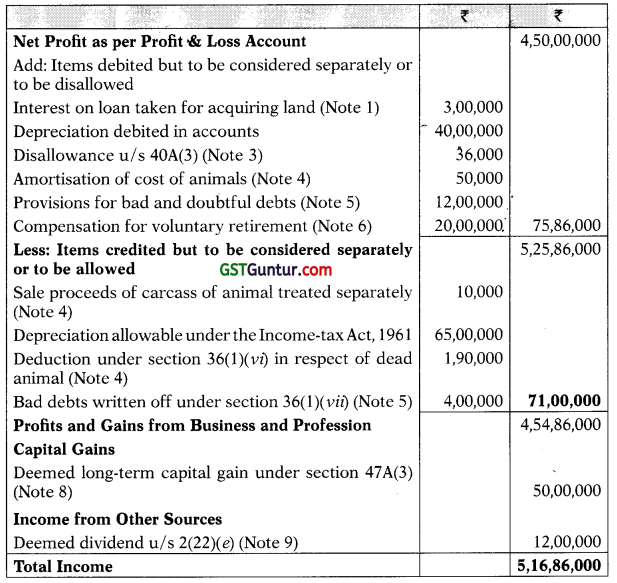
Notes:
(1) As per proviso to section 36(1)(iii), interest paid in respect of capital borrowed for acquisition of an asset (whether capitalized in the books of account or not) for the period till the date on which such asset is first put to use shall not be allowed as deduction. Since, the land is yet to be put to use, deduction for interest is not allowable.

(2) As per Sec. 41(1), where any trading liability was allowed as deduction to the predecessor-firm and the successor has obtained some benefit by way of remission or cessation of such trading liability, such benefit obtained by the successor shall be deemed to be profits and gains of business or profession and would be chargeable to tax in the year in which the benefit accrued. In this case, waiver of ? 2,00,000 obtained from the supplier of the predecessor firm shall be deemed as business income of the assessee company. Since the amount is already credited to profit and loss account, no adjustment is necessary.
(3) As per Section 40A(3), where the assessee incurs any expenditure for which a payment or aggregate of payments made to a person in a single day, otherwise than by account payee cheque or account payee bank draft or use of ECS through a bank account or through such other electronic mode as may be prescribed, exceeds ₹ 10,000, no deduction shall be allowed in respect of such expenditure.
However, if the payment is made for plying, hiring or leasing goods carriages, then limit is ₹ 35,000 instead of ₹ 10,000. In this case, only the amount paid to Rajaram, a transporter on 5th Nov, 2020 exceeds ₹ 35,000 and therefore, ₹ 36,000 shall be disallowed and shall be added’ back.
Since, Rajaram has submitted a certificate u/s 197(1), no taxis required to be deducted and sec. 40(a)(id) shall not be attracted.
(4) As per Sec. 3 6( 1)(vi), in respect of animals which have been used in the business or profession, otherwise than as stock-in-trade, the difference between the actual cost of the animals and the amount, if any, realized in respect of the animals or carcasses shall be allowed as deduction in the year when they die or become permanently useless.
Therefore, ₹ 50,000 debited to profit and loss account has to be added back and ₹ 10,000 credited to profit and loss account has to be deducted. The difference between the cost of animal died (₹ 2 lakh) and the sale proceeds of carcasses (₹ 0.10 lakh) is allowable as deduction u/s 36(l)(vi). Therefore, ₹ 1,90,000, is allowable as deduction u/s 36(1)(vi).
(5) Provision for bad and doubtful debts is allowable as deduction u/s 36(1)(viia) only in the case of specified banks and financial institutions. Therefore, a company engaged in hotel business is not eligible for deduction in respect of provision for bad and doubtful debts and accordingly, ₹ 12 lakh, debited to profit and loss account has to be added back.
A bad debt written off is allowed as deduction u/s 36(1 )(vii) if such debt is written off as irrecoverable in the books of account. Therefore, the amount of ₹ 4 lakhs written off during the year by debiting provision for bad and doubtful debts is allowable as deduction u/s 36(1)(vii).
(6) As per section 35DDA, where in any previous year, any expenditure is incurred in connection with voluntary retirement of any employee, 1 /5th of the amount so paid shall be deducted in computing profits and gains of business for that previous year, and the balance shall be deducted in four equal instalments in the immediately succeeding four previous years. Therefore, out of ₹ 25,00,000, ₹ 5,00,000 is deductible in assessment year 2021-22 and the balance of ₹ 20 lakhs shall be added back.

(7) As per Sec. 47A(3), where any of the conditions laid down in proviso to Sec. 47(xiii) are not complied with, the capital gains which was not charged to tax u/s 45 earlier shall be chargeable to tax in the hands of the successor company for the previous year in which the requirements of the proviso to Sec. 47(xiii) are not complied with.
In this case, before the expiry of 5 years fronTthe date of succession, Aditya sold shares carrying 36% voting rights to his son-in-law which reduces the aggregate of shareholding of the partners in the company to below 50% of the total voting power in the company. Therefore, the long-term capital gain which was not charged to tax in the hands of the firm in the year of succession shall be deemed to be long term capital gain of the assessee company in the A.Y. 2021-22.
(8) As per Sec. 2(22)(e), where any company, in which public are not sub-stantially interested, makes any payment by way of loan or advance, to the extent of accumulated profits of the company, to any shareholder holding beneficial ownership of shares carrying not less than 10% of the voting power, then such loans or advances shall be treated as deemed dividends. As per the amendment made by the Finance Act, 2020, dividends including deemed dividends are taxable in the hands of shareholders. Therefore, ₹ 12,00,000 shall be the deemed dividend taxable in the hands of Triple A Hospitality Pvt. Ltd. under the head ‘Income from Other Sources’.
(9) As per Sec. 72A(6), accumulated loss and depreciation of the predecessor firm would become the loss and depreciation of the successor company of the previous year in which the conversion takes place provided the conditions laid down in section 47(xiii) are fulfilled. In this case, the conditions are fulfilled in the P.Y. 2019-20 and it appears that the assessee-company did not have sufficient profits during the P.Y. 2019-20, against which the brought forward loss and unabsorbed depreciation can be set-off and for this reason, the same has been carried forward to the P.Y. 2020-21.
However, in the P.Y. 2020-21, one of the conditions as per the proviso to Sec. 47(xiii) is not satisfied i.e. aggregate shareholding of erstwhile partners falls below 50%, and therefore, the business loss and unabsorbed depreciation cannot be set-off.

Question 4.
Della Limited is engaged in manufacturing pipes and tubes. The profit and loss account of the company for the year ended 31st March, 2021 shows a net profit of ₹ 405 lakhs. The following information and particulars are furnished to you. Compute the total income of the company for Assessment Year 2021-22 indicating reasons for treatment of each item.
(i) A group free air ticket was provided by a supplier for reaching a certain volume of purchase during the financial year 2020-21. The same is encashed by thfe company for ₹ 10 lakhs in April 2021.
(ii) A regular supplier of raw materials agreed for settlement of ₹ 8 lakhs instead of ₹ 10 lakhs for poor quality of material supplied during the previous year which was not given effect in the running account of the supplier.
(ii) Andhra Bank sanctioned and disbursed a term loan in the financial year 2017-18 for a sum of ₹ 50 lakhs. Interest of ₹ 8 lakhs were in arrears. The bank has converted the arrear interest into a new loan repayable in ten equal instalments. During the year, th6 company has paid two instalments and the amount so paid has been reduced from Funded Interest in the Balance Sheet.
(iv) The company remitted ₹ 5 lakhs as interest to a company incorporated in USA on a loan taken two years ago. Tax deducted under section 195 from such interest has been deposited by the company on 15th July, 2021. The said interest was debited to profit and loss account.
(v) Liquidated damage of ₹ 3 lakhs received from KS Limited for delay in supply of plant and machinery has been shown under the head “Other income” in Profit & Loss Account.
(vi) Sandeep, a sales executive stationed at HO at Delhi, was on official tour in Bangalore from 31st May, 2020 to 18th June, 2020 and 28th September, 2020 to 15th October, 2020 for the business development. The company has paid Sandeep’s salary in cash, from its local office at Bangalore for the month of May, 2020 (payable on 1st June) and September 2020 (payable on 1st October), amounting to ₹ 25,000 and ₹ 27,000 respectively (net of TDS and other deduction), as Sandeep has no bank account at Bangalore. These were included in the amount of “salary” debited to Profit and Loss Account.
(vii) The company has taken up initiative to restructure its debt and paid ₹ 20,000 to a finance company, M/s ABC Ltd., towards pre-payment premium. As per the scheme, ₹ 50,000 loans was waived against its loan and Della Limited directly credited it to its reserve account, considering loan waiver amount as capital receipt.

(viii) The company has contributed ₹ 50,000 by cheque to an electoral trust and the same stands included under the head “General Expenses”. [C4 Final Nov. 2010] [10 Marks]
Answer:
Computation of total income of Della Ltd. for the A.Y. 2021-22

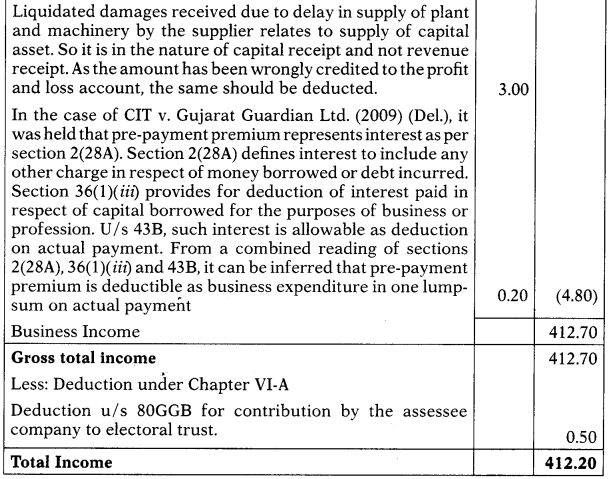
Notes:
Since the question is silent as to whether the net profit of ₹ 405 lakhs is after taking into account the adjustments in (i) to (viii), the problem has been worked out on the assumption that except for items (iv), (v) (vi) and (viii) in respect of which there is a specific mention about inclusion, all other adjustments i.e. (i), (ii), (iii) and (viz) have not been given effect to in the profit and loss account.

1. Tax deducted by the assessee on interest payable outside India to a foreign company is deposited within the time limit under section 139(1) is not disallowed [Section 40(a)(i)].
2. Salary paid to sales executive in cash is not disallowable as he was temporarily posted for a continuous period of more than 15 days in Bangalore, not being the place of his normal duty, tax was deducted from such salary u/s 192 and he does not maintain any bank account in Bangalore. Therefore, no disallowance u/s 40A(3) is attracted in respect of such salary as per Rule 6DD.
3. Remission of principal amount of loan does not amount to income u/s 41(1) or u/s 28(iv), where there is a waiver of loan taken from a bank or financial institution, unless the loan is taken for a trading activity. It is assumed that such loan is not taken for a trading activity and therefore, waiver of loan cannot be treated as income.
Question 5.
ITP Limited is engaged in growing and manufacturing tea in India. It commenced its operation from 1st April, 2020. It acquired plant and machinery, factory building and furniture at cost of ₹ 40 lakhs, ₹ 25 lakhs and ₹ 10 lakhs, respectively, in the P.Y. 2020-21. All the assets were put to use for more than 180 days during 2020-21. Compute the written down value of each block of assets as on 1st April, 2021, [CA Final Nov 2010] [3 Marks]
Answer:
As per Rule 8 of the Income-tax Rules, 1962, only 40% of income from business of growing and manufacturing of tea in India is deemed to be income liable to tax. The balance 60% would be agricultural income, which is not chargeable to tax.
As per Explanation 7 to section 43(6), in cases of composite income, for the purpose of computing WDV of assets acquired before the previous year, the total amount of depreciation shall be computed as if the entire composite income of the assessee is chargeable to tax under the head “Profits and § gains of business or profession”. The depreciation so computed shall be § deemed to have been “actually allowed” to the assessee.
Therefore, even if only 40% of ITP Ltd.’s income from sale of tea grown and manufactured in India is taxable, full depreciation (and not 40%) should be taken as “actually allowed” for the purpose of computing’WD V. Accordingly, the WDV of each block as on 1st April 2021 will be as follows:
Plant & Machinery = ₹ 40 lakhs – ₹ 6 lakhs (15% of 40 lakhs) = ₹ 34 lakhs; Building (Factory) = ₹ 25 lakhs – ₹ 2.50 lakhs (10% of 25 lakhs) = ₹ 22.50 lakhs; Furniture = ₹ 10 lakhs – ₹ 1 lakh (10% of 10 lakhs) = ₹ 9 lakhs.

Question 6.
Can brought forward losses and unabsorbed depreciation be set off against the profit determined u/s 44B? [CA Final May 2011] 4 Marks]
Answer:
Sec. 44B provides that notwithstanding anything contained in Secs. 28 to 43A, in case of a non-resident engaged in the business of operation of ships, a sum equal to 7.5% of
(a) The amounts paid or payable whether in or out of India to the assessee, on account of carriage of passengers, livestock, mail or goods shipped at any port in India, and
(b) Any amount received or deemed to be received in India by or on behalf of the assessee, on account of carriage of passengers, livestock, mail or goods shipped at any port outside India, shall be deemed to be the profit of such business.
Sec. 44B overrides Secs. 28 to 43A and therefore it overrides sec. 32 which deals with the unabsorbed depreciation. So, the unabsorbed depreciation cannot be set-off against the income deemed u/s 44B.
However, it does not override Chapter VI which relates to carry forward and set off of brought forward losses and therefore, the brought forward business losses can be set off against the income determined u/s 44B.

Question 7.
X Co. Ltd. was amalgamated with Y Co. Ltd. on 30.04.2020. X Co. Ltd. was engaged in real estate whereas Y Co. Ltd. was engaged in manufacture of textile articles. Y Co. Ltd. on amalgamation altered its objects clause of Memorandum of Association, to carry on real estate business.
The stock in trade of X Co. Ltd. (being vacant lands) was taken over at ₹ 140 lakhs by Y Co. Ltd. as against their original cost of ₹ 125 lakhs to X Co. Ltd. for the purpose of amalgamation. Y Co. Ltd incurred ₹ 25 lakhs towards development of those lands obtained on amalgamation. It sold the entire land for ₹ 160 lakhs during the year ended 31.03.2021. Determine the tax implication of the transaction in hands of Y Co. Ltd. for the assessment year 2021-22. [CA Final May 2011] [4 Marks]
Answer:
In this case, since the stock-in-trade of X Co. Ltd. is taken over by Y Co. Ltd. on amalgamation, the provisions of section 43C are attracted and the cost of acquisition of vacant lands to Y Co. Ltd. (the amalgamated company) will be ₹ 125 lakhs, being the original cost of such lands to X Co. Ltd., the amalgamating company.
Since the amalgamated company i.e. Y Ltd. has altered its object clause so as to include real estate business, it is clear that the vacant land which were hitherto stock-in-trade for the amalgamating company continues to be in the nature of stock-in-trade for Y Ltd. Thereby, the provisions of section 45(2) i.e. conversion of capital asset into stock-in-trade is not attracted in this case.
Business income of Y Co. Ltd. on sale of such lands would be calculated as under:

Question 8.
XYZ Private Limited is engaged in manufacturing and selling ceramic tiles. The net profit of the company as per its profit and loss account for the year ended 31st March, 2021 is ₹ 150 lakh after debiting or crediting the following items:
(i) One-time license fee of ₹ 20 lakh paid to a foreign company for obtaining franchise on 1st June, 2020.
(ii) ₹ 29,000 paid to A & Co., a goods transport operator, in cash on 31st January, 2021 for distribution of the company’s products to its warehouse.
(iii) Rent of ₹ 6 lakh received from letting out a part of its office premises. Municipal tax in respect of the said part of the building amounting to ₹ 15,000 remains unpaid.
(iv) ₹ 2 lakh, being contribution to a University approved and notified u/s 35(1)(ii).
(v) ₹ 3 lakh, being loss due to destruction of a machinery caused by a fire due to short circuit. The Insurance Company did not admit the claim of the company.
(vi) ₹ 4 lakh and ₹ 1 lakh, being amounts waived by a bank out of principal and arrear interest, respectively, in an one-time settlement. The loan was obtained for meeting working capital requirement four years back.
(vii) ₹ 1 lakh, being amount payable to a contractor (who does not have Permanent Account Number) for repair work at the company’s factory. Tax of ₹ 2,000 was deducted and paid in time.
(viii) Depreciation on tangible fixed assets ₹ 1 lakh.

Additional Information:
(i) Depreciation on tangible fixed assets as per Income-tax Rules ₹ 1.75 lakh.
(ii) The company has obtained a loan of ₹ 2 lakh from ABC Private Limited in which it holds 16% voting rights. The accumulated profits of ABC Private Limited on the date of receipt of loan was ₹ 0.50 lakh.
Compute total income of XYZ Private Limited for the Assessment Year 2021-22 indicating reasons for treatment of each item. Ignore the provisions relating to minimum alternate tax. [CA Final Nov. 2011] [16 Marks]
Answer:
Computation of total income of XYZ Private Ltd. for the A.Y. 2021-22

Notes:
(1) Rental income from letting out a part of the office premises is taxable under income from house property”. Therefore, it has to be deducted while calculating business income, since the income has been credited to profit and loss account. Likewise, municipal taxes due in respect of such property, debited to profit and loss account has to be added back to compute business income.

(2) Franchise is an intangible asset eligible for depreciation @ 25%. Since one-time licence fees of ₹ 20 lakh paid to a foreign company for obtaining franchise has been debited to probt and loss account, the same has to be added back. Depreciation @ 25% has to be provided in respect of the intangible asset since it has been used for more than 180 days during the year.
(3) ₹ 29,000 paid to A & Co., a goods transport operator in cash is deductible while computing business income, since the limit above which disallowance u/s 40A(3) would be attracted in case of payment to a transport contractor engaged in the business of plying, leasing goods carriages is ₹ 35,000.
(4) Contribution to a university approved and notified u/s 35(1)(n) is eligible for deduction of 100% from P.Y. 2020-21. Therefore, since the contribution of ₹ 2,00,000 already been debited to profit and loss account, no adjustment is required. Loss of ₹ 3 lakh due to destruction of machinery caused by fire is not deductible since, it is capital in nature.
(6) Non-furnishing of PAN to deductor results in attracting provisions of section 206AA, which require tax to be deducted at a higher rate of 20%. Since, the company has deducted tax @ 2% and not @ 20% as per the requirement u/s 206AA, disallowance u/s 40(a)(ia) would be attracted @ 30% in respect of payment of ₹ 1 lakh made to contractor i.e. ₹ 30,000.
Note: There is a possibility of alternate views regarding the tax treatment of disallowance u/s 40(a)( ia) for short-deduction of tax. It is possible to take a view that only proportional disallowance u/s 40(a) (ia) would be attracted in such a case. Another view is that disallowance u/s 40(a)(za) is only for non-deduction of tax at source and not short-deduction of tax and therefore, no disallowance should be made in case of short-deduction of tax. The computation of total income would, accordingly, change.
(7) Depreciation as per Income-tax Rules, 1962, is deductible while calculating business income. Therefore, depreciation of ₹ 1.75 lakh on tangible fixed assets and ₹ 5 lakh on intangible assets shall be deducted and ₹ 1 lakh shall be added back.
(8) Since, the loan is for meeting working capital requirement, it shall be the trading activity and the waiver of principal amount of loan taken for trading activity is a benefit in respect of a trading-liability by way of remission or cessation thereof and is, hence, taxable u/s41(1). Since, the loan waiver has already been credited to profit and loss account, no adjustment is required.
However, the treatment is different in respect of interest on loan. Since, interest on such loan would have not been allowed as deduction in the earlier years as per section 43B due to non-payment of such interest, waiver of interest will not be taxable. Since ₹ 1,00,000 representing interest waiver has already been credited to profit and loss account, the same has to be deducted for computing business income.
(9) As per Sec. 2(22)(e), any advance or loan given by a closely held company, to the extent of accumulated profits of the company, to a share-holder, being the beneficial owner of shares, carrying not less than 10% of voting power, shall be treated as deemed dividends in the hands of shareholder. In this case, XYZ Pvt. Ltd holds 16% voting rights in ABC Pvt. Ltd and therefore, out of the advance of ₹ 2,00,000 obtained from ABC Pvt. Ltd, ₹ 50,000 being the amount upto the accumulated profits of ABC Pvt. Ltd., shall be treated as deemed dividend u/s 2(22)(e) in the hands of XYZ Pvt. Ltd. and shall be taxable under the head ‘Income from ‘Other Sources’.

Question 9.
S Ltd. engaged in the business of manufacturing, having turnover of ₹ 244 crores for the previous year 2018-19 and net profit of ₹ 115 crores for the financial year ended 31.3.2021, after debiting Crediting following items:
(i) On EPABX and mobile phones (exclusively used for the business purpose) purchased during the year, depreciation amounting to ₹ 18 crores was claimed at higher rate of 40% treating them at par with computer.
(ii) ₹ 50 crores paid to N Ltd, towards feasibility study conducted for examining proposals for technological advancement relating to the existing business. The project was abandoned without creating a new asset.
(iii) ₹ 35 crores paid for the higher studies of the director’s son abroad, with a stipulation that he would be appointed as a trainee in the company under ‘apprentice training scheme where there is no evidence of existence of such scheme.
(iv) Payment of ₹ 29 crores towards purchase of software from a non-resident, meant for subsequent resale in the Indian market (no tax deducted at source), was ultimately sold at a profit during’ the year 2020-21.
(v) Dividend of ₹ 10 crores received from a foreign company in which this company holds 28% in nominal value of the equity share capital of the company, ₹ 0.25 crore expended on earning this income.
(vi) A machine in use since past 7 financial years having WDV amounting to ₹ 1.50 crores on 01.04.2019 was discarded on 3.9.2020. The depreciation on the block at 15% has been provided and charged to profit and loss account for the previous year ended 31.3.2021. The entire block is used for the purpose of business.
(vii) ₹ 45 crores were paid on 3.6.2020 to a National Laboratory with a stipulation that the said contribution shall be used for the purpose of an approved scientific research programme only.
(viii) Secret commission of ₹ 13 crores was paid and debited under commission account.

Additional Information:
A debt of ₹ 10 crores was claimed as bad debt in the previous year 2019-20. Assessing Officer allowed only a sum of ₹ 5 crores as bad debts. In 2020-21, a sum of ₹ 4 crores is recovered ultimately in respect of the debt.
Compute total income of S Ltd. for the Assessment Year 2021-22 and work out tax payable on such income, indicating reasons for treatment of each item. [CA Final May 2012] [16 Marks]
Answer:
Computation of total income of S Ltd. for the 4-Y. 2021-22 (₹ in crores)
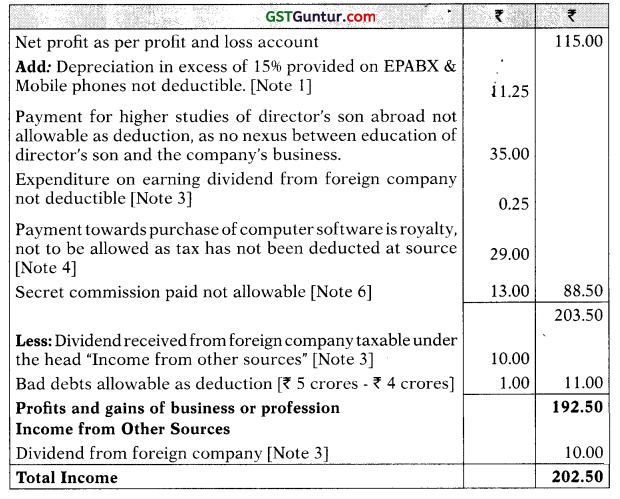
Tax liability of S Ltd. for the A.Y. 2021-22
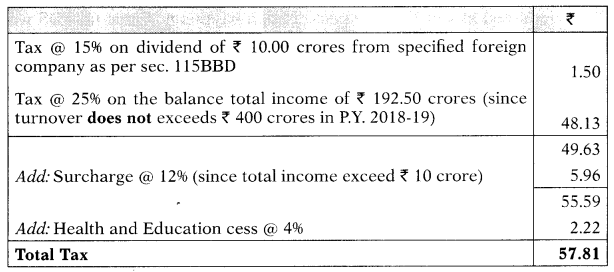
Notes:
1. EPABX and mobile phones are not computers and therefore, are not entitled to higher depreciation @ 40% as for computers [Federal Bank Ltd. v. ACIT (Ker)]. Hence, normal depreciation @15% shall be allowed.

2. As per Delhi High Court in case of Priya Village Roadshows Ltd. it was held that if there is no creation of a new asset, then the expenditure incurred on feasibility study for the technological advancement of the project which was abandoned without creating a new asset, would be of revenue nature.
As the expenditure is already debited to profit and loss account, no further treatment is required.
3. As per sec. 115BBD, dividends received by Indian companies from Specified foreign company i.e. foreign company in which the Indian company holds 26% or more of the nominal value of equity share cap-ital, shall be taxable @ 15%. Also, no expenditure in respect of earning such income shall be available.
Further, as per section 56(2) dividend income is taxable only under the head ‘Income from other sources’.
In this case, as S Ltd. holds 28% of equity in foreign company, section 115BBD shall be attracted and therefore, expenditure debited on earning such dividend shall be added back.
Note: If the S Ltd. had distributed dividends during the previous year, then it may claim deduction u/s 80M in respect of such dividends received from specified foreign company upto the amount of dividend distributed by it.
4. Section 9(1)(vi) provides that the consideration for use or right to use of computer software is royalty and consequently tax has to be deducted at source in respect of such payments. Since no TDS was deducted, ₹ 29 crores is to disallowed under section 40(a)(i).
5. Contribution to a National Laboratory shall be eligible for 100% de-duction. Since, it has already been debited to profit and loss account, no further adjustment is required.
6. With regard to the discarded machine, no amount has been adjusted in block of asset as no money is receivable in respect of discarded machine. Thus, depreciation would be allowed assuming that there are other assets in the block.
7. As per Explanation to section 37(1) any expenditure incurred for a purpose which is an offence or which is prohibited by law, shall not be deemed to have been incurred for the purposes of business or profession and no deduction or allowance shall be made in respect of such expenditure. Therefore, secret commission being in the nature of bribe is not allowable as expenditure.

Question 10.
KLM limited has gone for pension scheme referred to in section 80CCD. It contributes 20% of basic salary to the account of each employee under the scheme. Dearness allowance paid is 40% of basic salary. 50% of dearness allowance forms part of pay for retirement benefits. Total basic salary of employees during the year ended 31st March, 2021 amounted to ₹ 100 lakhs. You are a finance executive of the company and get a basic salary of ₹ 20,000 per month and contribute 20% of basic salary to the pension scheme. On these facts:
(i) Compute the amount admissible as deduction u/s 36(1)(iva) and the amount inadmissible u/s 40A(9) in computation of business income of KLM Limited.
(ii) Explain the tax treatment. [CA Final Nov. 2012] [5 Marks]
Answer:
(i) Computation of deduction allowable u/s 36(1)(iva) and disallowance u/s 40A(9) while computing business income of KLM ltd. ‘
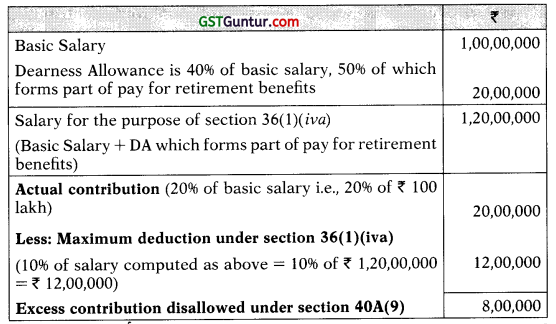
(ii) Tax treatment in the hands of the finance executive in respect of employer’s and own contribution to pension scheme referred to in section 8OCCD.
(a) Own contribution to pension scheme is allowed as deduction u/s 8OCCD maximum upto 10% of salary. For this purpose, basic salary means basic salary plus dearness allowance, if it forms part of salary for retirement benefits. Therefore, salary for the purpose of deduction u/s 8OCCD, in this case, would be:

(as against actual contribution of ₹ 48,000, being 20% of basic salary of ₹ 2,40,000)
₹ 28,800 is deductible u/s 80CCD(1), subject to the overall limit of ₹ 1,50,000 u/s 80CCE. The balance of ₹ 19,200 (₹ 48,000 – ₹ 28,800) can be claimed as deduction u/s 80CCD(1B) as this deduction is available over and above the deduction claimed u/s 80CCD(1) and is also outside the limit of ₹ 1,50,000 as provided in section 80CCE.
(b) Employer’s contribution to pension scheme would be treated as salary as per the definition of “salary” u/s 17. Therefore, ₹ 48,000, being 20% of basic salary of ₹ 2,40,000, will be included in salary.
Deduction allowable in respect of employer’s contribution u/s 80CCD(2) shall be restricted to 10% of salary (i.e. ₹ 28,800).
However, this deduction of employer’s contribution of ₹ 28,800 to pension scheme would be outside the overall limit of ₹ 1.50 lakh u/s 80CCE i.e., this deduction would be over and above the other deductions which are subject to the limit of ₹ 1.50 lakh.

Question 11.
XYZ Limited purchased a machine on 1st April, 2020 for ₹ 10 crores by availing 70% loan facility from bank. The machine was required for extension of the business of the company and was put to use into effective production on 1st February, 2021. Interest on loan is charged at 12% per annum.
Advise XYZ Limited on the treatment of interest payment made on this loan and depreciation allowable for the Assessment Year 2021 -22. Assume that this machine is the only machine in the related block of assets. [CA Final Nov. 2012] [4 Marks]
Answer:
Treatment of Interest on loan for purchase of machinery:
As per section 36(1)(iii), interest paid in respect of capital borrowed for acquisition of an asset for the period beginning from the date of borrowing of loan for acquiring the asset till the date on which such asset is first put to use is not allowable as deduction. Interest for such period has to be capitalized, by adding the same to the cost of the as,set. Therefore, interest @12% p.a. for the period of 10 months from 1 st April, 2020 to 31 st January, 2021 on ₹ 7 crores, being the amount of loan, has to be capitalized.


Question 12.
P. Ltd. has two divisions, engineering division and tea division. It has transferred engineering division to Q. Ltd. pursuant to a scheme of demerger which satisfies the conditions of section 2(19AA). P. Ltd had a debt of ₹ 5 lakhs in engineering division which stood transferred to Q. Ltd. The said debt has been written off as bad in the accounts of 0 Ltd. Can Q. Ltd. claim deduction on account of the bad debt? [CA Final Nov. 2012] [4 Marks]
Answer:
In the case of CIT v. T Veerbhadra Rao (1985), the Supreme Court held that a successor to a business will be entitled to claim an allowance for bad debt even though the debt did not relate to the business of the assessee but to the business it has succeeded. The court held that even if the relevant debt had been taken into account in computing the income of the predecessor only and had been written off as irrecoverable in the accounts of the successor assessee, the assessee will be entitled to the deduction of bad debt.
Therefore, in this case, deduction u/s 36(1)(vi) on account of bad debts of ₹ 5 lakh shall be allowed to Q. Ltd. in relation to a debt incurred by P. Ltd. for the engineering division transferred to Q. Ltd., even though the same is not taken into account in computing the income of Q. Ltd. of the current previous year or any of the earlier previous years, provided the identity of the business in the hands of Q Ltd remains the same.

Question 13.
ACFS Ltd. is a Non-Banking Financial Company (NBFC). The company has not credited interest of ₹ 25 lakhs due on certain Loan Accounts which had become Non-Performing Assets in its Profit & Loss Account. As per NBFC Prudential Norms (RBI) Direction, 1998, which is binding on the Company, Interest or Discount or any other charges on NPA shall be recognized as Income only when it is actually realized. Can the A.O. make addition of such interest on the ground that the assessee follows Mercantile System of Accounting? [CA Final Nov. 2012] [4 Marks]
Answer:
As per section 43 D, Interest on those advances which have been categorized as Bad & Doubtful Debts as per RBI Guidelines are taxable in the year in which such interest is –
(a) Credited to Profit & Loss Account or
(b) Received by the assessee,
whichever is earlier, and not on accrual basis.
Interest on NPA is to be recognized on cash basis (as permitted by RBI) even though the assessee follows mercantile system of accounting.
Such Interest Income accrues only on actual realization. [DIT v. Brahmputra Capital Financial Services Ltd (Del.)] Hence, the contention of the Assessing Officer is not valid.

Question 14.
Mr. S, a lawyer by profession, incurred expenditure on his heart surgery. He claimed such expenditure arguing that the repair of vital organ i.e. the heart has directly impacted his professional competence as his gross income from profession increased manifold after the surgery, the heart should be treated as a plant and hence such expenses should be allowed u/s 31 as current repairs to plant and machinery or section 37(1) as an expenditure incurred wholly and exclusively for the purpose of his profession. Is the claim of Mr. S tenable in law? [CA Final Nov. 2012] [4 Marks]
Answer:
The issues under consideration are whether the expenses incurred on heart surgery can be regarded as:
(a) Current repairs to plant, allowable u/s 31 or
(b) A revenue expenditure, incurred wholly and exclusively for the purposes of the assessee’s profession and hence, allowable u/s 37(1).
The facts of the case are similar to the facts in Shanti Bhushan v. CIT (2011), where the Delhi High Court observed that to allow the heart surgery expenditure as repair expenses to plant, the heart should have been first included in the assessee’s balance sheet as an asset in the previous year and in the earlier years. Also, a value needs to be assigned for the same.
The assessee would face difficulty in arriving at the cost of acquisition of such an asset for showing the same in his books of account. Though the definition of plant u/s 43(3) is inclusive in nature but the plant must have been used as a tool for profession, which is not true in case of heart. Therefore, the heart cannot be said to be plant for the business or profession of the assessee. Therefore, the expenditure on heart surgery is not allowable as repairs to plant u/s 31.
According to the provisions of section 37(1), inter alia, the said expenditure must be incurred wholly and exclusively for the purposes of the assessee’s profession. However, a healthy heart will increase the efficiency of human being in every field including its professional work. Therefore, there is no direct nexus between the expenses incurred by the assessee on the heart surgery and his efficiency in the professional held. Therefore, the claim for allowing the said expenditure u/s 37(1) is also not tenable.
Therefore, applying the rationale of the above court ruling to the case on hand, the claim of S is not tenable in law.

Question 15.
Rolla Ltd. was engaged in the business of manufacturing and trading activities. The company was declared a sick industrial company and as a part of a restructuring programme, a part of the term loan for purchase of machinery and cash credit and interest was waived. The A.O. was of the view that the waiver of loans and interest amounted to remission or cessation of liability and was taxable u/s 41(1). Give your views on the correctness of the action of the A.O. [CA Final May 2013] [4 Marks]
Answer:
The term loan taken for purchase of machinery is not a trading liability. Therefore, the provisions of deemed profits u/s 41(1) cannot be applied in this case; since the waiver is in respect of a term loan taken for a capital asset and hence, cannot be treated as remission or cessation of a trading liability. Thus, the waiver of such term loans cannot be treated as income of Rolla Ltd.
However, such waiver of loan amounts to meeting of cost of asset directly or indirectly by any person other than the assessee and therefore will go to reduce the actual cost of plant and machinery as per section 43(1).
Further, where the loan is written off in the cash credit account, the benefit is in the nature of remission of a trading liability as the money had been borrowed for regular business operations. Thus, being in the nature of a revenue income, such amounts shall be treated as deemed income in the hands of R Ltd. by virtue of section 41(1). This conclusion has been drawn from the Delhi High Court decision in Rollatainers Ltd. v. CIT.
It is to be noted that interest due but not paid would not have been allowed as deduction in the earlier years or current year, on account of the provisions of section 43B. Thereby, waiver of interest on term loan is not taxable u/s 41(1).

Question 16.
The Profit & Loss Account of ST Private Limited for the year ended 31st March, 2021 shows a profit of ₹ 75 lakhs after debiting the following items. Total Turnover of ST Pvt. Ltd. for P.Y. 2018-19 is ₹ 52 crores.
(i) ₹ 2 lakhs contributed to Employees’ Welfare Trust.
(ii)₹ 12 lakhs paid towards course fee and hostel expenses for MBA course of a close relative of a director. The relative is not in employment with the company.
(iii) ₹ 3.50 lakhs, being expenses incurred on installation of a traffic signal, so as to facilitate its employees coming to office to overcome traffic jam and save office time.
(iv) ₹ 3 lakhs spent on gift items distributed to various dealers under the company’s sales incentive scheme.
(v) ₹ 6 lakhs, being expenses incurred on the travelling of the wife of MD, who accompanied him on tour to Singapore on invitation of Trade and Commerce Chamber, Singapore.
(vi) ₹ 3 lakhs, being amount paid in March 2021 consequent upon change in currency rate due to exchange fluctuation in excess of the amount due to the supplier of machinery.
(vii) ₹ 18,000 and₹ 9,000 paid in cash on 25th October, 2020 by two separate vouchers to a contractor who carried out certain repair work in the office premises.
(viii) Interest of ₹ 2 lakhs was paid in March, 2021 to a company on a loan taken from a company. Tax deducted at source from such interest was deposited in July, 2021.

Additional Information:
(a) Provision for audit fee of ₹ 6 lakhs was made in the books for the year ended 31st March, 2020 without deducting tax at source. Such fee was paid to the auditors in September, 2020 after deducting tax under section 194J and the tax so deducted was. deposited on 7th November, 2020.
(b) During the year, the company purchased 10,000 shares of.VK Private Limited at ₹ 40 per share. The fair market value of such shares on the date of transaction was f 60 per share.
Compute total income of ST Private Limited for Assessment Year 2021 – 22 and tax payable on such income indicating reasons for treatment of each item. Ignore the provisions relating to minimum alternate tax. [CA Final May 2013] [16 Marks]
Answer:
Computation of total income of Dhyan Ltd. for the A.Y. 2021-22


Computation of tax liability for A.Y. 2021-22

Notes:
1. Increase in liability due to change in currency rate and paid to the suppliers of machine shall be added to the cost of the block of asset as per section 43A and is eligible for depreciation. Hence, it should be added back to compute business income.

2. As per Gujarat State Road Transport Corporation case (2014)(Guj.), deduction for employees contribution made by the employer after the due date under the relevant Act shall be disallowed even if remitted before the due date of filing Return of Income. So, accordingly employees’ contribution to PF not remitted before the due date under the PF Act shall be disallowed.
But if the Contrary Judgments of AIMIL Ltd. and Kichha Sugar Ltd. is followed which provides that even the employees’ contribution to PF remitted after the due date under the relevant Act but before the due date of filing return of Income shall be allowed as deduction, then deduction of further ₹ 2,00,000 shall be allowed.
3. If the aggregate of payments made to a person in a single day otherwise than by an account payee cheque or account payee bank draft or use of electronic clearing system or through such other electronic mode as may be prescribed exceeds ₹ 10,000, then such whole payment shall g be disallowed as per section 40A(3). Where the payment is made for an expenditure to one person in one day, then the different vouchers are irrelevant. So, the aggregate shall be disallowed. Further, as it has not been debited to P&L A/c, it shall have no treatment.
4. As per section 56(2)(x), where the difference between the aggregate FMV of shares and the consideration paid for purchase pf such shares exceeds ₹ 50,000, then such difference shall be deemed as in the hands of person purchasing it. In this case, the company purchased 10,000 shares of VK Pvt. Ltd. at ₹ 40 per share whereas the FMV of the shares is ₹ 60 per share. Therefore the difference of ₹ 2,00,000 [(₹ 60 – ₹ 40) × 10,000 shares] shall be taxable in the hands of the company as Income from Other Sources.

Question 17.
MNO Limited is engaged in manufacturing activities. It received liquidated damages of ₹ 10 lakh from supplier of machinery due to delay in supply of machinery. State, with reasons, whether or not the income by way of liquidated damages is assessable as income from business. [CA Final Nov 2013, Nov 2011] [4 Marks]
Answer:
The issue under consideration in this case is whether the liquidated damages received by a company from the supplier of machinery for delay in supply of machinery is revenue in nature i.e., whether the same can be assessed as business income.
The Apex Court, in the case of CIT v. Saurashtra Cement Ltd. (2010), held that such liquidated damages were directly attributable to and intimately linked with the procurement of a capital asset. Therefore, it is a capital receipt in the hands of the assessee and hence not taxable under any head of income.
Applying the rationale of the above Apex Court ruling in this case, the income by way of liquidated damages of ₹ 10 lakh received by MNO Ltd. from the supplier of machinery is a capital receipt and hence, not assessable as income from business.

Question 18.
“Rameshwarm” after purchase put to use on 15.12.2018 a machine worth ₹ 3,00,000 which is eligible for depreciation (a 15%. He sold this machine to “Ganesham” on 1.1.2020 for ₹ 3,20,000 (FMV on that date was ₹ 2,50,000), who after having used the machine for his business purposes again sold it back to “Rameshwarm” on 15.11.2020 for ₹ 3,10,000.
Compute the amount of allowable depreciation and of chargeable capital gain, if any, for assessment years 2019-20 to 2021-22 assuming that this was the only machine in the block of asset held by both “Rameshwarm” and “Ganesham”. [CA Final Nov 2013] [7 Marks]
Answer:
Computation of allowable depreciation /chargeable capital gains
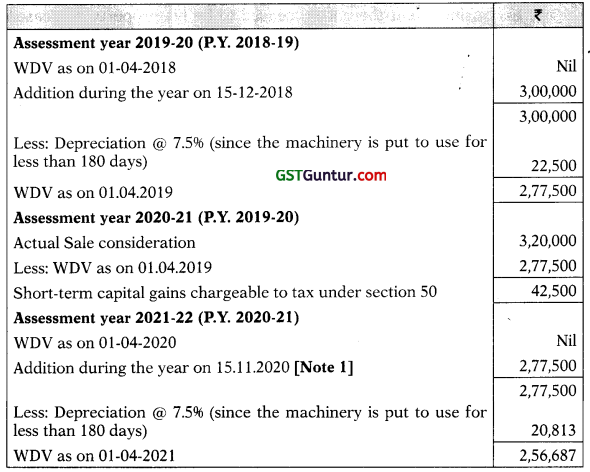
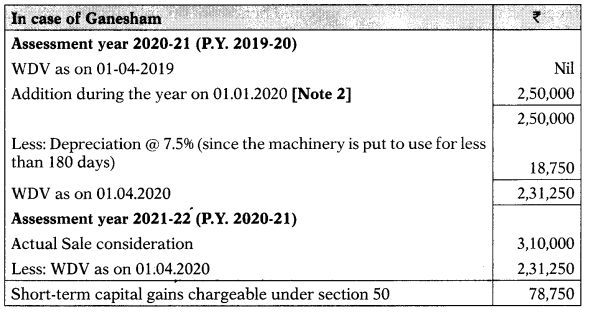

Notes:
1. As per Explanation 4 to section 43(1), where an asset which had once belonged to the assessee and had been used By him for the purpose of his business and thereafter, ceased to be his property by reason of transfer or otherwise, is reacquired by him, the actual cost to the assessee shall be lower of the following:
(a) Actual cost when he first acquired the asset minus the depreciation actually allowable to him till the date of transfer (i.e., ₹ 2,77,500, in this case); or
(b) Actual price for which it is reacquired (i.e., ₹ 3,10,000).
Therefore, in this case, the actual cost of machinery reacquired by Rameshwarm would be ₹ 2,77,500, being the lower of the two amounts given above.
2. As per Explanation 3 to section 43(1), where the assets were at any time, before the date of acquisition by the assessee, used by any other person for the purposes of business or profession and the A.O. is satisfied that the main purpose of the transfer of such assets was the reduction of his liability (by claiming excess depreciation with reference to enhanced cost), the actual cost to the assessee shall be such an amount as determined by the Assessing Officer, with the previous approval of the Joint Commissioner.
Consequently, the cost of machinery in the hands of Ganesham would be ₹ 2,50,000, assuming that the fair market value given in the question is the amount determined by the Assessing Officer, with the previous approval of the Joint Commissioner.

Question 19.
Examine the taxability or allowability or otherwise in the following cases while computing income under the head “Profits and gains from business or profession” to be declared in the return of income for the financial year ended on 31.3.2021.
(i) Amount received by A Ltd. towards power subsidy with a stipulation that the same is to be adjusted in the electricity bills.
(ii) Profit derived by an assessee engaged in carrying the business as dealers in shares on exchange of the shares held as stock-in-trade of one Company with the shares of other Company. [CA Final May 2014, May 2011][4 Marks]
Answer:
(i) Power subsidy received by A Ltd. is revenue in nature as it reduces the amount of the electricity bills. Thus, it is in the nature of compensation for the expense incurred by A Ltd. and therefore taxable as per ICDS-VII Government Grants, as ICDS is applicable to the company-assessee. Hence, the subsidy is taxable under the head PGBP.
(ii) As per ICDS VIII “Securities”, dealing with securities held as stock-in trade provides that where a security is acquired in exchange for other securities, the Fair value of the security acquired would be its actual cost for initial recognition. Subsequently, at the end of the year, the securities would be valued at lower of actual cost or NRV prevailing at the end of that year.
On exchange of shares held as stock-in-trade of a company with the shares of another company, the profit derived by the dealer in shares
i.e.
- difference between the cost of shares of the first company and the market value of shares of the new company on the date of exchange
shall be treated as business income for the dealer in the shares as derived in the normal course of his business. This was also earlier held by Supreme Court in the case of Orient Trading Co. Ltd. v. CIT.

Question 20.
Compute the quantum of depreciation available u/s 32 of the Income-tax Act, 1961 and any other benefit available in respect of the following items of Plant and Machinery purchased by PQR Textile Ltd., which is engaged in the manufacture of textile fabrics, during the year ended 31.03.2021:

The new imported machinery arrived at Chennai port on 30.03.2021 and was installed on 03.04.2021. All other items were installed during the year ended 31.03.2019. The company was newly started during the year. Also, compute the WDV of various blocks of assets.
Will your answer be different if the above assessee were a partnership firm? [CA Final May, 2014] [8 Marks]
Answer:
BLOCK of Plant and Machinery (subject to 15% depreciation)
Computation of Depreciation and the WDV as on 01.04.2020
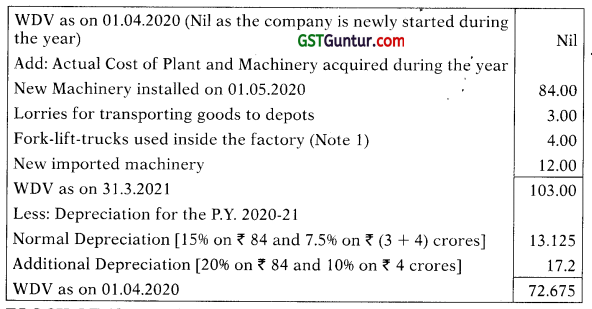
BLOCK OF Plant and Machinery (subject to 40% depreciation).
Computation of Depreciation and the WDV as on 01.04.2020
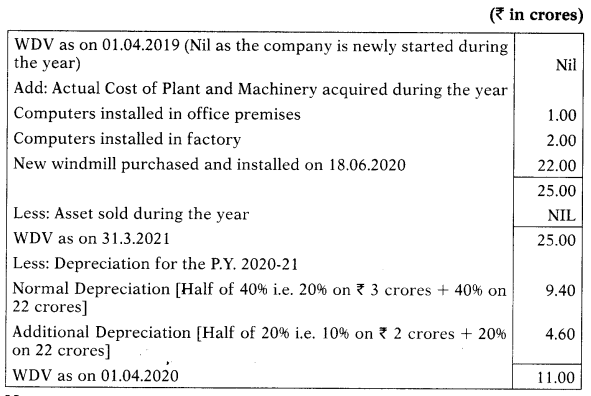
Notes:
(1) As per Motor Vehicles Act, 1988, the definition of vehicle excludes, inter alia, a vehicle of special type adapted for use only in a factory or in any enclosed premises. Therefore, fork-lift trucks used only inside the factory shall not be considered as a vehicle but as just a regular plant and machinery. Hence, it is eligible for additional depreciation under section 32(1)(iia) and deduction under section 32AC.
(2) As per the third proviso to section 32(1)(ii), the balance of additional depreciation of ₹ 0.40 crores being 50% of ₹ 0.80 crore (20% of ₹ 4.00 crore) and ₹ 0.20 crores being 50% of ₹ 0.40 crore (20% of ₹ 2.00 crore) would be allowed as deduction in the A.Y. 2022-23.

Question 21.
XYZ Ltd. is engaged in the business of manufacturing garments having turnover of ₹ 765 lakhs for the previous year 2018-19. Its P & L account shows a net profit of ₹ 500 lakhs for the year ended 31.03.2021 after debiting and crediting the following items:
Depreciation provided in accounts as per straight line basis is ₹ 30 lakhs.
Normal depreciation allowable is ₹ 28 lakhs. The company has made addition to machinery during the year to the extent of ₹ 100 lakhs, in June, 2020.
The company has made cash payments for purchases and expenditure as below:
On 04-06-2020 ₹ 5 lakhs (Due to strike by bank staff)
On 05-06-2020 ₹ 7 lakhs (Due to cash demanded by the supplier)
On 30-09-2020 ₹ 10 lakhs (Half yearly closing for bank; a bank holiday)
Payment made to transport operator for hiring of lorry as follows:
07-05-2020 ₹ 50,000; 08-01-2021 ₹ 75,000; 02-03-2021 ₹ 32,000.
♦ GST of ₹ 1.45 lakhs, pertaining to the year ended 31-03-2020, was paid on 10-12-2020.
♦ Rent paid and professional charges to a consultant including GST was ₹ 5,61,800 and ₹ 2,24,720 respectively. Tax was not deducted on the service tax portion for both the payments.
♦ The company has imported 1,000 kgs raw materials from a supplier in US at the rate $ 75/kg on 29-03-2020. The exchange rate was ₹ 59/$ when the imports were made. The payment to the supplier was made on 20-01-2021 when the exchange rate was ₹ 62/$. The company had not entered into a forward contract to hedge the risk.
♦ The company has also purchased goods of ₹ 55 lakhs from M/s. ABC Ltd. in which Directors have substantial interest. The market value of the goods is ₹ 54 lakhs.
♦ The company has incurred legal expenses for the following:
Issue of Bonus shares ₹ 10 lakhs. ,
Alteration of Memorandum of Association ₹ 2 lakhs (in connection with increase of authorized capital).
Donation paid to a political party is ₹ 25 lakhs.
Compute the total income and tax payable by the company for the A.Y. 2021-22. Ignore MAT provisions. [C!4 Final May 2014] [16 Marks]
Answer:
Computation of Total Income of XYZ Ltd. for the A.Y. 2021-22
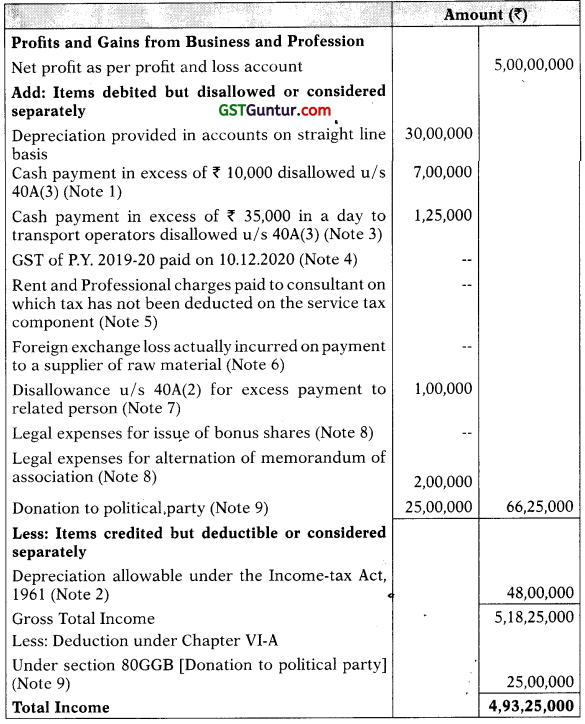
Computation of Tax liability of XYZ Ltd. for A.Y. 2021-22
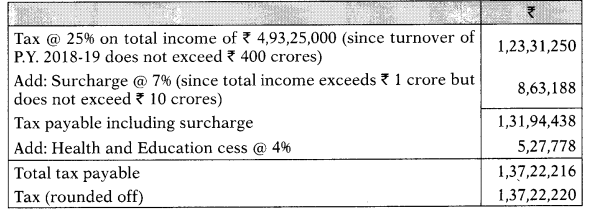

Notes:
(1) As per sec. 40A(3), cash payments exceeding ₹ 10,000 in a day is wholly disallowed. However, Rule 6DD provides for certain exceptions, which includes, payments which are required to be made on a day on which the banks were closed either due to holiday or strike. Hence, cash payments of ₹ 5 lakhs made on the day of strike by bank staff and cash payment of ₹ 10 lakhs made on a bank holiday would not be disallowed u/s 40A(3), assuming such payments were required to be made on those specific dates. However, cash payment of ₹ 7 lakhs made on 5.6.2020 due to demand of supplier would attract disallowance u/s 40A(3).
(2) Depreciation provided in the accounts on straight line basis (i.e., ₹ 30 lakhs) shall be added back and depreciation as per Income-tax of ₹ 28 lakhs is allowable as deduction u/s 32.
Further, as per sec. 32(1)(iia), additional depreciation @ 20% shall be allowed on the actual cost of ₹ 100 lakhs of new plant and machinery purchased in June 2020. Hence, the total depreciation is ₹ 48 lakhs [i.e., ₹ 28 lakhs + ₹ 20 lakhs].
(3) Where the payment of an expenditure is made in cash to a transport operator, the disallowance u/s 40A(3) is attracted only if the payment exceeds ₹ 35,000 so the cash payment of ₹ 32,000 would not be disallowed. However, cash payments of ₹ 50,000 and ₹ 75,000 on 7.5.2020 and 8.1.2020, respectively, would be disallowed under section 40A(3) as they exceed ₹ 35,000 in a day.
(4) As per section 43B, where any tax is not paid till the due date of filing the return of income, the same shall be disallowed. But it will be allowed as deduction where it is paid in any subsequent year. Hence, the GST liability of ₹ 1.45 lakhs pertaining to previous year 2019-20 is deductible in the year of payment (i.e., P.Y. 2020-21). Since it is already debited to profit and loss account, no further adjustment is required.
(5) Where the service tax component comprised in the amount payable to a resident is indicated separately, tax shall be deducted at source on the amount paid/payable without including such service tax component.
Assuming that, the service tax component is indicated separately in the agreement between the company and the consultant, tax shall be deducted without including such service tax component. Therefore, no disallowance is attracted for non-deduction of tax at source on the service tax component.
(6) As per Sec. 43AA, subject to provisions of sec. 43A, any gain or loss arising on account of any change in foreign exchange rates shall be treated as income or loss and such gain or loss shall be computed as per the ICDS’s notified u/s 145(2). Sec. 43AA also provides that gain or loss on account of the effects of change in foreign exchange rates shall be in respect of all foreign currency transactions including those relating to monetary items and therefore, here sec. 43AA will be applicable.

As per ICDS-VI – The Effects of Changes in Foreign Exchange Rates,
the loss which arises on settlement of monetary items will be allowed as expense in the previous year when the said loss arises.
In this case, the foreign exchange loss of ₹ 2,25,000 (1,000 kgs × $75 × ₹ 3) has accrued and actually been incurred during the P.Y. 2020-21. Hence, the same is allowable as deduction in the A.Y. 2021-22. Since the same has already been debited to profit and loss account, no further adjustment is required.
Note: ICDS is applicable to all the company-assessees. In this case, it is assumed that XYZ Ltd. follows mercantile system of accounting and therefore, ICDS would be applicable. Further, it is also assumed that the rate of exchange on 31.3.2020 was the same as on 29.3.2020 and hence, no exchange loss is required to be provided for in P.Y. 2019-20.
(7) ABC Ltd. is a related person under section 40A(2), since the directors of the XYZ Ltd. have substantial interest in ABC Ltd. Therefore, excess payment of ₹ 1 lakh to ABC Ltd. for purchase of goods would attract disallowance under section 40A(2).
(8) As per Supreme Court in CIT v. General Insurance Corpn. (2006) on issue of bonus share, there is no fresh inflow of funds or increase in capital employed. There is only reallocation of the company’s fund. Consequently, legal expenses of ₹ 10 lakhs in connection with issue of bonus shares is revenue expenditure and is hence, allowable as deduction.
However, legal expense in relation to alteration of memorandum and in connection with increase in Authorised Capital is directly related to expansion of the capital base of the company and is, hence, a capital expenditure. Therefore, the same is not allowable as deduction. It has been so held in Punjab State Industrial Development Corporation Ltd v. CIT (1997) (SC).
(9) Donation paid to a political party is disallowed as per sec. 37 as not incurred wholly and exclusively for business. However, the same shall be allowed as deduction u/s 80GGB if the payment is made not by way of cash.

Question 22.
X & Co. Diagnostic Centre P. Ltd. has claimed referral fee paid to doctors as revenue expenditure for the assessment year 2021-22. Tax has been deducted u/s 194H for the said payments. The A.O. proposes to disallow such expenditure. Examine the correctness of the action of the A.O. [CA Final May 2014] [4 Marks]
Answer:
As per Explanation to section 37(1), any expenditure incurred by an assessee for any purpose which is an offence or which is prohibited by law shall not be deemed to have been incurred for the purpose of business and profession and no deduction or allowance shall be made in respect of such expenditure. As per the Indian Medical Council (Professional Conduct, Etiquette and Ethics) Regulations, 2002, no physician shall give, solicit, receive or offer to give, solicit or receive any gift, gratuity, commission or bonus in consideration of a return for referring any patient for medical treatment.
The demand as well as payment of such referral fee is bad in law. It is not a fair practice and is opposed to public policy. Applying the rationale and considering the purpose of Explanation to section 37(1), the assessee would not be entitled to deduction of such payments made in contravention of law or opposed to public policy or have pernicious consequences to the society as a whole. This view has been upheld by the Punjab & Haryana High Court in CIT v. Kap Scan and Diagnostic Centre P. Ltd. (2012).
Thus, the action of the Assessing Officer in disallowing the referral fee paid by X & Co. Diagnostic Centre P. Ltd. to doctors is correct. The fact that tax has been deducted u/s 194H is of no consequence.

Question 23.
(i) Rahul Ltd. is engaged in the business of growing and manufacturing tea in India. For the previous year ending on 31.03.2021, its composite business profit before allowing deduction u/s 33AB is ₹ 70,00,000. On 01.09.2021 it deposited a sum of ₹ 10,00,000 in the Tea Development Account. During the previous year 2018-19, Rahul Ltd. had incurred a business loss of ₹ 14,00,000 which has been carried forward. On 25.01.2022, it withdraws ₹ 10,00,000 which is utilized as under:
₹ 6,00,000 for purchase of non-depreciable asset as per the scheme specified.
₹ 3,00,000 for purpose other than specified in the scheme.
₹ 1,00,000 was spent for the purpose of scheme on 05.04.2022.
(a) Compute the business income of Rahul Ltd. for A.Y.2021-22.
(b) What are the tax consequences of money misutilized/not utilized?
(c) What will be the consequence if the asset purchased for ₹ 6,00,000 is sold for ₹ 8,00,000 in April, 2022?
(ii) Assume that the asset which was purchased for ₹ 6,00,000 was a depreciable asset and it is the only asset in the block and it was sold for ₹ 8,00,000 in April, 2022. [CA Final Nov. 2014] [9 Marks]
Answer: (i)
(a) As per rule 8, before disintegrating the business profits into agricultural income and non-agricultural income, the income is to be computed under the head “Profit and Gains from Business and Profession”, which means besides other deductions, the deduction u/s 33AB shall also be allowed.
Computation of Total Income of Rahul Ltd.


Since, the asset is sold within 8 years, the cost of the asset i.e. ₹ 6,00,000 shall be treated as business income as the entire cost had been allowed as deduction in the earlier year but out of this ₹ 6,00,000, 60% shall be agricultural income and balance 40% i.e. ₹ 2,40,000 will be the income taxable under the head PGBP.
(ii)
A.Y. 2022-23: Depreciation on machinery acquired and put to use for less than 180 days = 50% of 15% of ₹ 6,00,000 = ₹ 45,000.
A.Y. 2023-24:

Short term capital gain ₹ 8,00,000 – ₹ 5,55,000 = ₹ 2,45,000
Business income shall be ₹ 6,00,000; but out of this 60% shall be exempt as agriculture income and balance 40% i.e. ₹ 2,40,000 will be the income taxable under the head PGBP.

Question 24.
PQR Ltd., a non-banking finance company was engaged in the business of leasing and hire purchase. It purchased motor cars from Ramaha motors and leased out these vehicles to its customers. The lease agreement with the customer stated that PQR Ltd. was empowered to repossess the vehicle, in case the lessee committed a default. Registration of the vehicle in the name of lessee, during the period of lease is mandatory as per the Motor Vehicles Act, 1988. PQR Ltd. claimed ₹ 5,00,000 as depreciation on the vehicles leased out for the year ending 31.3.2021.
H The claim was rejected by the A.O. on the ground that the assessee had merely financed the purchase of motor cars and was neither the owner nor the user of these assets. Is the action of the A.O. valid? Discuss. [CA Final Nov. 20J4] [4 Marks].
Answer:
The issue under consideration in this case is whether depreciation on leased vehicles can be denied to the lessor (PQR Ltd.) on the grounds that the vehicles are registered in the name of the lessee and that the lessor is not the actual user of vehicles.
The facts of the case are similar to the facts in I.C.D.S Ltd. v. CIT (2013), where the Supreme Court observed that section 32 imposes a twin requirement of “ownership” and “usage for business” as conditions for claim of depreciation thereunder. As far as usage of the asset is concerned, the section requires that the asset must be used in the course of business. It does not mandate actual usage by the assessee itself.
The Supreme Court further observed that the Motor Vehicle Act, 1988 contains a deeming provision which creates a legal fiction of ownership in favour of the lessee only for that Act and not for the purpose of law in general. No inference could be drawn from the registration certificate as to ownership of the vehicles, since registration in the name of the lessee during the period of lease is mandatory as per the Motor Vehicles Act, 1988.
Therefore, as long as the lessor has a right to retain the legal title against the rest of the world, it would be the owner of the asset in the eyes of law.
By applying the above rationale, the action of the A.O. in denying the depreciation claim of PQR Ltd. is not valid since PQR Ltd. has used the vehicles in the course of its leasing business even though it was not the actual user of the vehicles. Also, PQR Ltd. is the exclusive owner of the vehicle at all points of time as he is empowered to repossess the vehicle, in case the lessee committed a default. The proof of ownership lies in the lease agreement itself, which clearly points in favour of PQR Ltd.

Question 25.
Riddhi Corporation LLP, is carrying on two businesses viz. Textile manufacture and Operation of cold chain facility. It gives you the following information for the year ended 31st March, 2021:

The following items are debited to Profit & Loss Account:
(i) Interest on capital payable to partners @ 15% on total capital of ₹ 120 lakhs.
(ii) Working partner salary ₹ 54 lakhs (i.e., ₹ 1.5 lakhs each per month for 3 partners).
(iii) Depreciation on textile factory building ₹ 8 lakhs.
(iv) Depreciation on Plant & Machineries of textile business ₹ 40 lakhs.
(v) Keyman insurance policy premium paid ₹ 1,60,000.
Other Information:
Eligible depreciation u/s 32 for the previous year 2020-21 are-
(i) On Plant & Machineries of textile business ₹ 30 lakhs.
(ii) On factory building relating to textile business ₹ 6 lakhs.
The assessee set up and operating a cold chain facility since 1st April, 2019. It incurred capital expenditure towards construction of cold chain facility during the period from 1st June, 2017 to 31st March, 2019 as under:
Cost of land (acquired on 1st June, 2017) ₹ 40 lakhs.
Cost of construction of building and machineries installed till 31st March, 2019 ₹ 90 lakhs.
The income of the firm for the previous year 2019-20 (A.Y 2020-21) is given below:
Income from Textile manufacture ₹ 15 lakhs.
Income from cold chain facility ₹ 80 lakhs (before deduction u/s 35AD)
The firm originally had 4 equal partners and one partner retired on 31-32020. The partnership agreement authorizes payment of salary and interest on capital which are debited to Profit & Loss Account.
You are requested to compute the total income of the firm for the A.Y. 2021-22.
Ignore Alternate Minimum Tax (AMT) u / s 115JC. [CA Final May 2015] [10 Marks]
Answer:
Computation of Total Income of Riddhi Corporation LLP for the A.Y. 2021-22
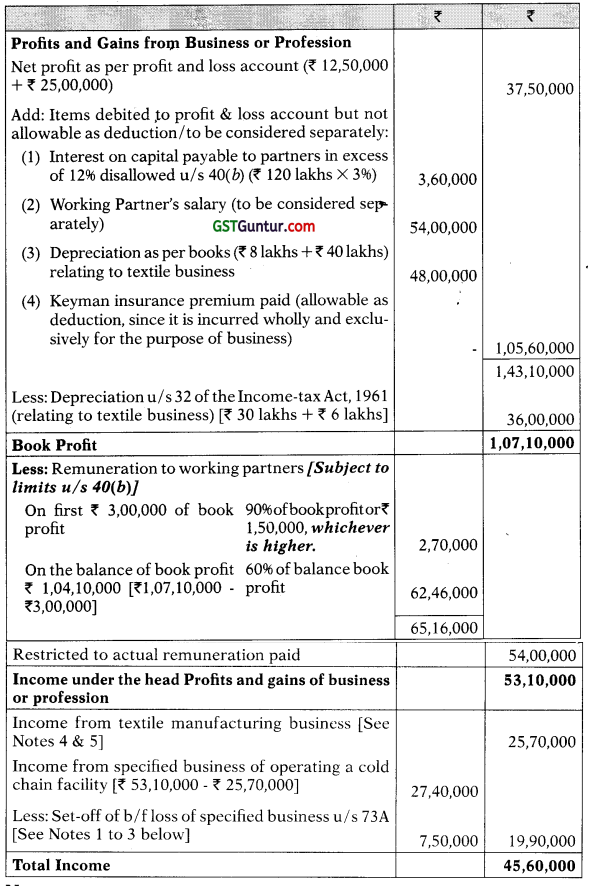

Notes:
(1) Computation of loss of specified business of setting up and operating a cold chain facility for P.Y. 20 19-20 relevant to A.Y. 2020-21:
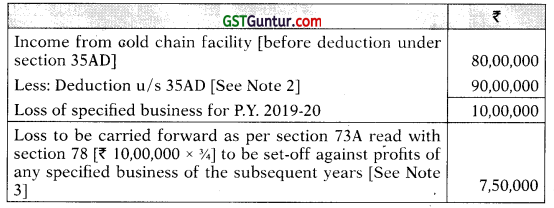
(2) Expenditure incurred on acquisition of land is not available as deduction u/s 35AD(8). Therefore, only cost of ₹ 90 lakhs on construction of building and machinery installed would qualify for deduction u/s 35AD, [assuming such expenditure has been capitalized in the books as on 1.42019 (date of commencement of operations)1, as it was incurred prior to commencement of operations [Proviso to section 35AD(1)].
(3) Section 78(1) does not permit carry forward of losses pertaining to the share of a retired or deceased partner. Therefore, in this case, since one of the four partners have retired on 31.3.2020, his share of loss (₹ 2,50,000, being 1/4th of ₹ 10 lakh) for the P.Y. 2019-20 (A.Y. 2020-21) cannot be carried forward to the P.Y. 2020-21 (A.Y. 2021-22).
(4) Computation of profit from textile manufacturing business
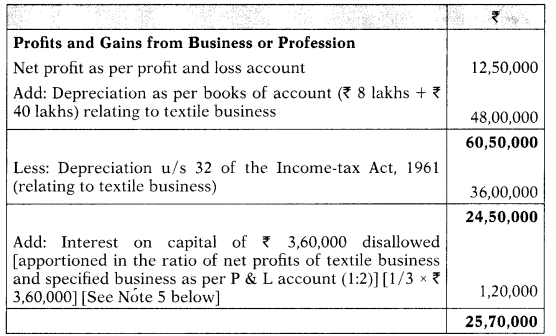
(5) Loss of specified business can be carried forward indefinitely for set-off only against profits of any specified business. Therefore, it becomes necessary to segregate the income of ₹ 53.10 lakhs computed under the head “Profits and gains of business or profession”, so that brought forward loss from specified business relating to P.Y. 2019-20 can be set-off against profits of specified business of the P.Y. 2020-21.
For this purpose, while computing profits of textile manufacturing business included in the business income of ₹ 53.10 lakhs, the depreciation as per books of account has to be added back and the depreciation as per the Income-tax Act, 1961 has to be reduced from the net profit of ₹ 12.50 lakhs pertaining to textile business, since the depreciation adjustments clearly relate to textile business.
The entire remuneration is allowable as deduction because it is with- in the limits as per section 40(6)(v). It is only the interest on capital amounting to ₹ 3.6 lakhs (which has been added back while computing business income) which has to be apportioned between textile manufacturing business and specified business.
The interest on capital is to be apportioned in the ratio of 1 : 2 (ratio of the net profit of these two businesses as per P&L A/c) between textile manufacturing and specified business. The solution can also be worked out by apportioning interest on capital on any other logical basis.

Question 26.
Star India Ltd., a listed company, engaged in manufacturing activity furnishes the following details:
Net profit as per Profit and Loss Account ₹ 60,00,000.
(i) The company took a loan of ₹ 15,00,000 in the P.Y. 2016-17 for the purpose of relocation of its office premises. The lender waived ₹ 10,00, 000 in the P.Y. 2020-21 and it is credited in the P & L A/c.
(ii) Depreciation charged to Profit and Loss Account is ₹ 18,00,000. Depreciation as per Income-tax Act, 1961 amounts to ₹ 30,00,000 which includes the following:
Depreciation rate meant for computers has been adopted for (i) accessories like printers and scanners; and (ii) EPABX. The written down value of these as on 1-4-2020 is given below:
(a) Printers and Scanners – ₹ 60,000
(b) EPABX – ₹ 3,00,000
Assume that there were no additions during the year.
(iii) It incurred ₹ 3,00,000 as expenditure for public issue of shares. The public issue could not materialize on account of non-clearance by SEBI. This amount is charged to Profit & Loss Account.
(iv) It incurred expenditure of ₹ 2,50,000 towards issue of debentures. This amount has been capitalized in the books.
(v) The company paid ₹ 1,50,000 as compounding fee for violations in the pollution control regulations. This has been charged as revenue expenditure.
(vi) The company lost cash of ₹ 28,00,000 due to theft when it was with-drawn from bank and taken to administrative office. It is not insured and hence, fully charged as revenue expenditure.
(vii) ₹ 6,00,000 was spent during the year towards permitted CSR activities as per 135 of the Companies Act, 2013 This is charged to Profit and Loss Account.

(viii) It paid ₹ 2,50,000 to share broker for transacting shares listed in stock exchange and ₹ 2,00,000 to commodity broker for commodity transactions at MCX. Both the amounts are debited to Profit and Loss Account and no tax was deducted at source on these payments.
(ix) The company has 200 employees as on 31.03.2020. During the be-ginning of the year, the company removed some of the employees and employed 115 new employees which makes the total number of employees as 295 as on the last day of the P.Y. 2020-21. It paid ₹ 3,000 p.m. to all the employees.
(x) It paid ₹ 60,000 to an electoral trust by cash and ₹ 1,20,000 by cheque to a registered political party. Both these are debited to Profit and Loss Account.
Compute the total income of the company for the assessment year 2021-22. Give reasons in brief for treatment of each of the above items. Ignore MAT provisions. [CA Final May 2015] [16 Marks]
Answer:
Computation of Total Income of Star India Ltd. for the A.Y. 2021-22

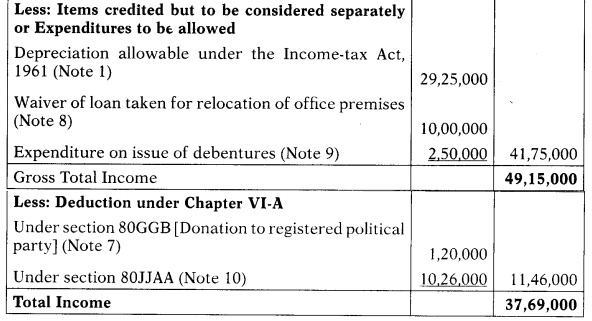

Notes:
(1) Depreciation as per books of account charged to P&L A/c (i.e., ₹ 18 lakhs) has to be added back and depreciation calculated as per Income-tax Rules, 1962 (i.e. ₹ 29.25 lakhs) is allowable as deduction u/s 32. Computer accessories and peripherals like printer and scanner form an integral part of the computer system and they cannot be used without the computer; hence, they are eligible for depreciation @ 40% [CIT v. BSES Yamuna Powers Ltd. (2013) (Del.)].
However, EPABX is not a computer and is, hence, not entitled to higher depreciation @ 40% [Federal Bank Ltd. v. ACIT (2011) (Kerala)].
Therefore, depreciation as per Income-tax Act, 1961 would be ₹ 28.65 lakhs, which is computed as follows –
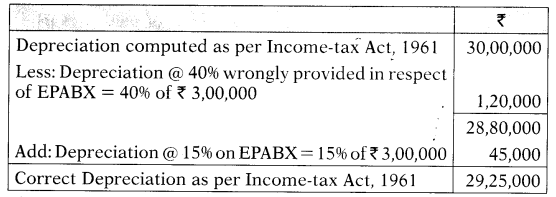
(2) Share issue expenses constitute a capital expenditure, even though the company could not go in for the public issue on account of non-clear ance by SEBL Though the efforts were aborted, the fact remains that the expenditure incurred was only for the purpose of expansion of the capital base. The capital nature of the expenditure would not be lost on account of the abortive efforts [Mascon Technical Services Ltd. y. CIT (2013) (Mad.)]. Since the expenditure has been charged to profit and loss, the same has to be added back.
(3) The amount paid for compounding an offence is inevitably a penalty and the mere fact that it has been described as compounding fee cannot, in any way, alter the character of the payment which is in the nature of penalty and hence, is not allowable as revenue expenditure [Millennia Developers P. Ltd. v. Deputy CIT (2010) (Kar.)]. Since the compounding fee has been charged to P & L A/c, the same has to be added back.
(4) The loss incurred by theft, dacoity, embezzlement etc., if incidental to the carrying on of the business whether committed by the employees of the assessee or by strangers is deductible. [G.G. Dandekar Machine Works Ltd. v. CIT (1993) (Bom.)]. In this case, the loss due to theft took place when cash was withdrawn from bank and taken to administrative office is incidental to business and thus, allowable as revenue expenditure.

(5) Any expenditure incurred by an assessee on the activities relating to CSR referred to in section 13 5 of the Companies Act, 2013 is disallowed as per Explanation 2 to section 37. Since the expenditure has been charged to profit and loss account, the same has to be added back for computing business income.
It is assumed that the CSR expenditure is not of the nature described in sections 30 to 36 of the Income-tax Act, 1961, and hence, does not qualify for deductions under those sections.
(6) The payments to share broker and commodity broker are in the nature of commission. However, payment for transaction in securities has been particularly excluded from the scope of section 194H. Hence, payment of ₹ 2.5 lakhs to a share broker for transacting shares listed in stock exchange (which falls within the meaning’of securities) would not be disallowed for non-deduction of tax at source.
However, payment of ₹ 2 lakh to a commodity broker for commodity transactions at MCX would attract disallowance @ 30% under section 40(a)(ia), due to non deduction of tax at source under section 194H.
(7) Donation to an electoral trust and a registered political party is not deductible u/s 37 since it is not laid out wholly and exclusively for the purposes of business or profession. However, donation made by a company to an electoral trust or registered political party is allowable deduction u/s 80GGB from gross total income, subject to the condition that payment is made otherwise than by way of cash. Since, the donation to electoral trust is made in cash, the same does not qualify for deduction u/s 80GGB. But donation of ₹ 1.2 lakh by cheque to a registered political party would be eligible for deduction u/s 80GGB.
(8) Since the loan was taken by Star India Ltd. for the purpose of relocating its office premises i.e., for acquisition of a capital asset, namely, a new office, the waiver of the same cannot be said to be a waiver or remission of trading liability to attract taxability u/s 41(1). Waiver of such loan, being capital in nature, is not taxable [CIT v. Softworks Computers P Ltd. (2013) (Bom.)]. So as the loan of ₹ 10 lakh waived is credited to profit and loss account, the same must be deducted for computing business income. But the same would be reduced from the actual cost of the office premises.

(9) The expenditure on issue of debentures is not in the nature of capital expenditure and is laid out or expended wholly and exclusively for the purpose of the assessee’s business and is therefore, allowable as a deduction. The act of borrowing money is incidental to the carrying on of business, the loan obtained is not an asset or an advantage of enduring nature, the expenditure is made for securing the use of money for a certain period, and it is irrelevant to consider the object with which the loan was obtained [India Cements Ltd. v. CIT (1966) (SC)]. Since the said expenditure has been capitalized in the books of account, the same has to be deducted to compute business income.
(10) Besides the normal deduction of employee cost under the relevant head of income, an additional deduction of 30% of ‘Additional employee cost’ is allowable u/s 80JJAA , where the assessee is a company and its gross total income includes any profits and gains derived from a 5 business and to whom Sec. 44AB applies.
“Additional Employee” means an employee who has been employed § during the previous year and whose employment has the effect of increasing the total number of employees employed by the employer j as on the last day of the preceding year.
In this case, the company has employed 115 new employees during the P.Y. 2020-21, but only 95 (295 i.e. as on last day of P.Y. 2020-21 – 200 i.e. as on last day of P.Y. 2019-20) employees has the effect of increasing the total number of employees employed by the employer as on the last day of the preceding year. Also, the amount of emoluments paid to the additional employees is ₹ 3,000 which is less than 25,000 and are employed during the previous year for more than 240 days. Therefore, the deduction u/s 80JJAA shall be available for the emoluments paid to the 95 employees.
So, Additional cost shall be ₹ 34,20,000 (95 additional employees × ₹ 3,000 p.m. × 12 months)
Therefore, deduction under section 80JJAA would be ₹ 10,26,000, being 30% * ₹ 34,20,000.
Note: Assumed that Sec. 44AB is applicable to the Star India Ltd. and the other conditions of additional employee are being satisfied.

Question 27.
Parik Hospitality Ltd. is engaged in the business of running hotels of 3-star category. The Company’s P & L A/c for the P.Y. ended 31.03.2021 shows a net profit of ₹ 152 lakhs after debiting or crediting the following j items:
(a) Payment of ₹ 0.25 lakh and ₹ 0.30 lakh in cash on 3rd December, 2020 and 10th December, 2020 respectively for purchase of crab, lobster and squid to Mr. Raja, a fisherman and Mr. Khalid, a middleman for these products respectively.
(b) Contribution towards employees’ pension scheme notified by the Central Government u/s 80CCD for a sum of ₹ 3 lakhs calculated at 12% of basic salary and Dearness Allowance payable to the employees,
(c) Payment of ₹ 6.50 lakhs towards transportation of various materials procured by one of its hotels to M/s Bansal Transport, a partnership firm without deduction of tax at source. The firm has furnished its Permanent Account Number in the tender document.
(d) Profit of ₹ 12 lakhs on sale of a plot of land to Avimunya Limited, a domestic company, the entire shares of which are held by the assesseed company. The plot was acquired by Parik Hospitality Limited on 1st June, 2020.
(e) Contribution of ₹ 2.50 lakhs to Indian Institute of Technology with a specific direction for use of the amount for scientific research programme approved by the prescribed authority.
(f) Expense of ₹ 10 lakhs incurred on foreign travel of two directors for a collaboration agreement with a foreign company for a brewery project to be set up. The negotiation did not succeed and the project was abandoned.
(g) Fees of ₹ 1 lakh paid to independent directors for attending Board meeting without deduction of tax at source u/s 194J.
(h) Depreciation charged ₹ 10 lakhs.
(i) ₹ 10 lakhs, being the additional compensation received from the State Government pursuant to an interim order of Court in respect of land acquired by the State Government in the year 2016-17.
(j) Dividend received from a foreign company ₹ 5 lakhs,

Additional information:
(i) As a corporate debt restructuring, the bank has converted unpaid j interest of ₹ 10 lakhs upto 31st March, 2019 into a new loan account repayable in five equal annual instalments. The first instalment of ₹ 2 lakhs was paid in March, 2020 by debiting new loan account.
(ii) Depreciation as per Income-tax Act: ₹ 15 lakhs.
(iii) The company received a bill for ₹ 2 lakhs on 31st March, 2021 from a supplier of vegetables for supply made in March, 2021. The bill was omitted to be recorded in the books m March, 2021. The bill was paid in April, 2021 and the necessary entry was made in the books then.
Compute total income of Parik Hospitality Limited for the A.Y. 2021-22 indicating the reason for treatment of each item. Ignore the provisions relating to minimum alternate tax. [CA Final Nov. 2015] [6 Marks]
Answer:
Computation of Total income of Parik Hospitality Ltd. for A.Y. 2021 -22
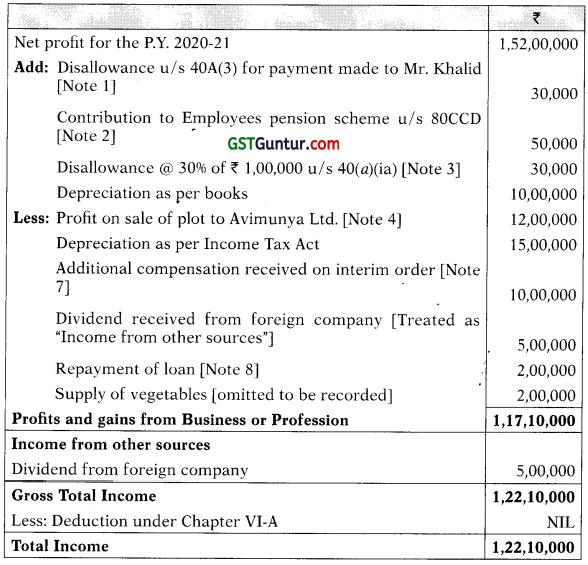
Notes:
1. As per sec. 40A(3), paYment or aggregate of payments made for an expenditure on a single day, otherwise than by an account payee cheque or account payee bank draft or use of electronic clearing system through a bank account or through such other electronic mode as may be prescribed, exceeding 10,000. shall be wholly disallowed. But, Rule 6DD provides, inter alia., that disallowance u/s 40A(3) shall not apply in respect of payments made to cultivator or producer for the purchase of dairy or poultry farming fish or fish products. In this case cash of ₹ 25,000 directly paid to Mr. Raja, a fisherman shall not be disallowed but cash paid ₹ 30,000 to Mr. Khalid, middle man for these products will be disallowed.

2. As per Sec. 36(1)(iva), in case of an employer other than Central Government, contribution made towards pension scheme referred to in Sec. 80CCD on account of employee shall be allowed as deduction to the extent of 10% of salary of the employee. Here ‘salary’ includes dearness allowance, if the terms of employment so provide, but excludes all other allowances and perquisites. Hence, deduction shall be allowed only upto ₹ 2,50,000 [₹ 3,00,000/12% × 10%] and ₹ 50,000 [₹ 3,00,000 – ₹ 2,50,000] is not deductible and hence added back..
3. As per sec. 40(a)(ia), 30% of any sum payable to a resident on which tax is deductible at source under Chapter XVII-B, shall be disallowed if tax has not been deducted or after deduction has not been paid on or before the due date u/s 139(1).
But, as per sec. -194C, no tax is required to be deducted for payments made to “Transport Operator” i.e. engaged in the business of plying & hiring of goods carriage where such contractor owns ten or less goods carriages at any time during the previous year and furnishes a declaration to that effect along with his PAN;
Thereby, no tax is to be deducted on payment of ₹ 6,50,000 made to M/s Bansal Transport for transportation of materials, assuming that M/s Bansal Transport does not own more than 10 goods carriage vehicle at any time during 2020-21.
However, 30% of the payment made to independent directors for attending board meeting, without deducting tax shall be disallowed u/s 40(a)(ia).
4. As per sec. 47(iv), any transfer of a capital asset by a holding company to its wholly owned subsidiary company, being an Indian company, is exempt in the hands of holding company. In this case, Parik Hospitality Ltd. had sold plot of land to Avimunya Ltd. which is 100% subsidiary company of Parik Hospitality Ltd. and also an Indian company. Therefore, the capital gain from such transfer is exempt in the hands of Parik Hospitality Ltd. As the profit was already credited to P & L account, it shall be reduced from the profit.
5. As per sec. 35(2AA), an assessee is eligible for deduction of 100% of the amount contributed to National Laboratory, IIT, University, persons approved by prescribed authority (whether related with assessee’s business or not) for undertaking scientific research. Since, the amount has already debited, no further adjustment is required.
6. The expense incurred on foreign travel of two directors for entering into collaboration agreement with a foreign company for setting up a new project where the negotiation did not succeed and the project was abandoned shall be allowed as revenue expenditure as no new asset or business came into existence. Hence, not added back as already debited to P & L account. Similar issue was decided by the Delhi high court in the case of CIT v. Priya Village Roadshows Ltd. (2011).
7. As per the proviso to Sec. 45(5), where any amount of compensation received in pursuance of an interim order of a court, Tribunal or other authority shall be deemed to be income chargeable under the head “Capital gains” of the previous year in which the final order of such court, Tribunal or other authority is made. Hence, the additional compensation received on interim order shall not be treated income as Final order is still not passed.
8. Conversion of unpaid interest into a new loan shall not be deemed as actual payment of interest for the purpose of deduction u/s 43B. Consequently such converted interest will not be deductible, but on repayment of such loan, it shall be allowed as deduction in the year of payment. [Kalpana Lamps and Components Ltd. (2002) (Mad.)]

Question 28.
Mr. Janak is proprietor of M/s. Yash Texnit which is engaged in garment manufacturing business. The entire block of Plant & Machinery chargeable to depreciation @ 15%, has 15 different machinery items as at 31.03.2020. One of the machinery used for packing had become obsolete and was discarded by Mr. Janak in July, 15th. Assessee filed its return for A.Y. 2021-22 claiming total depreciation of ₹ 40 lakhs which includes ₹ 4.0 lakhs being the depreciation claimed on the machinery item discarded by Mr. Janak. The A.O. disallowed the claim of depreciation of ₹ 4.00 lakhs during the course of scrutiny assessment. Comment on the validity of action taken by A.O. [CA Final May 2016] [4 Marks]
Answer:
The facts of this case are similar to the facts of the case CIT v. Yamaha Motor India Pvt. Ltd. (2010), where Delhi High Court has held that the phrase “used for purpose of business” in respect of discarded machine includes use of such asset even in the earlier years for claiming depreciation u/s 32. It is not necessary that the asset must have been used in the relevant previous year and therefore, its use even in the earlier financial years shall make it eligible for depreciation.
As per Sec. 43(6), “moneys payable” means the sale price, in case of sale, or the insurance, salvage or compensation moneys payable in respect of the asset. In this case, the machinery has not been sold as machinery or scrap or disposed off, and it continues to exist. Hence, there is no “moneys payable” deductible from the WDV of the block.
Applying the rationale of the above case, the assessee Mr. Janak is eligible for depreciation of full ₹ 40 lakhs including depreciation of ₹ 4.00 lakhs in respect of discarded machinery. Therefore, the action taken by the A.O. to disallow the claim of depreciation in respect of discarded machine is invalid.

Question 29.
XYZ Ltd. is engaged in the manufacture of fertilizers since 01-042013. Its Statement of Profit & Loss shows the total turnover of ₹ 1,500 lakhs for the P.Y. 2018-19 and a net profit of ₹ 700 lakhs after debit/credit of the following items:
(1) Depreciation calculated on the basis of useful life of assets as per provisions of the Companies Act, 2013 is ₹ 50 lakhs.
(2) Normal Depreciation calculated as per Income-tax Rules is ₹ 80 lakhs.
(3) Employer’s contribution to EPF of ? 2 lakhs together with the Employees’ contribution of ₹ 2 lakhs for the month of March, 2020 was
remitted on 8th, May 2020.
(4) The company appended a note to its Income Statement that industrial power tariff concession of ₹ 2.5 lakhs was received from the State Government and treated the same as capital receipt.
(5) The company had provided an amount of ₹ 25 lakhs being sum estimated as payable to workers based on agreement to be entered with the workers union towards periodical wage revision once in 3 years. The provision is based on a fair estimation on wage and probable revision.
(6) The company had made a provision of 10% of its debtors towards bad and doubtful debts. Total sundry debtors of the company as on 31.03.2021 was ₹ 200 lakhs.
(7) A debtor who owed the company an amount of ₹ 40 crores was declared insolvent and hence, was written off.
(8) Sundry creditors include an amount of ₹ 50 lakhs payable to A & Co, towards supply of raw materials, which remained unpaid due to quality issues. An agreement has been made on 31.03.2021, to settle the amount at a discount of 75% of the outstanding.
(9) The opening and closing stock for the year were ₹ 200 lakhs and ₹ 250 lakhs, respectively. They were overvalued by 10%.
(10) Provision for gratuity based on actuarial valuation was ₹ 5 crores. Actual gratuity paid was ₹ 3 crores.
(11) Commission of ₹ 1 lakhs paid to a recovery agent for realization of a debt. Tax has been deducted and remitted as per Chapter XVIIB of the Act.
(12) The company has purchased 500 tons of industrial paper as packing j material at a price of ₹ 30,000/ton from PQR, a firm in which majority of the directors are partners. PQR’s normal selling price in the market for the same material is ₹ 28,000/ton.

Additional Information:
(1) There was an addition to Plant & Machinery amounting to ₹ 50 lakhs on 10.06.2020.
(2) The company had credited a sub-contractor an amount of ₹ 8 lakhs on 31.03.2020 towards repairing a machinery component. The tax so deducted was remitted on 30.11.2020.
Compute total income and tax payable. Ignore MAT provisions. [CA Final May 2016] [16 Marks]
Answer:
Computation of Total Income of XYZ Ltd. for the A.Y. 2021-22
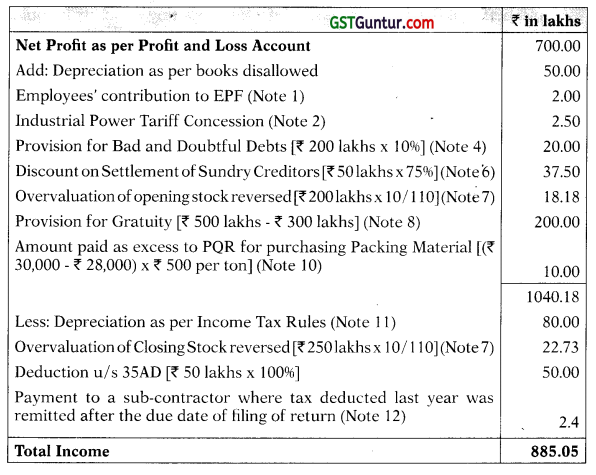
Computation of tax liability of XYZ Ltd. for A.Y. 2021-22
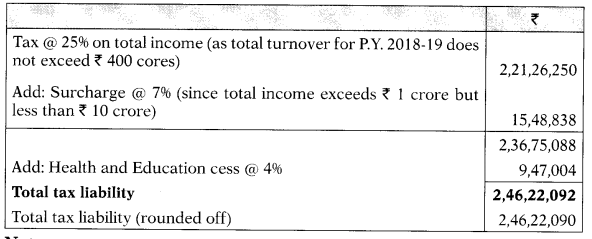
Notes:
1. In the case of CIT v. Gujarat State Road Transport Corporation (2014), the Gujarat High Court held that the employees contribution to provident fund deposited after the due date mentioned under the Provident Fund Act is not allowable as deduction as per Sec. 36(1)(va) and hence, it has been disallowed while computing business income.
However an alternate view has been taken in CIT v. Kiccha Sugar Co. Ltd. (2013) (Uttarakhand) and CIT v. AIMIL Ltd (2010) (Del), where it was held that the employees contribution to PF, shall be allowed as deduction from the income of the employer-assessee, if the same is deposited on or before the due date of filing of return for the relevant previous year. If this view is considered, then no disallowance would be attracted in this case, since the employees’ contribution has been remitted before the due date of filing of return of income.

2. As per sec. 2(24)(xviii), income shall include assistance received in the form of a subsidy or grant or cash incentive or duty drawback or waiver or concession or reimbursement (by whatever name called) from the Central Government or a State Government or any authority or body or agency in cash or in kind to the assessee other than the subsidy or grant or reimbursement which is taken into account for determination of the actual cost of the asset in accordance with the provisions of Explanation 10 to sec. 43(1). Therefore, the Industrial Power Tariff Concession received by XYZ Ltd. shall be taxable and to be included in the Income Statement,
3. If the provision is made for the present obligation resulting from the past events and which may require outflow of resources to settle and reliable estimate can be made, then such provision is allowable as deduction u/s 37(1). Therefore, the provision made, to be paid as wage revision on a fair estimation and probable revision basis shall be allowed as deduction u/s 37(1) to XYZ Ltd. Since the same has already been debited to profit and loss account, no further adjustment is required.
4. Provision for doubtful debts is allowable as deduction u/s 36(1)(viia) only in case of banks, public financial institutions, state financial corporations and state industrial investment corporations. Such provision is not allowable as deduction in the case of a manufacturing company. Since, the same has been debited to profit and loss account, it has to be added back for computing business income.
5. Bad debts write off in the books of account is allowable as deduction u/s 36(1)(vii). Since the same has already been debited to profit and loss account, no further adjustment is required.
6. As per sec. 41(1), where in any earlier year, deduction was allowed in respect of loss, expenditure or trading liability incurred by the asses- see and during the current previous year, the assessee has obtained a refund of such trading liability or has obtained some benefit in respect of such trading liability by way of remission or cessation, then the value of such benefit accruing shall be deemed to be profits and gains of the business and thus chargeable as income of that previous year. Therefore, in this case, discount on settlement of sundry creditors shall be taxable as deemed income u/s 41(1).
7. It is assumed that the given figures of opening and closing stock of ₹ 200 lakhs and ₹ 250 lakhs respectively are at overvalued figure.
8. As per sec. 40A(7), provision for Gratuity shall be available to the assessee only if it is made for payment to Approved Gratuity Fund or made for Gratuity which has become due and payable during the current previous year. Therefore, in this case, only the actual gratuity paid by XYZ Ltd. shall be eligible for deduction and provision of ₹ 2 crores [₹ 5 crores – ₹ 3 crores] shall be disallowed.

9. Commission paid to Recovery Agent for realizing the amount of debt shall be allowed as deduction u/s 37, as it is incurred wholly and exclusively for the purpose of business [DCIT v. Super Tannery (India) Ltd. (2005) (AH.)]
10. As per sec. 40A(2), where in case an assessee being a company, incurs any expenditure for which the payment has been made or is to be made to a specified person i.e. in this case, to a firm in which the director or directors of the company has substantial interest, and such expenditure in the opinion of A.O. is excessive and unreasonable having regard to the fair market value of the goods, then such expenditure shall be disallowed to the extent considered as excessive or unreasonable by the A.O.
Therefore, in this case, by assuming that the Directors of XYZ Ltd. are having substantial interest in the firm PQR, the excess amount of ₹ 10,00,000 [(₹ 30,000 – ₹ 28,000) × ₹ 500 per ton] shall be disallowed.
11. It is assumed that depreciation as per IT rules has not been deducted from the statement of profit and loss account of XYZ Ltd.
12. 30% of ₹ 8 lakhs, being payment to a sub-contractor, would have been disallowed under section 40(a)(ia) while computing the business income of A.Y. 2020-21, since tax deducted was remitted after the due date of filing of return. However, the same is allowable in A.Y. 2021-22, since the remittance has been made on 30.11.2020.

Question 30.
X Ltd. issued debentures in the P.Y. 2020-21, which were to be matured at the end of five years. The debenture holder was given an option of one time upfront payment of ₹ 60 per debenture on account of interest which was to be immediately paid by the company. As per the option “ exercised by the debenture holders, company paid interest upfront to them in the first year itself and the same was claimed as deduction in the return of the company.
But in the accounts, the interest expenditure was shown as deferred expenditure to be written off over a period of five years.
During the course of assessment, the A.O. spread the upfront interest paid over a period of five year term of debentures and allowed only one fifth of the amount in the P.Y. 2020-21. Examine the correctness of the action of A.O. [CA Final May 2016] [4 Marks]
Answer:
The issue under consideration is whether the entire upfront interest paid by the company to the debenture holders exercising the option of one time upfront payment, be claimed as deduction in the first year or should the same be deferred over a period of debentures and whether the treatment of such interest as deferred revenue expenditure in the books of account have any impact on the tax treatment.
The Supreme Court in the case of Taparia Tools Ltd. v. Joint CIT (2015) (SC) observed that while examining the allowability of deduction, genuineness of borrowing should be considered. Also, u/s 36(1)(iii), any amount paid as interest is an admissible deduction, if the capital was borrowed by the j assessee for the purpose of business or profession. In the present case, the A.O. has not disputed the issue of debentures and use of funds for business purposes.
The Supreme Court also noted that there is no concept of deferred revenue expenditure in the Income-tax Act except under specified sections such as I section 35D meant for amortization over a period of time. Normally, revenue expenditure is deductible in the year in which it is incurred. When assessee had issued debentures with two options for payment of interest and if the interest is allowed by spread over it would amount to treating both the j methods of interest payment at par, which was clearly unsustainable. By discharging the liability in the first year itself, the assessee had benefited by making payment of a lesser amount of interest in comparison to the interest which was payable under the first option over a period of five years.
The Supreme Court, accordingly, held that the assessee would be entitled to deduction of the entire upfront interest paid in the same year in which the amount was actually paid.
Accordingly, the action of the A.O. spreading the upfront interest paid over j the five year term of debentures and restricting the deduction in the P.Y. 2020-21 to one-fifth of the upfront interest paid is not correct. The company is eligible to claim the entire amount of interest paid upfront as deduction 1 under section 36(1)(m) in the RY. 2020-21.

Question 31.
A non-resident aviation company flying an aircraft in India and paid y; tax u/s 44BBA claims that the employees deputed for flying this aircraft shall not be subjected to tax on the remuneration to the extent paid out . of such income. Is the claim justified? [CA Final May 2016] [3 Marks]
Answer:
Section 44BBA provides for deeming 5% of aggregate of amounts received by/paid or payable to a non-resident assessee engaged in the business of operation of aircrafts, for carriage of passengers, livestock, mail or goods, as profits and gains of such business chargeable to tax under the [ head “Profits and gains of business or profession”.
The same issue came up before the Advance Ruling Authority in the case of Lloyd Helicopters International Pty. Ltd. (2001), wherein it was observed that as per DTAA between India and Australia, one of the conditions for exemption of remuneration of employees resident of Australia is that such remuneration should not be deductible in determining the profits chargeable to tax of the non-resident aviation company.
In this regard, the AAR observed that the profits determined u/s 44BBA, though arrived at on a statutory basis, cannot be considered to exclude such expenses as non-deductible merely because the statute fixes a percentage in this regard. Also the low fixed rate of 5% of gross receipts indicates the statutory attempt at estimating and allowing expenses normally likely to be incurred in such business, which includes remuneration of employees.
Therefore, applying the rationale of the AAR ruling, the remuneration paid to employees is deemed to have been deducted while computing the profits chargeable to tax of the non-resident aviation company u/s 44BBA. Accordingly, the said remuneration paid to non-resident employees shall not be exempt from tax in India.
The claim of the non-resident aviation company is, therefore, not justified.
Note: The question is silent about the country of residence of the employees of the aviation company. Employees may be resident or non-resident in India. In case the remuneration is paid to resident employees, the same is taxable in their hands.
Also, the aviation company can be incorporated in a country with which India has no treaty. Therefore, it is possible to answer the question on the basis of the provisions of section 9(1) alone. Since, the services were rendered in India, salary of the employees shall be deemed to accrue or arise in India and therefore, the same attracts tax liability in India, irrespective of the fact that remuneration was paid out of income of the non-resident company chargeable to tax in India as per the provisions of section 44BBA.

Question 32.
Statement of Profit & Loss of BM Private Ltd., a resident company engaged in manufacturing, shows net profit of ₹ 90,00,000 for the financial year ended on 31st March, 2021 after debit/credit of following items:
A. Credited to the Statement of Profit and Loss:
(i) Rent received from vacant land ₹ 1,20,000
(ii) Rent received (gross) from a commercial property owned by the company ₹ 2,50,000 (Tax deducted by tenant @ 10%)
(iii) Interest received on income tax refund ₹ 1,00,000
(iv) Profit on sale of unused land ₹ 10,00,000
B. Debited to the Statement of Profit and Loss:
(i) Depreciation charged to the Statement of Profit and Loss ₹ 12,00,000.
(ii) Donation of ₹ 1,00,000 paid to Swachh Bharat Kosh.
(iii) Contribution to Political Party amounting to ₹ 2,00,000 paid in cash.
(iv) Payment made to transporter ₹ 1,00,000 by account payee cheque, but no tax has been deducted at source. (Transporter is having PAN and furnished declaration that he is covered u/s 44AE and not having more than 10 goods carriages at any time during the previous year)
(v) Bonus to employees ₹ 2,00,000 provided. However, payment was made on the occasion of Diwali festival on 14th November, 2021.
(vi) Provision made for income tax ₹ 3,00,000 (including interest of ₹ 50,000 thereon)
(vii) Loss of ₹ 2,50,000 incurred by way of trading in futures and options (derivatives) in stocks in a recognized stock exchange.

Additional information:
(1) Depreciation as per Income Tax Act, 1961 ₹ 20,00,000. However, while calculating such depreciation rate applicable to computers has been adopted for (i) accessories like printers and scanners, and (ii) EPABX. The written down value of these items as on 01.04.2020 is given below:
a. Printers and scanners – ₹ 3,00,000
b. EPABX – ₹ 5,00,000
(2) Additional Depreciation on Plant and machinery purchased for ₹ 20,00,000 on 15th October, 2020 has not been considered while cal culating depreciation as per Income-tax Act, 1961 as above.
(3) Provision for audit fee ₹ 1,00,000 was made in the books for the year ended on 31st March, 2020 without deducting tax at source.
Such fee was paid to auditors in September 2020 after deducting tax at source u/s 194J and tax so deducted was deposited on 6th November, 2020.
(4) The Company during the financial year 2018-19 made a provision for an outstanding bill of ₹ 1,00,000 for purchase of raw material. Out of such outstanding amount the company has paid ₹ 50,000 in cash on 15th September, 2020.
(5) During the year the company has issued 1,00,000 equity shares of face value of ₹ 10 each at premium of ₹ 90 each. The fair market value is ₹ 60 per share at the time of issue of shares.
(6) Unused land which was sold during the year for ₹ 50,00,000 was acquired by the Company in the financial year 2017-18 for ₹ 40,00,000.
(7) Cost Inflation Index: FY 2017-18: 272, FY 2020-21:301
Compute total income of the company for the Assessment Year 2021-22 j stating reasons for treatment of each item. Ignore provisions relating to Minimum Alternate Tax, [CA Final Nov 2016] [16 Marks]
Answer:
Computation of Total Income of BM Pvt. Ltd. for A.Y. 2021-22
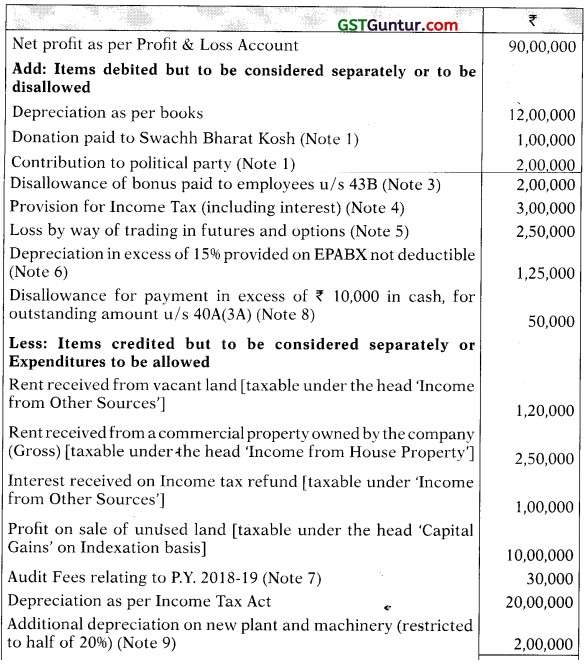


Notes:
(1) Donation made to Swachh Bharat Kosh and contribution to political party is not an allowable expenditure while computing business income. Hence, the same has to be added back, since it is debited from the profit and loss account.
(2) As per section 40(a)(za), 30% of the sum payable to a resident shall not be allowed as a deduction to the assessee, if he has not deducted tax from such payment which is deductible under Chapter XVII-B or after deducting such tax, has not deposited it to the account of the Central Government on or before the due date u/s 139(1). In this case, BM. Pvt. Ltd. has made payment to the contractor on which TDS is deductible u/s 194C of Chapter XVII-B, but no tax was deducted by BM. Pvt. Ltd. and therefore, 30% of the amount paid to transporter shall be disallowed. However, as per section 194C, no tax shall be deducted in case of assessee, engaged in the business of plying & hiring of goods carriage where such contractor owns ten or less goods carriages at any time during the previous year and furnishes a declaration to that effect along with his PAN. Therefore, in this case, no disallowance shall be made from payment made to the transporter by the BM Pvt. Ltd. as the transporter has furnished the declaration to the effect that he is having not more than 10 goods carriages at any time during the previous year along with his PAN.
(3) As per section 43B, any sum payable as bonus or commission to the employees shall be allowed as a deduction to the employer only if it is paid on or before the due date for furnishing the ROI u/s 139(1) and the due date for furnishing ROI u/s 139(1) for the company is 31st October every year (w.e.f. A.Y. 2021-22). In this case, the asses- see-employer BM Pvt Ltd has made payment of bonus to employees on
18.10.2021 which is after the due date of furnishing ROI and therefore, disallowance of bonus paid to employees shall be attracted.u/s 43B.
(4) Provision for income tax (including interest) is not an allowable ex-penditure while computing business income.
(5) As per section 43(5), an eligible transaction of trading in derivatives in stocks in a recognized stock exchange is not a speculative transaction. In this case, the company is engaged in the business of manufacturing and hence, the loss on account of trading in derivatives is not incurred wholly and exclusively in relation to such business and hence, has to be disallowed while computing profits from the business of manufacturing. Trading in derivatives in stocks is also not incidental to the business of manufacturing. Therefore, it has to be assumed that the company is also carrying on the business of trading in derivatives in stocks in addition to its manufacturing business.
In this case, the loss has to be disallowed at the first instance while computing income from the business of manufacturing since it is not wholly and exclusively incurred for the said business and thereafter, loss from trading in derivatives has to be set-off against the profits from manufacturing business applying the provisions of section 70(1) permitting inter-source set-off of losses.

(6) EPABX cannot be included in the block of computers and therefore, are not entitled to higher depreciation @ 40% as for computers [Federal Bank Ltd. v. ACIT (Ker)J. Hence, normal depreciation @ 15% shall be allowed and balance shall be added back.
(7) As per Sec. 40(a)(ia), 30% of any sum payable to a resident on which tax is deductible at source under Chapter XVII-B shall not be allowed as a deduction on which tax has not been deducted or after deduction has not been paid to the credit of Central Government on or before the due date mentioned u/s 139(1) (i.e. due date of filing ROI). ₹ 30,000 being 30% of audit fees of ₹ 1,00,000 provided for in the books of account of F.Y. 2019-20 would have been disallowed due to tax deposited after due date of filing ROI. However 30% of such sum (disallowed in F.Y. 2019-20) shall be allowed as a deduction in the previous year in which such tax has been paid. Therefore ₹ 30,000 shall be allowed as deduction in the previous year 2020-21.
(8) Section 40A(3A) provides that where an allowance has been made in the assessment for any year in respect of any liability for any expenditure incurred by the assessee and subsequently the assessee makes any payment in respect of such liability for a sum exceeding ₹ 10,000 otherwise than by account payee cheque or account payee bank draft or use of electronic clearing system through a bank account or through such electronic mode as may be prescribed, the payment so made shall be deemed to be the Profits and gains of business or profession of the year in which the payment is made. Therefore, payment of outstanding amount of ₹ 50,000 shall be wholly disallowed as it is made in cash in excess of ₹ 10,000.
(9) As per section 32(1)(iia), an assessee engaged in the business of manufacturing of any article or thing shall be eligible for additional depreciation @ 20% on actual cost of any new plant and machinery acquired and installed on or after 01.04.2005. However, such depreciation shall be half of 20%, in case the new plant and machinery is acquired and put to use for less than 180 days during the previous year. In this case, by assuming that the new plant and machinery acquired on 15.10.2020 has been put to use in the same previous year, the assessee BM Pvt Ltd is eligible for additional depreciation of half of 20% on ₹ 20,00,000 i.e. ₹ 2,00,000 and the balance additional depreciation of ₹ 2,00,000 shall be available in the immediately succeeding financial year.
(10) As per section 56(2)(viib), where a closely held company receives in any previous year, from any person, being a resident, any consideration for issue of shares, which exceeds the face value of such shares, then the aggregate consideration received by the company as reduced by the FMV of the shares shall be ‘Income from other sources’ in the hands of the company. In this case, the consideration received by the company is ₹ 1,00,00,000 (1,00,000 shares × ₹ 100 per share) and the FMV of the shares is ₹ 60,00,000 (1,00,000 shares ₹ 60 per share) and therefore, the difference of ₹ 40,00,000 (₹ 1,00,00,000 – ₹ 60,00,000) shall be “Income from Other Sources” in the hands of BM Pvt. Ltd.
(11) Donation paid to Swachh Bharat Kosh is eligible for 100% deduction, without any limit u/s 80G, if it is paid by any mode other than cash., In this case, it is assumed that such donation to Swachh Bharat Kosh is made by any mode other than cash and therefore; BM Pvt. Ltd. is eligible for deduction u/s 80G.
(12) Contribution to political party is allowed as deduction u/s 80GGB from gross total income, subject to the condition that payment is made otherwise than by way of cash. Since the contribution to political party is made in cash, the same does not qualify for deduction u/ s 80GGB.

Question 33.
Jupiter Construction Ltd., an Indian company is engaged in the business of executing civil contracts awarded by various Companies, Central Government and State Governments in relation to infrastructure facility.
Statement of Profit & Loss for the year ended 31st March, 2021 reveals a net profit (before tax) amounting to ₹ 85,00,000 after debiting/’credlting the following items:
(a) Interest of ₹ 3,00,000 due to a public financial institution for the last quarter of the financial year 2020-21 paid on 20th November, 2021.
(b) ₹ 6,00,000 paid in India to Mr. Philip, a non-resident towards fee for technical services without deduction of tax at source. TDS was, however, paid on 30th November, 2021.
(c) Damages amounting to ₹ 25,00,000 paid to the government of West Bengal as per the terms of contract for defects found in construction of a flyover after 5 years of its construction.
(d) Depreciation charged ₹ 20,00,000.
(e) Marked to market loss amounting to ₹ 6,00,000 in respect of an unsettled derivative contract. The contract was settled in May, 2021 with a gain of ₹ 1,00,000. Such loss or gain has not been recognised as per the ICDS.
(j) Profit of ₹ 10,00,000 on sale of land to Neptune Inc., U.S.A., which is a wholly owned subsidiary company.
(g) Retention money amounting to ₹ 10,00,000 held by a public sector undertaking which can be released after expiry of two years on the satisfaction of certain performance criteria as per the terms of contract.
(h) ₹ 3,00,000 being interest on fixed deposit with a bank as margin money for obtaining a guarantee required by a State Government for a particular contract.
(i) Dividend of ₹ 10,00,000 received from Real Estate Investment Trust (REIT), break-up of which is as follows:
- Component of short-term capital gain on sale of development properties by the REIT ₹ 6,00,000.
- Component of rental income from properties owned by the REIT ₹ 4,00,000.
Other Information:
(i) Depreciation as per Income-Tax Rules ₹ 25,00,000.
(ii) Land sold to Neptune Inc. was acquired at a cost of ₹ 30,00,000 in the financial year 2015-16. Value on the date of sale assessed by the Stamp Valuation Authority was ₹ 50,00,000 (Cost Inflation Index Financial Year 2015-16: 254: Financial Year 2020-21: 301)
(iii) The company informs you that till Assessment Year 2020-21 the company did not include retention money in its total income in absence of right to receive such money based on judicial pronouncements, which has also been accepted by the Assessing Officer consistently,
(iv) During the year, 20 new employees (qualifying as “workman” under the Industrial Disputes Act, 1947) were recruited. All these new employees contribute to recognized provident fund. 15 employees out of 20 employees joined on 1st May, 2020 and the other 5 employees joined in November, 2020.10 employees, who joined on 1st May, 2020 were offered salary of ₹ 24,500 per month and the other employees who joined on the same date drew salary of ₹ 32,000 per month. One employee who joined on 1st May, 2020 at salary of ₹ 24,500 per month drew his salary by bearer cheques of ₹ 12,500 and ₹ 12,000 every fortnight in a month.
(v) The company’s.accounts are required to be audited under section 44AB of the Income-Tax Act.
Compute total income for the Assessment Year 2021-22 indicating reasons for treatment for each item and ignoring the provisions relating to minimum alternate tax (MAT). [CA Final Nov 2017] [16 Marks]
Answer:
Computation of total income of Jupiter Construction Ltd. for the A.Y. 2021-22

Notes:
(1) As per section 43B, any sum payable as interest on any loan or borrowing from any Public Financial Institution (PFI) shall be allowed as a deduction only if it is paid on or before the due date for furnishing the ROI u/s 139(1) and the due date for furnishing ROI u/s 139(1) for the company is 31st October every year (w.e.f. A.Y. 2021-22). In this case, the assessee company Jupiter Construction Ltd has made payment of interest to the financial institution on 20.11.2021 which is after the due date of furnishing ROI and therefore, the same shall be disallowed u/s 43B.

(2) Section 40(a) disallows any interest, royalty, fees for technical services or any other sum chargeable under Act which is payable outside India; or in India to a non-resident (not being a company), or to a foreign company on which tax has not been deducted or, after deduction, has not been paid during the previous year, or before the expiry of the time prescribed u/s 139(1). Therefore, amount paid to Mr. Philips (non-resident) without deduction of tax at source and after deduction not deposited within due date of return (31.10.2021) shall be disallowed u/s 40(a).
(3) As per Explanation to section 37(1), any expenditure incurred for an offence or which is prohibited by law, shall not be allowed as deduction. Assuming that the damages of ₹ 25,00,000 paid to the Government of West Bengal for defects found in construction is paid under a law framed by the Government, it will not be allowed as deduction. However, if assumed that the damages are not paid as a penalty for breach of law, but only for the breach of contract, it shall be allowed as deduction.
(4) As per Sec. 36(1)(xviii), Marked to Market loss or other expected loss as computed as per ICDS shall be allowed as deduction. Further, similar consideration applies to recognition of MTM gain or expected income. Therefore, MTM loss of ₹ 6,00,000 shall not be allowed as it is not as per ICDS and hence, to be added back. MTM gain is not recorded in the books of account as arise in May 2021, so no further adjustment is required.
(5) Interest income earned on the margin money deposited with bank for obtaining bank guarantee to carry on the business shall be taxable as business income. CIT v. K and Co. (2014) (Del). As such interest income is already taken in calculation of net profit no further adjustment is required.
(6) As per ICDS III – Construction Contracts, Contract Revenue shall comprise of the initial amount of revenue agreed, including retentions i.e. ICDS III specifically requires retention money to be treated as part j of contract revenue. As such income is already taken in calculation of net profit no further adjustment is required.
Alternative: In CIT v. Associated Cables (P) Ltd. (2006) (Bom.) and CIT v. Ignifluid Boilers Ltd. (2006) (Mad), it was held that the payment of retention money in the case of contract is dependent on satisfactory completion of contract work. The right to receive the retention money accrues only after the obligations under the contract are fulfilled and, therefore, it would not amount to income of the assessee in the year in which the amount is retained.
(7) Short-term capital gain on sale of development properties by the REIT shall be taxable in the hands of Real Estate Investment Trust and the same shall be exempt in the hands of unit holders u/s 10(23FD) read , with section 115UA(1). Rental income from properties owned by the REIT is exempt in the hands of REIT u/s 10(23FCA). The same shall be taxable in the hands of unit holders u/s 115UA(3).

(8) As per Sec. 47(iv), any transfer of capital asset by holding company to j its 100% subsidiary company, being an Indian Company shall not be j regarded as transfer by holding company. Here, in this case, wholly owned subsidiary company is Foreign Company (Neptune Inc. U.S.A). Therefore, benefit of Sec. 47(iv) is not available to Jupiter Construction Ltd. and such transaction shall be treated as transfer and capital gain on such transaction is taxable. Since, profit on such transaction shall be taxable in the head “Capital Gain” the same should be reduced from the net profit of the business.
(9) As per Sec. 50C, where the stamp duty value does not exceed 110% of the actual consideration, the actual consideration so received shall be deemed to be the full value of consideration. But, here, the stamp duty value exceeds 110% of the actual consideration and therefore, the stamp duty value shall be deemed as full value of consideration i.e. ₹ 50,00,000.
(10) Besides the normal deduction of employee cost under the relevant head of income, an additional deduction of 30% of ‘Additional employee cost’ is allowable u/s 80JJAA, where the assessee is a company and its gross total income includes any profits and gains derived from a business and to whom Sec. 44AB applies.
“Additional Employee” means an employee who has been employed during the previous year but does not include:
(a) An employee whose total emoluments are more than ₹ 25,000 per month; or
(b) An employee employed for a period of less than 240 days during the previous year; or
In this case, the company has employed 20 new employees during the P.Y. 2020-21, but only 10 employees has who has been employed during the previous year is to be treated as “Additional Employee” as amount of emoluments paid to this employees is ₹ 24,500 (being less than ₹ 25,000) and are employed during the previous year for more than 240 days.
Further, additional employee cost shall be NIL, if emoluments are paid by any mode other than account payee cheque or account payee bank draft. Therefore, one employee drawing salary by bearer cheques is ineligible for the deduction u/s 80JJAA and deduction shall be available for the emoluments paid to the 9 employees only
Hence, Additional cost shall be ₹ 24,25,500 (9 additional employees × ₹ 24,500 p.m. × 11 months)
Therefore, deduction u/s 80JJAA would be ₹ 7,27,650 (being 30% × ₹ 24,25,500)

Question 34.
BG (P) Ltd. is engaged in multiple businesses. The Net Profit as per the statement of profit and loss was ₹ 52 Iakhs for the year ended 31.03.2021. A scrutiny of the statement of profit and loss revealed the following Items which were debited/credited therein:
(i) Share income @ 25% from a partnership firm ABC & Co. of Pune ₹ 9,50,000.
(ii) The company paid ₹ 1,00,000 as service charges to a call centre for attending the calls of customers and suppliers. Tax was deducted at source on such payment 2%.
(iii) Expenditure Incurred ₹ 8,00,000 for digging of wells near the factory for use by public under Corporate Social Responsibility Scheme as per the Companies Act, 2013.
(iv) Grant received from State Government for acquisition of generator ₹ 10 lakhs. The generator was acquired on 01.06.2020 for ₹ 35 Lakhs. A sum of ₹ 5 lakhs was paid as advance by cash to the supplier of generator. The grant amount received is credited to statement of profit and loss. Depreciation charged on ₹ 35 lakhs @ 15%.
Note: Assume that the company is not eligible for additional depreciation.
(v) During the year, the company bought textile goods from local suppliers. Cash payment was made exceeding ₹ 10,000 but below ₹ 20,000 in a day to 15 suppliers aggregating to ₹ 2,00,000.
(vi) Depreciation debited to statement of profit and loss ₹ 10 lakhs (it includes ₹ 8 lakhs being depreciation on assets revalued).
(vii) Provision for deferred tax debited to statement of profit and loss ₹ 6,50,000.
(viii) Trade creditors ₹ 5,00,000 were outstanding for more than 5 years and there is no business relationship with them. The amount was unilaterally transferred to credit of statement and profit and loss.
(ix) Royalty income in respect of patents chargeable u/s 115BBF ₹ 12,00,000.
(x) Depreciation eligible u/s 32 (before considering adjustment of any of the items described above) ₹ 12,25,000.
Additional Information: ‘
(a) The assessee executed only one civil construction contract of the value of ₹ 15 lakhs. The contractee withheld 20% of the contract amount
which would be released only after 2 years. The amount withheld has not been credited to statement of profit and loss.
(b) During the year 1,00,000 equity shares of ₹ 10 each was issued for ₹ 25 per share. The fair market value of the shares as per rule 11UA of the Income-tax Rules, 1962 was determined @ ₹ 17 per share.
(c) During the year, the company advanced ₹ 5,50,000 to one of the directors (having 22% of equity shares and equivalent voting rights in the company) to meet his personal expenses. The company has accumulated profit of ₹ 25 lakhs as on 31.03.2020.
You are required to compute the total income for the A.Y. 2021-22 stating clearly the reasons for treatment for each of the items given above. [CA Final May 2018 (Old Syllabus)] [16 Marks]
Answer:
Computation of Total Income of BG(P) Ltd. for the A.Y. 2021-22
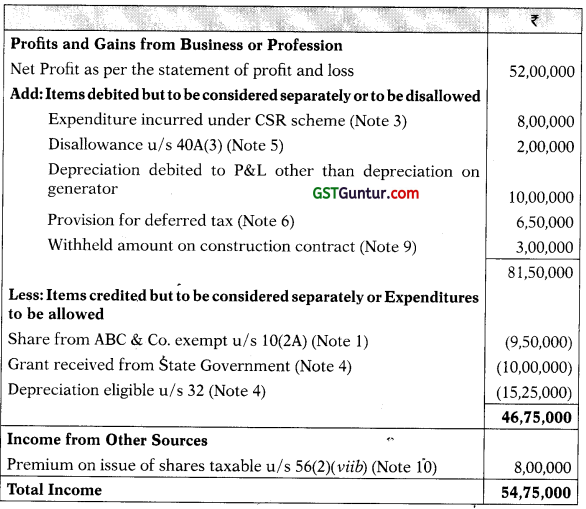
Notes:
1. The share of income received from partnership firm ‘is exempt u/s 10(2A) and therefore, ₹ 9,50,000 being the share of income from ABC & Co. has been deducted from the net profit.

2. As per Sec. 194J, any payment made to a person engaged only in the business of operation of a call centre is liable for deduction of tax at source @ 2%. Since, the company has correctly deducted the tax at source 2%, there is no need of any adjustment.
3. As per Explanation 2 to Sec. 37, any expenditure incurred by an assessec on the activities relating to CSR shall not be deemed to be expenditure incurred by the assessee for the purposes of the business or profession and thereby shall not be allowed as deduction u/s 37. Since, the company has deducted it from the net profit, it has been added back.
4. As per Explanation 10 to Sec. 43(1), where the portion of the cost of an asset acquired is met directly or indirectly by Government or any authority or any other person in the form of a subsidy or grant or reimbursement, then it shall be reduced from the actual cost of an asset. Also, where the assessee incurs any expenditure for acquisition of any asset or part thereof and the payment in respect of which is made to a person in a day otherwise than by an account payee cheque drawn on a bank or an account payee bank draft or use of electronic clearing system through a bank account or through such other electronic mode as may be prescribed exceeds ₹ 10,000, then such expenditure shall be ignored for the purposes of determination of actual cost. Therefore, the grant received from State Government of ₹ 10,00,000 and payment made in cash of ₹ 5,00,000 shall be reduced from the actual cost of the asset and ₹ 20,00,000 (₹ 35,00,000 – ₹ 10,00,000 – ₹ 5,00,000) shall be eligible for depreciation @ 15%.
Here, in the question, it is given that the depreciation eligible u/s 32 of ₹ 12,25,000 is before considering the adjustments relating to the items described therein and therefore, it is possible to assume that the depreciation relating to generator has not been provided yet. So, depreciation relating to generator of ₹ 3,00,000 (₹ 20,00,000 × 15%) shall be provided which makes the total depreciation eligible u/s 32 of ₹ 15,25,000.
Alternative: If it is assumed that the depreciation relating to the generator has been included in the figure of ₹ 12,25,000, then excess depreciation on generator of ₹ 2,25,000 (₹ 15,00,000 × 15%) shall be reduced from ₹ 12,25,000 and the depreciation allowable u/s 32 will be ₹ 10,00,000.

5. As per Sec. 40A(3), where the assessee incurs any expenditure in respect of which payment or aggregate of payments made to a person in a day, otherwise than by an account payee cheque drawn on a bank or account payee bank draft or use of electronic clearing system through a bank account or through such other electronic mode as may be prescribed exceeds ₹ 10,000, then no deduction shall be allowed in respect of such expenditure. Therefore, the cash payment by the company to the suppliers of textile goods exceeding ₹ 10,000 in a day shall be disallowed and it shall be added back.
6. Provision for deferred tax is not an allowable expenditure and therefore, it shall be added back.
7. Sec. 41(1) provides that where any deduction was allowed to the assessee in earlier year in respect of any trading liability incurred by the assessee and subsequently, the assessee has obtained some benefit in respect of such trading liability by way of remission or cessation, then the value of benefit accruing shall be deemed to be the profits and gains of business or profession and accordingly, chargeable to tax in the year in which benefit obtained.
Here, the company has outstanding trade creditors of ₹ 5,00,000 of more than 5 years and there is no business relationship and therefore, the company has unilaterally transferred the amount to the credit of statement of profit and loss account. Since, the amount has been outstanding for more than 5 years and there is no business relationship with the trade creditors, it may be assumed that the creditors had waived off the amount and therefore, the treatment given by the company is correct and no adjustment is required.
8. Royalty income in respect of patent chargeable to tax u/s 115BBF can be treated as business income or income from other sources, depending upon the facts of the case. Here, the question mentions that BG (P) Ltd. is engaged in multiple business, it may be assumed that the same is in respect of business income. Since, the same has already been added to statement of profit and loss account, no further adjustment has been made.
9. As per ICDS-III “Construction Contracts”, retention money shall be treated as part of contract revenue and shall be recognised on the basis of percentage of completion method. In this case, since it is given that the assessee has executed the contract of ₹ 15 lakhs, it is possible to assume that 100% of the contract has been completed in this year and therefore, entire retention money of ₹ 3 lakhs has to be recognised during the previous year.
Alternative: In the question, it is given that the retention money of ₹ 3 lakhs (₹ 15 lakhs × 20%) would be realised after two years, it is also possible to assume that the contract is yet to be completed and therefore, the solution will be work out accordingly.
10. As per Sec. 56(2)(viib), where a closely held company receives from any person, being a resident, any consideration for issue of shares exceeding the face value of such shares, then the aggregate consideration received by the company as reduced by the FMV of the shares shall be treated as “Income from Other Sources” in the hands of the company. Therefore, ₹ 8,00,000 [1,00,000 × (₹ 25 – ₹ 17)], being the excess of consideration over the FMV of the shares shall be treated as “Income from Other Sources” in the hands of BG (P) Ltd.
11. As per Sec. 2(22)(e), any advance or loan given by a closely held company, to the extent of accumulated profits of the company, to a shareholder, being the beneficial owner of shares, carrying not less than 10% of voting power, shall be treated as deemed dividends.
Therefore, the advance of ₹ 5,50,000 given by BG (P) Ltd. to one of the directors having 22% of equity shares with voting rights shall be treated as deemed dividend as BG (P) Ltd. is having the accumulated profits of ₹ 25,00,000. As per the amendment made by the Finance Act, 2020, such deemed dividends will be taxable in the hands of shareholder at regular income tax rates and no DDT shall be payable by the company. Therefore, it will not be included in the total income of the company.

Question 35.
Bose & Co. is a partnership firm consisting of 4 partners with equal shares. The partnership firm is engaged in execution of civil construction contracts with State Government authorities. The partnership firm deposited ₹ 50 lakhs in State Bank of India (SBI) for the purpose of obtaining guarantee as and when the tenders were applied by the firm. It also kept ₹ 10 lakhs in fixed deposit with Canara Bank being the surplus funds of the firm. The firm credited interest on bank deposits of ₹ 4,00,000 from SBI and ? 80,000 from Canara Bank in Profit and Loss account and computed working partners’ salary based on the resultant book profit. The Assessing Officer wants to tax interest incomes as income under the head ‘other sources’ and accordingly reduced the amount allowable by way of working partners’ salary. Is the action of the Assessing Officer tenable in law? [CA Final May 2018 {Old Syllabus)] [4 Marks]
Answer:
Issue involved: The issue is whether the interest on amount deposited with the bank for the purpose of obtaining guarantees and when the tenders were applied by the firm and interest on surplus funds deposited with the bank is taxable as “Profits and Gains of Business or Profession” or “Income from Other Sources”.
Provisions applicable: As per the provisions of Sec. 40( b), salary to a working partner is deductible based on the book profits of the firm. In computing the book profits, only items chargeable as business income alone will be considered, and not those chargeable under the head “Income from Other Sources”.
Income which is chargeable to tax under the Income-tax Act, 1961 would be chargeable under the residuary head “Income from Other Sources, only if such income is not chargeable to tax under any of the four heads of income,”
Analysis: The facts of the case are similar to the case of CIT v. K & Co. (2014), where the Delhi High Court noted that the interest income from the deposits made by the assessee is inextricably linked to the business of the assessee and such income, therefore, cannot be treated as income under the head ‘Income from other sources’.
The margin money requirement was an essential element for obtaining the bank guarantee which was necessary to apply for tenders. If the assessee had not furnished the bank guarantee, it would not be eligible for applying for the tenders. The High ! Court, accordingly, held that such interest income would be taxable under | the head “Profits and gains of business or profession”.
However, in respect of the interest income on fixed deposits made out of surplus funds available with the assessee, it was held by the Supreme Court in the case of Tuticorin Alkali Chemicals & Fertilizers Ltd. CIT (1997) that it would be chargeable to tax under the head “Income from Other Sources” since such surplus funds were deposited with the bank solely for the purpose of earning interest. Such interest income is taxable under the Income Tax Act, 1961 but, since, it does not fall within the scope of the four heads of income, it will be taxable under the head “Income from Other Sources”.
Conclusion: By applying the above rationale, the contention of the A.O. to taxed the interest income of ₹ 4 lakhs on deposits made with the bank for obtaining bank guarantee to apply for tenders under the head “Income from Other Sources” and reducing the amount allowable by way of working partner’s salary is not tenable in law.
However, the action relating to interest income of ₹ 80,000 on fixed deposits made out of surplus funds with the firm, is correct in law.

Question 36.
SDK Ltd. is engaged in the manufacture of textile since 01-04-2012. Its Statement of Profit and loss for the previous year ended 31 March, 2021 shows a profit of ₹ 600 Lakhs after debiting or crediting the following items:
(i) Depreciation charged on the basis of useful life of’assets as per Companies Act is ₹ 40 Lakhs.
(ii) Industrial power tariff concession of ₹ 3.5 Lakhs, received from State Government was credited to P&L Account.
(iii) The company had provided ₹ 25 Lakhs being sum fairly estimated as payable with reasonable certainty, to workers on agreement to be entered with the workers union towards periodical wage revision once in every 3 years.
(iv) Dividend received from a foreign company ₹ 10 Lakhs.
(v) Loss of f 25 Lakhs, due to destruction of a machine worth ₹ 30 Lakhs by fire due to short circuit and ₹ 5 Lakh received as scrap value. The insurance company did not admit the claim of the company on charge of gross negligence.
(vi) Provision for gratuity based on actuarial valuation was ₹ 400 Lakhs. Actual gratuity paid debited to gratuity provision account was ₹ 275 lakhs.
(vii) The company has purchased 500 tons of industrial paper as packing material at a price of ₹ 30,000 per ton from M/s. Shivbramha, a firm
in which majority of the directors of SDK Ltd. are partners. The firm’s normal selling price of the same material in market is ₹ 28,000 per ton.
(viii) Advertisement charges ₹ 1.5 Lakhs, paid by cheque for advertisement published in the souvenir of a political party registered with the Election Commission of India.
(ix) Long-term capital gain ₹ 4.5 Lakhs on sale of equity shares on which Securities Transaction Tax (STT) was paid at the time of acquisition and sale.
Additional Information:
(i) Normal depreciation as per Income Tax Rules is ₹ 65 Lakhs.
(ii) The GST of ₹ 11 Lakhs collected from its customers was paid by the company on the due dates. On an appeal the High Court directed the GST department refund ₹ 4 Lakhs to the company. The company in turn refunded ₹ 3 lakhs to the customers from whom it was collected and the balance ₹ 1 lakh is still lying under the head “Current Liabilities”.
Compute the total income of SDK Ltd. for the A.Y. 2021-22 by analyzing and applying the relevant provisions of income tax law. Briefly explain the reasons for treatment of each item. Ignore the provisions relating to MAT. [CA Final May 2018 (New Syllabus)] [14 Marks]
Answer:
Computation of Total Income of SDK Ltd. for the A.Y. 2021-22

Notes:
1. As per sec. 2(24)(xviii), income shall include assistance received in the form of a subsidy or grant or cash incentive or duty drawback or waiver or concession or reimbursement (by whatever name called) from the Central Government or a State Government or any authority or body or agepcy in cash or in kind to the assessee other than the subsidy or grant or reimbursement which is taken into account for determination of the actual cost of the asset in accordance with the provisions of Explanation 10 to sec. 43(1).
Therefore, the Industrial Power Tariff Concession received by SDK Ltd. from the State Government shall be taxable and to be included in the Income Statement. Since, it has been already credited to statement of profit and loss account, no adjustment is required.

2. If the provision is made for the present obligation resulting from the past events and which may require outflow of resources to settle and reliable estimate can be made, then such provision is allowable as deduction u/s 37(1). Therefore, the provision made to be paid as wage revision on a fair estimation basis shall be allowed as deduction u/s 37(1) to SDK Ltd. Since, the same has already been debited to P&L account, no further adjustment is required.
3. Dividend received from a foreign company shall be taxable in the hands of SDK Ltd. under the head “Income from Other Sources”. If the SDK Ltd. had distributed dividends during the previous year, then it may claim deduction u/s 80M in respect of such dividends received from foreign company upto the amount of dividend distributed by it.
4. As per sec. 40A(7), provision for Gratuity shall be available to the assessee only if it is made for payment to Approved Gratuity Fund or made for Gratuity which has become due and payable during the current previous year. Therefore, in this case, only the actual gratuity paid by SDK Ltd. shall be eligible for deduction and provision of ₹ 125 lakhs [₹ 400 lakhs – ₹ 275 lakhs] shall be disallowed.
5. As per sec. 40A(2), where in case an assessee being a company, incurs any expenditure for which the payment has been made or is to be made to a specified person i.e. in this case, to a firm in which the director or directors of the company has substantial interest, and such expenditure in the opinion of A.O. is excessive and unreasonable having regard to the fair market value of the goods, then such expenditure shall be disallowed to the extent considered as excessive or unreasonable by the A.O.
Therefore, in this case, by assuming that the Directors of SDK Ltd. are having substantial interest in the firm Shivbrahma, the excess amount of ₹ 10,00,000 [(₹ 30,000 – ₹ 28,000) × ₹ 500 per ton] shall be disallowed.
6. Expenditure incurred on advertisement published in the souvenir of registered political party shall be disallowed u/s 37(2B). However, it shall be allowed as a deduction from the gross total income of the company-assessee u/s 80GGB for the amount contributed by any mode other than cash. Therefore, deduction shall be available to the SDK Ltd. in respect of expenditure incurred on advertisement published in the souvenir of registered political party u/s 80GGB, since the payment has been made by way of cheque.
7. As per the amendment made by the Finance Act, 2018, the exemption u/s 10(38) shall not be available for the transfer made on or after 01.04.2018. The long term capital gains exceeding ₹ 1,00,000 arising from transfer of equity shares made on or after 01.04.2018, where the STT has been paid on acquisition and transfer of such shares, shall be taxable @ 10% u/s 112A, as inserted by the Finance Act, 2018.
8. It was held in the case of Thirumalaiswamy Naidu & Sons that the re-fund of sales tax (now GST) shall be taxable to the extent not refunded to the customers, since it is a remission of liability to be taxable u/s 41(1). Therefore, SDK Ltd. shall be taxable for refund of GST of ₹ 1 lakh [₹ 4 lakhs – ₹ 3 lakhs] not refunded to the customers u/s 41(1).
9. Scrap value of machinery shall be reduced from the WDV of machinery. Since, it has been credited to the statement of profit and loss, it shall be deducted while computing business income.

Question 37.
M/s. Gomati P Ltd., a closely held company is in the business of growing rubber. The Profit & Loss account for the year ended 31.03.2021, of the company shows a Net profit f 37.65 crores after debiting Depreciation of ₹ 30 crores.
The company has provided the following additional information:
(i) The company has deposited ₹ 30 crores in a special Account with NABARD on 29.04.2021.
(ii) The company has brought forward losses of ₹ 6 crores pertaining to Assessment Year 2018-19. Mr. A who continuously held 60% of shares carrying voting power since incorporation of the company, had sold his entire holding to Mr. B on 01-08-2020.
(iii) The company had an accumulated balance of ₹ 200 crores in the special account with NABARD as on 01-04-2020. It has withdrawn 40 crores and utilized the same for the following purposes.
- Purchase of a new sprinkling machine for use in its operation ₹ 10 crores.
- Purchase of office appliances for corporate office at Chennai ₹ 10 crores.
- Purchase of computers and accessories ₹ 5 crores.
- Construction of a godown at a cost of ₹ 1 crore near the rubber estate to store raw rubber.
- Repairs to machinery ₹ 35 lakhs.
(iv) On 31 -03-2021, the company has sold machinery which was purchased on 10-05-2012 for ₹ 10 crores. The purchase of the said machinery was in accordance with the scheme of deposit.
(v) Depreciation allowable as per Tax Audit Report is ₹ 28 crores. Compute Taxable and Exempt income of M/s. Gomati (P) Ltd. [CA Final May 2018 (New Syllabus)] [8 Marks]
Answer:
Computation of Taxable and Exempt income of M/s. Gomati (P) Ltd. for AY. 202 1-22
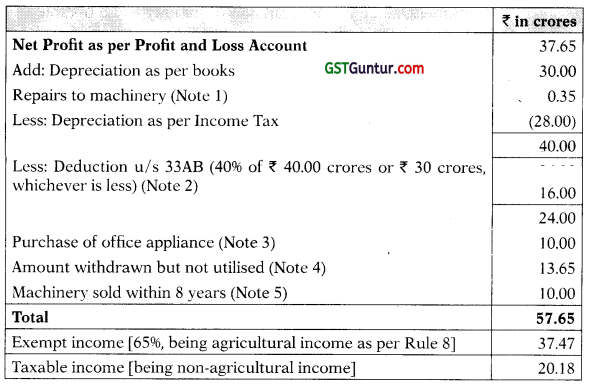
Notes:
1. Where any amount standing to the credit of the assessee in the special account with NABARD is utilised by the assessee for the purposes of any expenditure in connection with the business of the assessee as per the scheme, then such expenditure shall not be allowed in computing the income under the head “Profits and Gains of Business or Profes-sion”.
Therefore, the amount withdrawn from the special account with NABARD and utilised for the purpose of repairs to machinery shall not be allowed as deduction in computing the income under the head “Profits and Gains of Business or Professions by assuming that it has been incurred in accordance with the scheme. However, if the same has not been incurred in accordance with the scheme, then it may be taxable as profits and gains of business of the assessee. Here, it is assumed that M/s. Gomati P. Ltd. has debited ₹ 35 lakhs in respect of repairs to machinery to statement of profit and loss account and therefore, it has been added back.

2. As per sec. 33AB, where any assessee carrying on the business of growing and manufacturing of tea, coffee or rubber in India, deposits any amount with NABARD under a scheme approved by the Tea/ Coffee/Rubber Board within 6 months from the end of previous year or before the due date of furnishing return of income, whichever is earlier, then he shall be allowed a deduction of 40% of profits from such business (before deducting b/f business loss) or the amount deposited, whichever is lower.
3. Where any amount standing to the credit of the assessee in the special account with NABARD is withdrawn during any previous year and utilised for the purchase any office appliances (not being computers), then the amount so utilised shall be deemed to be profits and gains of business of that previous year and shall accordingly be chargeable to tax as income of that previous year.
Therefore, the amount withdrawn from the special account with NABARD and utilised for purchase of office appliances for corporate office at Chennai shall be deemed to be profits and gains of business of the RY. 2020-21 and shall accordingly be chargeable to tax as income of P.Y. 2020-21. However, the amount utilised for purchase of a new sprinkling machine and for purchase of computers and accessories shall not be deemed as income of M/s. Gomati (P.) Ltd., since, there is no restriction on purchase of such machinery u/s 33AB.
4. Where any amount standing to the credit of the assessee in the special account with NABARD is withdrawn during any previous year but not utilised by the assessee within the previous year in which it is withdrawn, then the amount not so utilised shall be deemed to be profits and gains of business of the previous year in which the amount is withdrawn. Therefore, ₹ 13.65 crores not so utilised during the P.Y. 2020-21 shall be deemed as profits and gains of business of M/s. Go-mati P Ltd. for the P.Y. 2020-21.
5. Where any asset acquired as per the scheme is sold or otherwise transferred within 8 years from the end of the previous year in which it was acquired, then the deduction so allowed earlier in respect of such asset u/s 33AB shall be deemed to be the profits and gains of business or profession of the previous year in which the asset is sold or otherwise transferred. Here, the machinery purchased on 10.05.2012 is sold on 31.03.2021 by M/s Gomati (P.) Ltd. i.e. within 8 years from the end of the previous year in which acquired, and therefore, it shall be deemed as profits and gains of business or profession for the P.Y. 2020-21.
6. As per Sec. 79, where there has been a change in shareholding of a company in which the public are not substantially interested i.e. closely held company, any loss which is to be carried forward shall be allowed to be carried forward and set off against the income of the previous year only if the shares carrying atleast 51 % of the voting power on the last day of such previous year and as on the last day of the previous year in which the loss is incurred were beneficially held by the same shareholders.
Here, Mr. A who continuously held 60% shares carrying power in Gomati P Ltd. since incorporation, has sold his entire share-holding to Mr. B on 01.08.2020. Therefore, the loss pertaining to A.Y. 2018-19 of ₹ 6 crores shall not allowed to be set-off against the income of Gomati P Ltd. for the P.Y. 2020-21, since atleast 51% of the shares carrying voting power were not beneficially held by the same persons as on the last day of such previous year i.e. 2020-21 and as on the last day of the previous year in which the loss is incurred i.e. 2020-21.

Question 38.
Dr. Juhi reports to you that her gross receipt from her medical profession for the year ended 31.03.2021 is ₹ 49,20,000. Her net income as per income and expenditure account is ₹ 26,40,000 before adjustment of depreciation of ₹ 2,10,000. She did not pay any amount by way of advance tax during the financial year 2020-21. She has two residential house properties, of which one is self-occupied for residence and another is let out for the monthly rent of ₹ 10,000 during the financial year 2020-21.
Advise Dr. Juhi with reference to section 44ADA on filling of return with optimal tax liability besides compliance cost.
Assume that she approached you in April, 2021 and you have given your advise then. Ignore Sec. 115BAC. [CA Final May 2018 (New Syllabus)] [7 Marks]
Answer:
As per Sec. 44ADA, where gross receipts of a resident assessee engaged in the profession does not exceed ₹ 50,00,000, he can opt for presumptive tax provisions u/s 44ADA.
Also, all the deductions allowable u/s 30 to 38 are deemed to have been given full effect to and therefore, no deduction in respect of depreciation would be available from the income computed on presumptive basis u/s 44ADA.
Calculation of Total Income u/s 44 ADA

Calculation of tax and interest liability under presumptive taxation scheme as per Sec. 44ADA

Calculation of Total Income under normal provisions
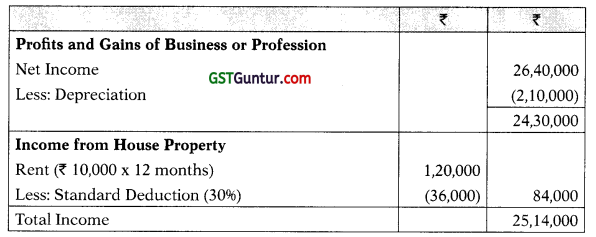
Calculation of tax and interest liability under normal provisions

Notes:
1. As per Sec. 234B, where in any financial year, an assessee who is liable to pay advance tax has failed to pay such tax or where the advance tax paid is less than 90% of the assessed tax, the assessee shall be liable to pay simple interest @ 1% for every month or part of a month from 1st. April next following such financial year to the date of determination of total income u/s 143(1) and where a regular assessment is made, to the date of such regular assessment, on an amount equal to the assessed tax or on the amount by which the advance tax paid falls short of the assessed tax. In this case, Dr. Juhi has not paid her advance tax during the F.Y. 2020-21 and therefore, she will be liable to pay interest u/s 234B on the assessed tax. Since, Dr. Juhi has approached in April, 2021, it may be assumed that she will pay the tax on or before 30.04.2021 and therefore, she will be liable for interest u/s 234B only for 1 month under both the options i.e. normal provisions or presumptive income scheme u/s 44ADA.

Calculation of interest u/s 234B

2. Interest u/s 234C under presumptive taxation scheme u/s 44ADA
Where the assessee has opted to pay the tax as per the provisions of Sec. 44ADA, then he is required to pay the whole of the advance tax in one instalment on or before the 15th March of each financial year. As per sec. 234C, where the assessee fails to pay the whole of the advance tax upto 15th March, then he shall be liable to pay the simple interest @1% for 1 month on the amount of advance tax due.

Interest u/s 234C under normal provisions
As per Sec. 234C, where in any financial year, the assessee (other than the assessee who declares profits and gains in accordance with Sec. 44AD or 44ADA) failed to pay the advance tax, then the assessee shall be liable to pay the simple interest @ 1% on the amount of shortfall of the advance tax due as follows:
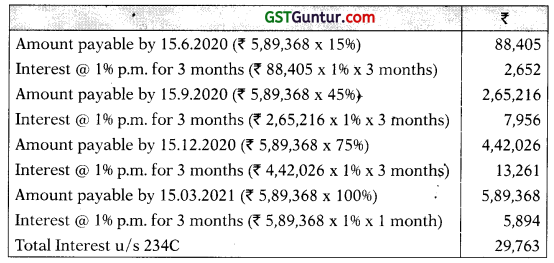

Question 39.
Y. Ltd. was amalgamated with X Ltd. in accordance with a scheme of amalgamation. Assets and liabilities were transferred and vested with X. Ltd. X. Ltd. is of the view that excess consideration paid by it over the value of net assets acquired from Y. Ltd. should be considered as goodwill arising on amalgamation. X. Ltd. claimed depreciation on such goodwill, but the claim was rejected by the A.O. on the ground that goodwill is not an asset falling under Explanation 3 to section 32(1). Is the action of the Assessing Officer valid? [CA Final Nov. 2018 (Old Syllabus), May 2013] [4 Marks]
Answer:
The issue under consideration is whether X Ltd. can claim depreciation on the excess consideration paid by it over the value of net assets acquired from Y Ltd. in a scheme of amalgamation, by treating the same as goodwill, and considering it as an intangible asset within the meaning of Explanation 3 to section 32(1).
The facts of the case are similar to the facts in CIT v. Smifs Securities Ltd. (2012), where the Supreme Court observed that Explanation 3 to section 32(1) states that the expression ‘asset’ shall mean an intangible asset, being know-how, patents, copyrights, trademarks, licences, franchises or any other business or commercial rights of similar nature.
A reading of the words ‘any other business or commercial rights of similar nature’ in Explanation 3(b) indicates that goodwill would fall under the said expression. In the process of amalgamation, the amalgamated company had acquired a capital [ right in the form of goodwill. Therefore, it was held that ‘Goodwill’ is an asset under Explanation 3(b) to section 32(1) and depreciation thereon is I allowable under the said section as an intangible asset.
By applying the above rationale, the action of the A.O. in rejecting the claim I of depreciation made by X Ltd. is, therefore, not valid.

Question 40.
Anil Food Products (P) Ltd. is engaged in manufacturing and selling various food products. It engaged two transporters for carrying its products to various distributors. In previous year 2020-21, it made payments to two transporters towards freight charges without deduction of tax at source. In course of assessment, the Assessing Officer disallowed 30% freight charges invoking section 40(a)(ia) for failure to deduct tax at source. The assessee contends that section 40(a)(ia) is not applicable as the amount of freight was not ‘payable’ at the year-end, but had been actually paid during the previous year. Examine the correctness of the contention of the assessee. [CA Final Nov. 2018 (Old Syllabus)] [4 Marks]
Answer:
The issue under consideration is whether the provisions of section 40(a) (ia) would be attracted on the amount of freight which was not ‘payable’ at the year-end but has been actually paid during the previous year.
The facts of the case are similar to the facts in Palam Gas Service v. CIT [2017] where the Supreme Court observed that when the entire scheme of obligation to deduct tax at source and paying it over to the Central Government is read holistically, it cannot be held that the word ‘payable’ occurring in Sec. 40(a)(ia) refers to only those cases where the amount is yet to be paid and does not cover the cases where the amount is actually paid. Therefore the Supreme Court held that the word ‘payable’ usgd in Sec. 40(a)(ia) includes not only the amount which is payable as of 31st March but also includes the amount ‘paid’ during the year.
Applying the above rationale, the contention of Anil Food Products (P) Ltd. that the provisions of section 40(a)(ia) would not be attracted on the amount of freight which was not ‘payable’ at the year-end but has been actually paid during the previous year is, thus, not correct.

Question 41.
Statement of Profit and Loss account of BAS Industries Ltd. engaged in production and marketing of diversified products, shows a net profit (before tax) of ₹ 72,00,000 for the financial year ended 31st March, 2021 after charge of the following items:
A : Items debited to the Statement of Profit and Loss:
(i) Depreciation as per Companies Act, 2013: ₹ 24,00,000
(ii) Interest amounting to ₹ 60,000 for short payment of advance tax paid as per section 234B relating to the assessment year 2019-20.
(iii) Interest and borrowing costs amounting to ₹ 9,50,000 and 7,00,000 though not meeting the criteria for recognition as a j component of cost, included in cost of opening and closing inventory, respectively.
(iv) Expenditure of ₹ 41,000 paid in cash comprising of ₹ 22,000 directly paid to producer of dairy farming products and ₹ 19,000 paid towards printing and stationery items to a trader.
(v) ₹ 3,50,000 paid to a contractor for carrying out repair work at factory premises. Tax was not deducted at source on this payment.
(vi) ₹ 35,000 towards expenditure for earning income from transfer p of carbon credits.
(vii) Contribution to electoral trust: ₹ 3,00,000 paid by way of cheque.
(viii) Expenditure towards advertising charges in a brochure of a political party registered u/s 29A of Representation of People Act, 1951: ₹ 40,000 paid by way of cheque.
(ix) Interest on term loans obtained from Cooperative Bank not paid I before the due date of filing of return of income (due date being 31.10.2021): ₹ 2,60,000
(x) Actual contribution to the pension scheme of employees: ₹ 1,50,000

B: Items credited to the Statement of Profit and Loss:
(i) Unrealised rent of ₹3,80,000 pertaining to financial years 2017-18 & 2018-19 recovered during the year in respect of a commercial property owned by the company, which was sold by the company on 23.03.2020.
(ii) Profit of ₹ 3,00,000 received from hedging contract entered into for meeting out loss in foreign currency payments towards an
imported printing machinery valued at ₹ 95 lakhs, installed on 15th December, 2020 and put to use from that date.
(iii) Interest from banks on fixed deposits net of TD Sat 10%: ₹ 1,35,000
Additional Information:
(1) Depreciation as per Income-tax Rules: ₹ 28,00,000 exclusive of depreciation on the imported printing machine referred to in item B (iii)
(2) Expenditure pertaining to previous financial year allowed on due basis, but paid in current financial year in cash on 18.01.2021: ₹ 35,000
(3) Audit fee for the previous year 2019-20: ₹ 75,000. TDS deducted but not paid in the relevant previous year. However, TDS was paid on 31.12.2020.
(4) Income from transfer of Carbon Credits amounting to ₹ 4,00,000 included in Net Profit (before tax).
(5) The eligible salary and dearness allowance for the pension scheme referred to u/s 80CCD is ₹ 10,00,000.
Compute the total income of BAS Industries Ltd., for assessment year 2021-22. Give brief reasons for the treatment given to each of the items taken into consideration in computation of income of the company. [CA Final Nov. 2018 (Old Syllabus)] [16 Marks]
Answer:
Computation of Total Income of BAS Industries Ltd..for the A.Y. 2021-22
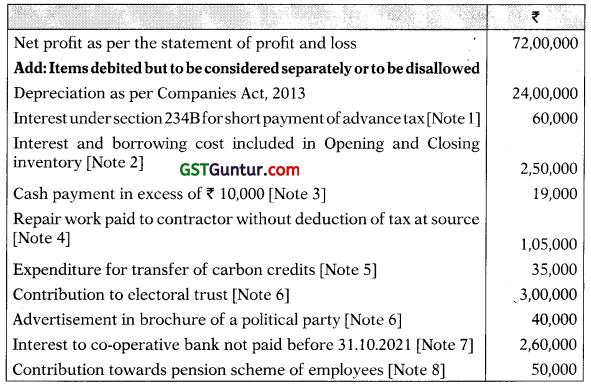
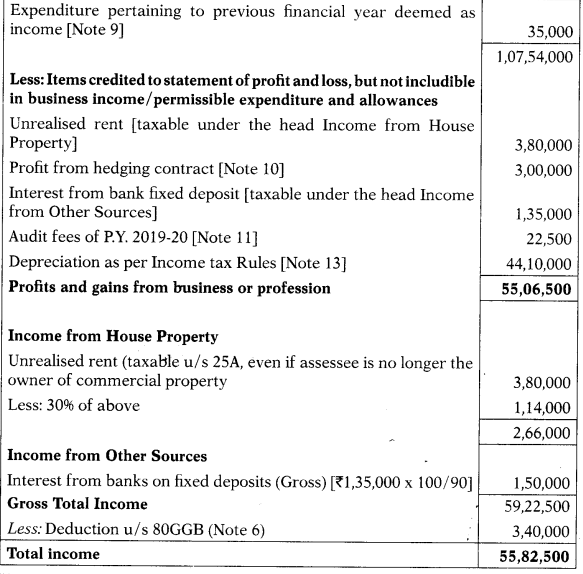
Notes:
1. Any interest payable for default committed by assessee for discharging his statutory obligations under Income-tax Act, 1961 is not allowable as deduction.

2. As per ICDS II, interest and borrowing cost which does not meet the criteria for recognition as a component of the cost, cannot be included in the cost of inventory. Since the same have been included in the opening and closing inventory, the difference of ₹ 2,50,000 (₹ 9,50,000 – ₹ 7,00,000) has to be added back.
3. Disallowance u/s 40A(3) is attracted in respect of expenditure, for which payment exceeding ₹ 10,000 in a day has been made in cash. Therefore, expenditure of ₹ 19,000 towards printing and stationery items for which payment is made in cash has to be disallowed. However, payment of ₹ 22,000 to producer for dairy farming products is not disallowed since it is covered under the exceptions specified in Rule 6DD.
4. 30% of the amount of ₹ 3,50,000 paid for carrying out repair work to a contractor without deduction of tax at source shall be disallowed u/s 40(a)(ia).
5. Income by way of transfer of Carbon Credits is chargeable to tax u/s 115BBG at a flat rate. No deduction is allowed under any provision of the Act in respect of any expenditure or allowance in relation thereto. Since such expenditure is debited to the statement of profit and loss, the same has to be added back.
6. Contribution to electoral trust and advertisement charges in respect of brochure published by a political party is not deductible u/s 37 since it is not laid out wholly and exclusively for the purposes of business or profession. However, donation made by a company to an electoral trust or registered political party is allowable deduction u/s 80GGB from gross total income, subject to the condition that payment is made otherwise than by way of cash. Since, the contribution to an electoral trust and payment in respect of advertisement charges for a political party is made by way of cheque, the same shall be allowed if as deduction u/s 80GGB.
7. Interest on term loans obtained from Co-operative bank shall be dis-allowed u/s 43B, since the interest was not paid on or before the due date of filing of return i.e. 31.10.2021.
8. Contribution towards pension scheme, referred to in section 80CCD, of employees is allowed only to the extent of 10% of salary of the employee in the previous year i.e., ₹ 1,00,000 being 10% of ₹ 10,00,000. Therefore, the excess contribution of ₹ 50,000 [i.e., ₹ 1,50,000 – ₹ 1,00,000] shall be disallowed u/s 36(1 )(iva).
9. Cash payment in excess of ₹ 10,000 made in the current year in respect of expenditure allowed on mercantile basis in the previous year, would be deemed as income in the current year u/s 40A(3A).
10. Hedging contract is entered into for safeguarding against any loss that may arise due to currency fluctuation. The profit from such contract entered into for meeting loss in foreign currency payments towards imported printing machinery has to be adjusted against the cost of machinery. Since the said profit has been credited to the statement of profit and loss, the same has to be deducted while computing business income.
11. 30% of ₹ 75,000, being the audit fees disallowed in the P.Y. 2019-20 for non-remittance of TDS on or before due date of filing for P.Y. 2019-20 would be allowed in the year of payment of TDS i.e., P.Y. 2020-21.

12. Income by way of transfer of Carbon Credits chargeable u/s 115BBG can be treated as business income or income from other sources, depending upon the facts of the case. In this case, since the question mentions that BAS Industries Ltd. is engaged in production and marketing of diversified products, it is logical to assume that the same is in the nature of business income. Since the amount of ₹ 4 lakh has already been credited to statement of profit and loss, no further adjustment is necessary
13. Calculation of Depreciation:
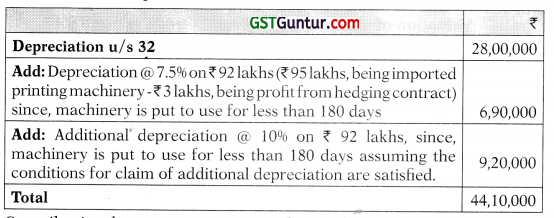
14. Contribution by a company to an electoral trust, and registered political party is allowable as deduction u/s 80GGB, since payment is made otherwise than by cash. Also, expenditure incurred by an Indian I company on advertisement in brochure published by political party tantamount to contribution to such political party. Therefore, BAS j Industries Ltd. is eligible for deduction of ₹ 3,40,000 (₹ 3,00,000 + ₹ 40,000).

Question 42.
SG Securities Private Ltd. is engaged in the business of trading in shares and securities. The details of shares held by it as stock-in-trade as on 31st March, 2021 are given below:

The company values its year-end stock-in-trade in accordance with Accounting Standard (AS) 13 – “Accounting for investments of the Companies (Accounting Standards) Rules, 2006”.
Determine the amount of adjustments, if any, required to be made in computation of income for A.Y. 2021-22. [CA Final Nov 2018 (Old Syllabus)] [5 Marks]
Answer:
As per AS 13, current investments are carried in the financial statements at the lower of cost and fair value determined either on an individual investment basis or by category of investment. However, the more prudent and appropriate method is to carry investments individually at the lower i of cost and fair value. Here, net realizable value (NRV) can be taken as fair value.
Valuation of shares held as stock in trade as per AS 13

ICDS-VH1 on securities requires securities held as stock-in-trade to be valued at actual cost initially recognised or net realisable value (NRV) at the end of that previous year, whichever is lower. It also requires the comparison of actual cost initially recognised and net realisable value to be done category wise and not for each individual security.
Valuation of shares held as stock in trade as per ICDS VIII
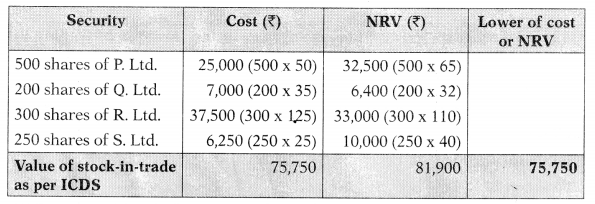
SG Securities Pvt. Ltd. is required to value its shares held as stock in trade at ₹ 75,750 as per ICDS VIII for income-tax purpose. Accordingly, its income would be increased by ₹ 5,100 (₹ 75,750 – ₹ 70,650).
Note: AS 13 also permits valuation of shares on category of investment basis, in which case, there would be no increase in total income under the Income-tax Act, 1961.

Question 43.
M/s. Hind Udyog, a manufacturing partnership firm, consisting of three partners namely X, Y and Z, provides following information relating to the year ending on 31.03.2021:
Net profit of ₹ 28.75 Lakhs, as per profit and loss account, was arrived at after debiting/crediting the following items:
(i) The firm had provided an amount of ₹ 2 lakhs being sum estimated as payable to workers based on agreement to be entered with the workers union towards periodical wage revision once in three years. The provision is based on a fair estimation on wage and reasonable certainty of revision once in three years.
(ii) Sale proceeds of import entitlements amounting to ₹ 1 lakh have been credited to profit and loss account which the firm claims as capital receipt not chargeable to income tax.
(iii) Goods and Services Tax demand paid includes an amount of ₹ 5,300 charged as penalty for delayed filing of returns and ₹ 12,750 towards interest for delay in deposit of tax.
(iv) A free air ticket was provided by a supplier for reaching a certain volume of purchase during the F.Y. 2020-21. The same is not credited in profit & loss account because it was encashed by the firm for ₹ 2 lakhs in April 2021.
(v) Interest amounting ₹ 20,000 paid to X as a Karta of HUF @ 18% per annum.
(vi) The firm had taken on lease an old building for the purpose of locating its business. Due to old age of building, it was demolished and a new building put up, which was used by the firm from September, 2020. The cost of new building ₹ 10 lakh was written off as revenue expenditure. The lessor permitted the firm to have an extension of the lease by another 20 years.
(vii) Loss incurred in transactions of purchase and sale of shares (without delivery) of various companies ₹ 3 lakhs.
(viii) A scheduled bank sanctioned and disbursed a term loan in the financial year 2017-18 for a sum of ₹ 50 lakhs. Interest of ₹ 8 lakhs was in arrears. The bank has converted the arrear of interest into a new loan repayable in 10 equal instalments. During the year, the company has paid 2 instalments and the amount so paid has been reduced from Funded Interest in the Balance Sheet.

The firm furnishes following additional information relating to it:
(1) Provision for audit fees ₹ 2.5 lakhs was made in the books for the year ended on 31.03.2020 without deducting tax at source. Such fees were paid to the auditors in September, 2020 after deducting tax u/s 194J and the tax so deducted was deposited on 7th November, 2020.
(2) The firm had made an investment of ₹ 23 lakhs and ₹ 12 lakhs on the construction of two warehouses (excluding the cost of land), in rural areas for the purpose of storage of agricultural produce and edible oil respectively. These were made available for use from 15.09.2020. The profits from setting of these warehouses (before claiming deduction u/s 35AD and 32) for the A.Y. 2021-22 is ₹ 15 lakhs and ₹ 5 lakhs respectively.
(3) In July, 2020 firm received a dividend of ₹ 11 lakhs from A Ltd. in which it holds 10% of shares.
Compute the total income of M/s Hind Udyog for the A.Y. 2021-22 by analysing, integrating and applying the relevant provisions of Income tax law. Explain in brief, the reasons for the treatment of each item. [CA Final Nov. 2018 (New Syllabus)] [14 Marks]
Answer:
Computation of Total Income of Hind Udyog for the A.Y. 2021-22

Notes:
1. If the provision is made for the present obligation resulting from the past events and which may require outflow of resources to settle and reliable estimate can be made, then such provision is allowable as deduction u/s 37(1). Therefore, the provision made to be paid as wage revision on a fair estimation and probable revision basis shall be allowed as deduction u/s 37(1) to M/s. Hind Udyog. Since, the same has already been debited to profit and loss account, no further adjustment is required.

2. Sale proceeds of import entitlements are taxable as business income under section 28. As the amount has already been credited to Profit and Loss Account, no further adjustment is required.
3. Interest on GST demand is an allowable expenditure since it is incurred wholly and exclusively for the purpose of business of the assessee.
4. As per Sec. 37(1), any expenditure incurred by an assessee which is for an offence or which is prohibited by law shall not be deemed to be an expenditure incurred by the assessee for the purposes of business or profession and thereby shall not be allowed as deduction. Hence, Penalty on GST shall not be allowed as deduction.
5. As per Sec. 28(iv), the value of any benefit, whether convertible into money or not, arising from business is taxable as business income. Therefore, the value of free air ticket provided by a supplier for reaching a certain volume of purchase is taxable as business income in the A.Y. 2021-22 though it is encashed in A.Y. 2022-23.
6. Since X is a partner in his individual capacity, interest paid to the X as a karta of Hindu Undivided Family will not be subjected to the provisions of Sec. 40(b) and the same will be allowed as deduction u/s 36(l)(m) to M/s. Hind Udyog.
7. As per Explanation 1 to Sec. 32, depreciation can be claimed on the Capital Expenditure incurred on a Building; even though the building is not owned by the assessee but in respect of which he holds a lease or any other right of occupancy. Such capital expenditure will be deemed as the building owned by the assessee. Since, the cost of the new building shall be capitalized and shall not be allowed as revenue expenditure, ₹ 10,00,0000 debited to statement of profit and loss shall be added back and depreciation of ₹ 1,00,000 (₹ 10,00,000 × 10%) shall be deducted from statement of profit and loss.
8. Loss incurred in transactions of purchase and sale of shares (without delivery) is a loss on speculative transaction and can be set-off only against profit op speculative transaction.
9. Conversion of unpaid interest into loan shall not be construed as payment of interest for the purpose of section 43B. The amount of unpaid interest converted into a new loan will be allowable as deduction only in the year in which such converted loan is actually paid. Since ₹ 1,60,000 (2 Instalment) has been paid in the P.Y. 2020-21, the same is allowable as deduction.

10. As per section 40(a)(ia), 30% of any sum payable to a resident on which tax is deductible at source shall not be allowed as a deduction on which tax has not been deducted or after deduction has not been paid to the credit of Central Government on or before the due date of filing ROI u/s 139(1).
However, if tax has been deducted in any subsequent year, or has been deducted during the previous year but paid after the due date specified u/s 139(1), then 30% of such sum (disallowed earlier) shall be allowed as a deduction in the previous year in which such tax has been paid.
In this case, the tax deducted at source on audit fees of P.Y. 2019-20 was deposited on 07.11.2020 and therefore, 30% of such sum will be disallowed for the P.Y. 2019-20. But, since, it is paid in the P.Y. 2020-21, it will be allowed as deduction in the P.Y. 2020-21.
11. As per Sec. 3 5AD, where the assessee incurs any capital expenditure wholly and exclusively for the specified business, he shall be allowed deduction, if he so opts, for the whole of such capital expenditure in the previous year in which such expenditure is incurred. Specified business includes “setting up and operating a warehousing facility for storage of agricultural produce” and therefore, M/s. Hind Udyog will be allowed deduction of ₹ 23,00,000 u/s 35AD incurred on construction of warehouse for storage of agricultural produce. However, no deduction shall be available for capital expenditure incurred on construction of warehouse for storage of edible oil, since it is not a specified business u/s 35AD. Also, the loss of a specified business shall be set off only against the profits of specified business and therefore, the loss of ₹ 8,00,000 shall not be set off against the profits of other business and it shall be carried forward to the following years.

Question 44.
M/s. Jonga and Jonga decided to expand its jeep product line and entered into an agreement with K Inc., an American company, which agreed to sell its dies, welding equipment and die models. The purchase consideration was agreed at $ 65,000 including cost, insurance and freight and K Inc., agreed to advance a loan to the assessee at 6% interest per annum repayable after 10 years in instalments. The Reserve Bank of India j and the concerned Ministry approved the loan agreement.
Later on, XL Inc., took over K Inc., and agreed to waive the principal amount of loan advanced by K Inc., to Jonga and Jonga and to cancel the promissory notes as and when they matured. This was communicated to the assessee-company which filed its return showing ₹ 35 Lakh as cessation j of liability in its books of account.
The Income-tax Officer concluded that the waiver of the loan amount represented income and held that the sum of ₹ 35 Lakh is taxable u/s 28(iv) as income. The alternate argument of the Revenue authorities was that the sum would be taxable u/s 41(1) as a waiver of a trading liability, Examine the validity of Assessing Officer’s action. [CA Final May 2019 (Old Syllabus)] [4 Marks]
Answer:
The issue under consideration is whether the sum due by the assessee, : M/s. Jonga and Jonga, to K Inc, which has been waived off later on by XL Inc. (which took over K Inc.), constitutes taxable income in the hands of the assessee.
The fasts of the case are similar to the facts in CIT v. Mahindra and ; Mahindra Ltd. (2018), wher e the Supreme Court observed that Sec. 28(iv) is applicable only if the income arises Ironi business or profession and the benefit received is in non-monetary form. The amount of ₹ 57,74,064, being j a cash receipt, therefore, does not fall u/s 28(iv). Fair applicability of Sec. 41(1), the assessee-company should have claimed an allowance or deduction in any assessment year in respect of a trading liability and subsequently, the creditor has waived such liability. In this case, the loan was taken for procurement of capital assets (plant, machinery and tooling equipment) and therefore, waiver of such loan would not tantamount to cessation of a trading liability. The Supreme Court, accordingly, held that the amount of loan waived w’ould not be taxable either u/s 41(1) or u/s 28(iv).
In the instant case, the loan was taken for procurement of capital assets, namely, plant, machinery and tooling equipment. The purchase amount had not been debited to the trading account or to the profit and loss account in any of the assessment years. Hence, waiver of such loan would not tantamount to cessation of a trading liability. Thus, the action of Assessing Officer is not correct. The amount of loan waived would not be taxable either under section 41(1) or under section 28(iv).

Notes:
(1) As per section 2(24)(xviii), assistance in the form of waiver by the Central Government or State Government or any authority or body or agency in cash or kind to the assessee would be included in the definition of “income”. In this case, the waiver is by a foreign company, and hence, is not included within the scope of definition of “income” under section 2(24).
(2) Further, it may be noted that as per Explanation 10 to section 43(1), deduction on account of, subsidy or grant or reimbursement, by whatever name called, received from any person has to be made while computing actual cost. Since waiver has not been expressly included in the said Explanation, it is possible to take a view that the same is not deductible while computing the actual cost. However, if a view is taken that “waiver” is included within the scope of the phrase “by whatever name called” in the said Explanation, then, the same has to be deducted while computing actual cost.
Question 45.
Mr. Robert, a non-resident, (aged 38) operates a ship for the carriage of goods, passengers and livestock between Dubai, Mumbai and Chennai, i He provides you the following particulars for the previous year 2020-21:
(i) Received ₹ 200 Lakhs in India on account of carriage of livestock from Mumbai to London.
(ii) Received ₹ 50 Lakhs in India on account of carriage of passengers from Dubai to Colombo.
(iii) Received ₹ 65 Lakhs in Dubai on account of carriage of goods from Chennai to Dubai.
(iv) Expenses incurred during the year in respect of operation of such ships 195 Lakhs.
(v) Winning from horse races in India ₹ 25 Lakhs
Compute the total income of Mr. Robert Chargeable to tax in India for the ! assessment year 2021 -22. Also, calculate the tax payable thereon assuming j that he does not opt for Sec. 115BAC. [CA Final May 2019 (Old Syllabus)] [6 Marks]
Answer:
As per Sec. 44B, notwithstanding anything to the contrary contained in the provisions of sections 28 to 43A, the profits and gains of a non-resident engaged in the business of operation of ships are to be taken (w 7.5% of the aggregate of the following amounts:
(i) paid or payable, whether in or out of India, to the assessee or to any person on his behalf on account of carriage of passengers, livestock, mail or goods shipped at any port in India; and
(ii) received or deemed to be received in India by or on behalf of the assessee on account of the carriage of passengers, livestock, mail or goods shipped at any port outside India.
Accordingly, profits from shipping business of Mr. Robert ₹ in lakhs computed as follows:

Computation of total income and tax payable by Mr. Robert
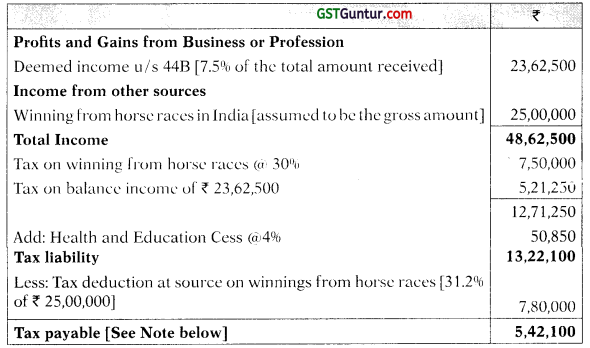
Note: The tax payable would get further reduced by the amount of tax paid u/s 172(4). The amount of tax payable u/s 172 would be 41.6% (being the rate applicable to a foreign company) of 7.5% of ₹ 265 lakhs (being the amounts payable for goods shipped at a port in India) = ₹ 8,26,800. After reducing this amount, the tax ref undable on total income would be ₹ 2,84,700.

Question 46.
On, 1.4.2020, Binu Ltd. of Delhi, a domestic company, engaged in the business of manufacturing of metro rail seats, converted into an LLP by name M/s. Soumya LLP fulfilling all the conditions specified in section 47(xiiib) of the Income-tax Act, 1961. Some of the relevant information is given below in respect of Binu Ltd., as on 31.3.2020:
(a) Voluntary Retirement Scheme (VRS) expenditure incurred by the company during‘the P.Y. 2018-19 is ₹ 20 lakhs. The company was allowed deduction of ₹ 4 lakhs each for the P.Ys 2018-19 & 2019-20 under section 35DDA.
(b) 150 equity shares in Toyo Ltd., an Indian company listed in Bombay Stock Exchange was acquired for ₹ 1,900 per share on 31.7.2017. On conversion, these share become the property of M/s. Soumya LLP.
(c) Besides other assets transferred to M/s. Soumya LLP by M/s. Binu j Ltd., it also transferred two factory buildings. On 1.4.2020, M/s. Soumya LLP leased out one factory building along with plant and machineries and furniture etc. at a consolidated lease rent of ₹ 50,000 per month.
During the previous year 2020-21, the M/s. Soumya LLP earned a profit of ₹ 25,40,000 after debit/credit of the following items to its Profit and loss account:
(i) Mr. Binu is the working partner of the LLP. He is also a working partner in another firm. He is actively engaged in the business of both the firms. Binu gets, a salary of ₹ 55,000 p.m. from M/s. Soumya LLP and the same is authorised in the deed of LLP.
(ii) Mr. Ayushman, an employee, was deputed to work in the client’s office j in Mumbai for three months. The LLP has paid his salary in cash for the months when he was in Mumbai, amounting to ₹ 3,45,000 (net of TDS and other deductions), since he did not have a bank- account in Mumbai. This payment was included in amount of “salary” debited to profit and loss account. Mr. Ayushman is normally posted in Delhi being the headquarter of M/s. Soumya LLP.
(iii) Amount of ₹ 25,000 was paid towards penalty for non-fulfilment of delivery conditions of a contract for sale for the reasons beyond its control.
(iv) The LLP had provided an amount of ₹ 18 lakhs being the sum estimated as payable to workers based on agreement to be entered with workers union towards periodical wage revision once in 3 years. The provision, is based on a fair estimation of wage and reasonable certainty of revision once in 3 years.
(v) Depreciation debited to profit and loss account ₹ 5,40,000.
(vi) Gratuity provisions based on actuarial valuations ₹ 6.5 lakhs. (Gratuity actually paid ₹ 4 lakhs to retired employees debited in Gratuity provision account).
(vii) Profit on sale of shares of M/s. Toyo Ltd. ₹ 1,27,500. These shares were sold on 31.5.2020 for ₹ 2,750 per share. The highest price of Toyo Ltd. quoted on the stock exchange as on 31.1.2018 was ₹ 2,500 per share.
(viii) Repairs to plant and machinery include ₹ 59,000 in respect of plant and machinery given on lease.
(ix) Factory licence fee paid ₹ 15,000 for each factory building.
(x) Legal fee includes ₹ 26,000 paid to an advocate for drafting and registering the lease agreement.

Additional Information:
(1) Under an agreement of debt restructuring, the bank has converted j unpaid interest amounting to ₹ 9,00,000 up to 31.7.2020 into a new loan account repayable in 3 equal annual instalments. The first instalment was paid in March 2021 by debiting the new loan account.
(2) Mr. Binu, being a working partner, bought a car which is registered in his own name out of the funds of LLP. The car was used exclusively for the purposes of the business of the LLP only. The depreciation on the car amounts to ₹ 15,000 for the P.Y. 2020-21 which is not included in the depreciation amount debited to profit and loss account.
(3) Depreciation as per Income-tax Rules ₹ 8,10,000 (including depreciation on the assets given on lease amounting to ₹ 90,000). It does not include depreciation on car.
(4) The LLP sold import entitlements on 1.5.2019 for ₹ 1,50,000. This sum is not included in profit and loss account by treating it as capital receipt.
You are required to discuss the implication of such conversion and calculate the total income in the hands of M/s Soumya LLP for the Assessment Year 2021 -22. [CA Final May 2019 (Old Syllabus)] [14 Marks]
Answer:
Implication on conversion of company into LLP
Transfer of capital asset or intangible asset by a private company or unlisted public company to a LLP or any transfer of share held by shareholder to LLP in a conversion of private company into an LLP is not regarded as transfer u/s 47 provided the conditions specified therein are satisfied.
Accordingly, transfer of capital asset by Binu Ltd., Delhi to M/s. Soumya LLP is not regarded as transfer since the conditions specified in section 47 (xiiib) as stated in the question stand satisfied and fulfilled.
Computation of Total Income in the hands of M/s. Soumya LLP for the A.Y. 2021-22
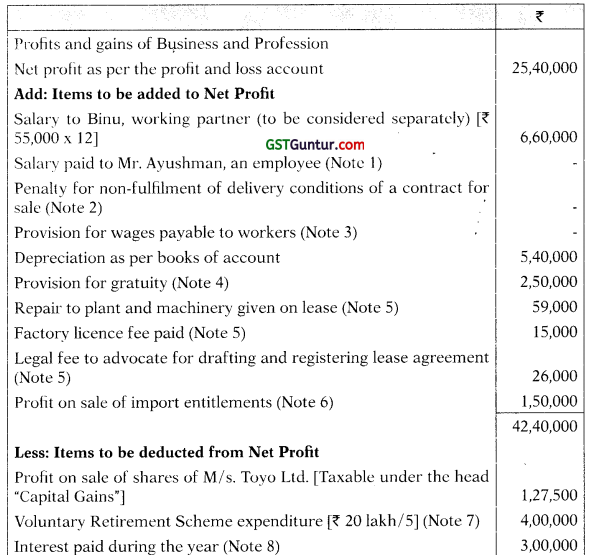
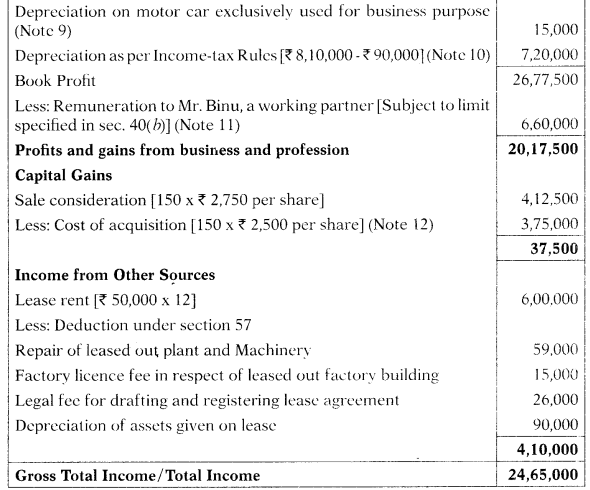

Notes:
1. As per Sec. 40A(3), disallowance is attracted in respeçt of expenditure for which cash payment exceeding ₹ 10,000 is made on a day to a person. However, no disallowance shall be attracted where payment of salary is made to an employee after deducting tax at source and such employee is temporarily posed for a continuous period of 15 days or more in a place other than his normal place of duty and does not maintain any bank account at such place. Therelore, payment of ₹ 3,45,000 after deducting tax at source to Mr. Avushman, an employee, who is temporarily posted in Mumbai and does not have a bank account in Mum bai shall not be disallowed. Since the same has been debited to profit and loss account, 110 adjustment is required.
2. Penalty for non-fulfilment of delivery conditions of a contract for sale is not on account of infraction of law. Penalty for breach of contract is business or commercial loss and would be allowable expenditure u/s 37. Since the same has been debited to profit and loss account, no adjustment is required.
3. The provision is based on fair estimate of wages and reasonable certainty of revision, and thus is allowable as deduction, as ICDS-X requires ‘reasonable certainty for recognition of a provision, which is present in this case. As the provision has been debited to prolit and loss account, no adjustment is required while computing business income.
4. Provision of ₹ 6,50,000 for gratuity based on actuarial valuation is not allowable as deduction as per section 40A(7). However, actual gratuity of ₹ 4,00,000 paid is allowable as deduction. Hence, the difference is to be added back being of ₹ 2,50,000 (₹ 6,50,000 – ₹ 4,00,000).
5. Lease rent from factory building along with plant and machinery and furniture is chargeable to tax under the head income from other sources, since the main business of the M/s Soumya LLP is manufacturing of metro rail seats and not letting out the properties. Therefore, repairs to such plant and machinery, factory license fee paid in respect of leased out factory building and legal fee to advocate for drafting and registering lease agreement is to be deducted from lease income taxable under thy head “income from Other Sources. Since, the same has been debited to profit and loss account, it has to be added back.

6. Profit on sale of import entitlements is chargeable to tax under the head “Profits and gains from business and profession” u/s 28. Since the same has not been credited to profit and loss account, it has to be added.
7. 1 /5th deduction is available in respect of payment for voluntary retirement scheme for 5 years. Where a private company or unlisted company is succeeded by a LLP fulfilling the conditions laid down in section Al{xiiib), then, deduction in respect of voluntary retirement scheme is available to the LLP for the balance years from the year of succession. Hence, deduction of ₹ 4,00,000 is allowable in P.Y. 2020-21 to M/s Soumya LLP being for 3rd year.
8. Conversion of unpaid interest into loan shall not be construed as payment of interest for the purpose of section 43B. The amount of unpaid interest converted into a new7 loan will be allowable as deduction only in the vear in which such converted loan is actually paid. Since ₹ 3 lakhs has been paid in the P.Y. 2020-21, the same is allowable as deduction.
9. Depreciation on motor car bought and used exclusively for the purposes of business is allowable though not registered in the name of the firm.
10. Depreciation on leased out asset to be deducted from lease income taxable under the head “Income from Other Sources. Since the same has been included in depreciation of ₹ 8,10,000, it has to be reduced from it.
11. On first ₹ 3,00,000 of book profit, 90% of book profit or ₹ 1,50,000, whichever is higher and on the balance of book profit, 60% of balance book profit ₹ 16,96,500 (2,70,000, being 90% of ₹ 3,00,000 + ₹ 14,26,500, being 60% of ₹ 23,77,500) restricted to actual remuneration paid to Binu.
12. As per Sec. 55(2)(ac), the cost of acquisition of an equity share acquired before 01.02.2018 shall be higher of the following:
(i) Actual cost; and
(ii) Lower of:
(A) FMV of such share on 31.01.2018, and
(B) Sale consideration
In this case, since FMV on 31.01.2018 is higher, it shall be taken as cost of acquisition and the capital gains shall be long term since shares are held for more than 12 month [Period of holding of Binu Ltd. is also included].

Question 47.
Sankar Ltd. engaged in the manufacture of footwear and leather products, for the past 8 years, reported a net profit of ₹ 272 lakhs as per the statement of profit and loss for the year ended 31st March, 2021. The company was subject to tax audit u/s 44AB of Income Tax Act. The net profit is arrived at after debiting or crediting the following amounts:
(i) Depreciation charged on the basis of useful life of assets as per Companies Act is ₹ 32 lakhs.
(ii) A sundry creditor whose amount of ₹ 32 lakhs was outstanding since long time, has been settled for ₹ 26 lakhs on 31st March, 2021 based on compromise settlement. The amount waived has been credited to the statement of profit and loss.
(iii) Employers’ contribution to EPF of ₹ 3 lakhs for the month of March, 2021 was deposited on 29th July, 2021.
(iv) Interest payments debited 30 lakhs (Includes interest on term loan of ₹ 25 lakhs availed on 1-4-2020 at interest rate of 12% p.a. towards purchase of machinery during the year).
(v) Payment of ₹ 30 lakhs to A & Co., a subcontractor for processing raw leather without deduction of tax is debited to statement of profit loss. This amount includes ₹ 20 lakhs for purchase of chemicals and ₹ 10 lakhs towards labour charges which is separately shown in bills’ submitted.
Additional Information:
(1) The company has not made provision for an amount of ₹ 12 lakhs being a fair estimate of the amount as payable to workers towards periodical wage revision once in 3 years in respect of existing employees. The provision is estimated on a reasonable certainty of the revision once in 3 years.
(2) The written down values of assets before allowing depreciation as per Income Tax Rules are as under:
Factory Buildings: ₹ 180 lakhs
Plant & Machinery: ₹ 170 lakhs (inclusive of ₹ 30 lakhs of machinery acquired on 1.11.2020 and put to use)
Computers: ₹ 15, lakhs
It may be noted that the above values have been duly recognised while providing depreciation in the books of account.
(3) During the year 2020-21, the company has employed 24 additional employees (qualified as “workman” under the Industrial Disputes Act, 1947). All these employees contribute to a rectfgnized provident fund. 12 out of 24 employees joined on 1.6.2020 on a Salary of ₹ 23,000 per month, 4 joined on 1.7.2020 on a salary of ₹ 26,000 per month, and 8 joined on 1.11.2020 on a salary of ₹ 20,000 per month. The salaries of 2 employees who joined on 1.6.2020 are being settled by bearer cheques every month.
(4) Sales include 5000 leather bags sold to M/s Sankar (firm) a related party at a price of ₹ 1,000 each. The selling price to others in the market is at ₹1,300 each.
(5) Employees contribution to EPF of ₹ 3 lakhs recovered from their salaries for the month of March 2021 and shown in the Balance Sheet under the head Sundry Creditors was remitted on 31st May, 2021.

Compute the total income and tax payable of Sankar Ltd. for the Assessment Year 2021-22. The turnover of the company for the year ended 31.3.2019 was ₹ 52 crores. Ignore the provisions of MAT. [CA Final May 2019 (New Syllabus)] [14 Marks]
Answer:
Computation of Total Income of Sankar Ltd. for A.Y. 2021-22
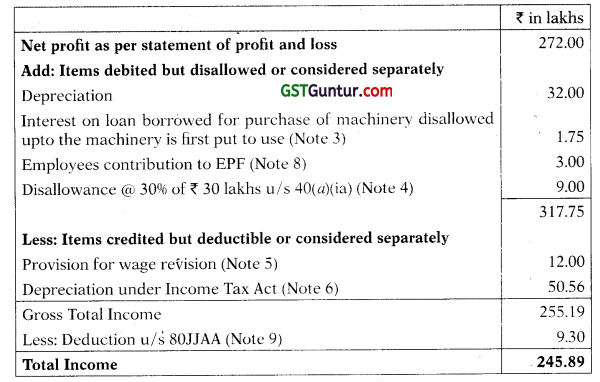
Computation of Total Liability of Sankar Ltd. for A.Y. 2021-22
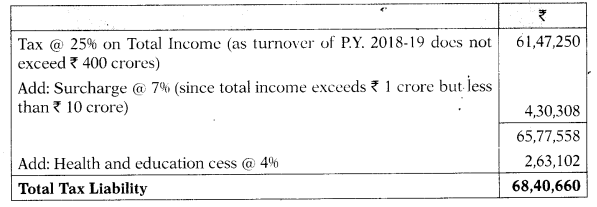
Notes:
(1) As per Sec. 41(1), where in any earlier year, deduction was allowed in respect of loss, expenditure or trading liability incurred by the asses- see and during the current previous year, the assessee has obtained any amount or benefit in respect of such loss, expenditure or trading liability by way of remission or cessation or waiver, then the amount obtained or benefit accruing shall be deemed lo be the profits and gains of business or profession and accordingly. In this case, a sundry creditor whose amount of ₹ 32 lakhs was outstanding since long time, has been settled for ₹ 26 lakhs based on compromise settlement.

Therefore, waiver of ₹ 6 lakhs shall be deemed to be profits and gains of business or profession as per Sec. 41(1). Since, it is already credited to statement of profit and loss, no adjustment is required.
(2) As per Sec. 43B, any sum payable by an employer by way of contribution to provident fund shall be allow ed as deduction only if it is paid on or before the due date for furnishing the ROI u/s 139(1) in respect of the previous year in which the liability to pay such sum was incurred. Since, in this case, employer’s contribution to EPF was deposited on 29.07.2021 which is before the due date of filing ROI u/s 139(1) and therefore, deduction shall be allowed. Since, it is already debited, no adjustment is required.
(3) As per Sec. 36(l)(z7i), interest on capital borrowed for the purposes of business or profession shall be allowed as deduction. However, interest on capital borrowed for acquisition of an asset (whether capitalized in the books of account or not) for the period till the asset was first put to use, shall no 1 be allowed as deduction. In this case, term loan was availed on 01.04.2020 at interest rate of 12% for purchase of machinery and machinery was acquired and put to use on 01.11.2020. Therefore, interest for the period 01.04.2020 to 01.11.2020 shall not be allowed as deduction and it shall be capitalized in the actual cost of machinery. The interest that shall be disallowed will be ₹ 1,75,000 (₹ 25,00,000 × 12% × 7/12).
(4) As per Sec. 40(a)(ia), 30% of any sum payable to a resident on which tax is deductible at source under Chapter XVII-B, shall be disallowed if tax has not been deducted or after deduction has not been paid on or before the due date u/s 139(1). In this case, Sankar Ltd. has made payment to sub-contractor for processing raw le’ather without deducting tax at source u/s 194C and therefore, 30% of ₹ 30 lakhs (i.e. ₹ 9 lakhs) shall be disallowed u/s 40(a)(ia). Even though the purchase of chemicals has been shown separately, tax has to be deducted on the whole amount.
(5) If the provision is made for the present obligation resulting from the past events and which may require outflow’ of resources to settle and reliable estimate can be made, then such provision is allowable as deduction u/s 37(1). Therefore, the company should make provision of ₹ 12 lakhs being a fair estimate of the amount as payable to workers towards periodical wage revision since, it can be estimated on a reasonable certainty. Since, no provision has been made, the provision for periodical wage revision should be debited to statement of profit and loss.
(6) Calculation of Depreciation under Income Tax Act:
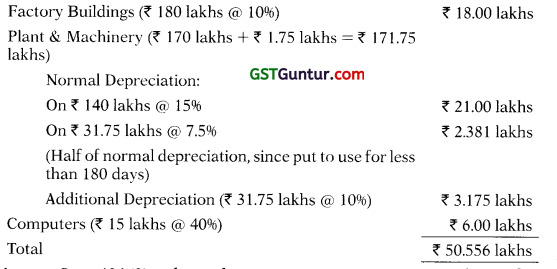
(7) As per Sec. 40A(2), where the assessee incurs any expenditure for which payment Has been made or is to be made to any specified person and the A.O. is of the opinion that such expenditure is excessive or unreasonable having regard to the FMV of the goods, the A.O. shall disallow the expenditure to the extent he considers it excessive or unreasonable. In this case, Sankar Ltd. has sold leather bags to M/s Sankar (firm), a related party, at a price less than the market price. Here, no disallowance u/s 40A(2) shall be attracted since, Sankar Ltd. has not purchased the goods instead sold the good to its related party.
(8) In the case of CIT v. Gujarat State Road Transport Corporation (2014), the Gujarat High Court held that the employees contribution to provident fund deposited after the due date mentioned under the Provident Fund Act is not allowable as deduction as per Sec. 36(1)(va) and hence, it has been disallowed while computing business income.
However, an alternate view has been taken in CIT v. Kiccha Sugar Co. Ltd. (2013) (Uttarakhand) and CIT v. AIMIL Ltd. (2010) (Del), where it was held that the employees contribution to PF, shall be allowed as deduction from the income of the employer-assessee, if the same is deposited on or before the due date of filing of return for the relevant previous year. If this view is considered, then no disallowance would be attracted in this case, since the employees contribution has been remitted before the due date of filing return of income.

(9) As per Sec. 80JJAA, any assessee whose gross total income includes any profits and gains derived from a business and to whom Sec. 44AB applies, deduction shall be allowed @ 30% of additional employee cost incurred in the course of such business. ‘Additional Employee Cost’ means the total emoluments paid or payable to additional employees employed during the previous year. Deduction shall available only if the emoluments are paid by way of an account payee cheque or account payee bank draft or by use of electronic clearing system through a bank account.
Additional employee cost:

Deduction u/s 80JJAA = 30% of ₹ 31,00,000 = ₹ 9,30,000
Note: Additional employee shall not include an employee employed for less than 240 days during the previous year. However, in respect of an assessee engaged in the manufacturing of footwear or leather products, 150 days should be considered instead of 240 days.
Since, all the employees have been employed for 150 days or more during the previous year, deduction shall be available in respect of all the employees except those whose emoluments 2 are paid by bearer cheques. Also, additional employee shall not include employees whose total emoluments are more than ₹ 25,000 per month. Therefore, deduction shall not be available in respect of 4 employees joined on 01.07.2020 since their salary is more than 25,000 per month.

Question 48.
M/s. XYZ Private Ltd., located in Mysore is in the business of manufacturing confectionery items which is listed in the Eleventh schedule. The Company had also set up a chocolate manufacturing unit during the year 2018 at Cheruvu village in Ranga Reddy District, a notified backward area in the State of Telangana.
The Statement of Profit and Loss for the year ended 31st March, 2021 showed a net profit of ₹ 500 lakhs after debit/credit of the following items:
Items debited: ,
(1) Depreciation based on useful life of assets ₹ 300 lakhs.
(2) Repairs and maintenance expenses include ₹ 0.20 lakhs spent on an air conditioner installed in the residence of a director.
(3) An amount of ₹ 10 lakhs were spent on salaries and materials purchased for scientific research and development.
(4) An amount of ₹ 10 lakhs was paid to an employee on his voluntary retirement in accordance with a scheme of voluntary retirement.
(5) Purchase of raw materials includes purchase of wheat in cash for ₹ 20 lakhs from a Mandi on different dates exceeding ₹ 10,000 per day.
(6) The Company has paid ₹ 5 lakhs as regularization fee to the Municipal Corporation of Mysore to regularize the deviation from the sanctioned plan in construction of the factory building.
Additional Information:
(1) The Company has capitalized glow sign board ₹ 10 lakhs installed in the premises of a dealer
(2) Closing stock includes 1000 pieces of imported machinery spares at its landed cost as on the date of import at US $ 20 per piece. Exchange rate on the date of import was 1 US $ = 68. Exchange rate on 31.3.2021 was 1 US $ = 70. The market value per piece as on 31.3.2021 was US$21.
(3) One of the sundry creditors for supply of rice flour was settled on 28.3.2021 for 25 lakhs as against his outstanding balance of ₹ 30 lakhs due to non-supply of the required quality.
However the entire amount was offset against an amount recoverable from the sister concern of the sundry creditor.
(4) The written down value of assets as on 1.4.2020 was as follows:
1. Factory buildings ₹ 500 lakhs
2. (a) Plant and machinery ₹ 1,000 lakhs
(b) New plant and machinery installed and put to use at Cheruvu, on 1.12.2019 ₹ 300 lakhs and on 1.5.2020 ₹ 600 lakhs.
(c) Machinery which was sold to M/s ABC Ltd. on 1.4.2014 at its WDV for 25 lakhs were re-acquired on 1.8.2020 for ₹ 50 lakhs.
3. Lorries and Vans ₹ 100 lakhs.
4. Office Equipment ₹ 50 lakhs. ‘
5. Computers purchased and installed in office on 2.1.2021 ₹ 25 lakhs.

Compute total income of XYZ Private Ltd. for the A.Y. 2021-22. Ignore MAT. [CA Final Nov 2019 (Old Syllabus)] [14 Marks]
Answer:
Computation of Total Income of M/s. XYZ Private Ltd for the A.Y. 2021-22

Notes:
1. Repairs and maintenance expenses spent on an air conditioner installed in the residence is a personal expense and therefore, shall be disallowed.
2. Amount spent on salaries and materials purchased for scientific research and development shall be allowed as 100% deduction u/s 35.
3. As per Sec. 35DDA, where any assessee incurs expenditure by way of payment to employee in connection with his Voluntary Retirement, then deduction shall be allowed as 1 / 5th of the amount for 5 successive years beginning with the year in which such payment is made. Therefore, only 1 / 5th of ₹ 10 shall be allowed as deduction for A.Y. 2021-22 and balance of ₹ 8 lakhs shall be disallowed for the current year.

4. Since, the payment for purchase of wheat from a mandi has been made in cash exceeding ₹ 10,000 per day, it shall be disallowed u/s 40A(3).
5. The amount paid as regularisation fee to the municipal corporation of Mysore to regularise the deviation from the sanctioned plan is inevitably a penalty and the mere fact that it has been described as regularisation fee cannot, in any way, alter the character of the payment which is in the nature of penalty and hence, is not allowable as revenue expenditure [Millennia Developers P Ltd. v. Deputy CIT (2010) (Kar.)].
6. The Delhi High Court in the case of CIT v. Orient Ceramics and Industries Ltd. held that expenditure incurred on glow sigh boards displayed at dealer’s premises is revenue expenditure and shall not be capitalized.
7. ICDS V Tangible Fixed Assets provides that machinery spares which can be used only in connection with an item of tangible fixed asset and their use is expected to be irregular shall be capitalized. Therefore, imported machinery spares which are included in closing stock shall be deducted from closing stock and shall be capitalized. Therefore, 13,60,0 (1,000 pieces × $ 20 per piece × ₹ 68/$) shall be capitalized and shall be eligible for depreciation. Since, tangible fixed asset is a ; non-monetary item, no adjustment shall be made under ICDS VI Effects of Changes in Foreign Exchange Assets.
8. As per Sec. 41(1), where in any earlier year, deduction was allowed in respect of loss, expenditure or trading liability incurred by the assessee and during the current previous year, the assessee has obtained any amount or benefit in respect of such loss, expenditure or trading liability by way, of remission or cessation or waiver, then the amount obtained or benefit accruing shall be deemed to be the profits and gains of business or profession and accordingly.
In this case, a sundry creditor whose amount of ₹ 30 lakhs was outstanding has been settled for ₹ 25 due to non-supply of the required quantity and therefore, waiver of ₹ 5 lakhs shall be deemed to be profits and gains of business or profession as per Sec. 41(1). However, the company has off set such i amount against an amount recoverable from the sister concern of the sundry creditor and therefore, ₹ 5 lakhs shall be bad debt for the company and is allowable as deduction u/s 36(1 )(vii).
9. Calculation of Depreciation and Deduction u/s 32AD:

Since, the company has set up a chocolate manufacturing unit at Cheruvu village, a notified backward area in the State of Telangana, it shall be eligible for additional depreciation @ 35% of actual cost of eligible asset.
The company may have already claimed half of the additional depreciation in respect of new plant & machinery installed and put to use at Cheruvu on 01.12.2019 for RY. 2019-20 and therefore, balance 50% of additional depreciation of ₹ 52.50 lakhs (₹ 300 lakhs × 35% × 50%).
Deduction u/s 32AD is allowed only if the New Plant and Machinery acquired and installed between 01.04.2015 to 31.03.2020. In this case, the new plant and machinery were acquired and installed after I 31.03.2020 and therefore, no deduction u/s 32AD shall.be allowed to the company.
Additional depreciation shall not be available in respect of computers installed in office and machinery re-acquired from M/s. ABC Ltd.

Question 49.
Rama Cements Ltd., is a company engaged in the manufacturing of cement. The company issued 20 lakh equity shares of ₹ 100 each to the general public. The shares were issued at a premium of ₹ 150 per share. The assessee claimed deduction u/s 35D in respect of preliminary expenses at 5% of capital employed and added the amount of share premium to the capital employed to arrive at 5% as eligible amount of deduction u/s 35D. The Assessing Officer, however, disallowed the said expenditure, on the basis that capital employed does not include the share premium amount. Is the action of the Assessing Officer tenable in law? [CA Final Nov 2019 (New Syllabus)] [4 Marks]
Answer:
The issue under consideration is whether premium on subscribed share j capital should be treated as a part of “capital employed in the business of | the company” for the purpose of deduction u/s 35D.
The facts of the case are similar to the facts in case of Berger Paints Indian ; Ltd. v. CIT (2017), where the Supreme Court observed that the share j premium collected by the assessee on its subscribed issued share capital could not form part of “capital employed in the business of the company” for the purpose of section 35D. If it were the intention of the legislature to treat share premium as being “capital employed in the business of the company”, it would have been explicitly mentioned. Also the form of Annual Return under the Companies Act, 2013 dealing with capital structure of the company provides the break-up of “issued share capital” which does not include share premium at the time of subscription.
Applying the above rationale, the action of the A.O. to not include share , premium amount in the capital employed is not tenable in law.

Question 50.
Anamika Builders and Constructions Ltd., a company resident in India is engaged in the business of construction and real estate. Net profit as per profit and loss account is ₹ 54,80,000 (prepared in accordance with ICDS) after debiting/crediting the following items:
(i) Depreciation debited to books, ₹ 8,47,000.
(ii) Gross revenue includes ₹ 5,00,000 in respect of a service contract f for maintenance of the office building for Nitup Ltd. for the period from 1st March, 2021 to 30th April, 2021. The expenses incurred on the project till 31.3.2021 amounts to ₹ 1,27,000 which.is included in other expenses.
(iii) The amount of employee benefits include a sum of ₹ 4,41,000 in respect of bonus payable to employees. In the previous year 2020-21, the company and its employee’s union had a dispute over payment of bonus. In order to avoid late payment of bonus, the company formed trust and transferred the amount of bonus payable to employees to the said trust. The dispute was settled in the month of November, 2020 and the trust paid the amount of bonus to the employees on 30th December, 2021.
(iv) Capital gains on sale of shares in Yara Ltd. ₹ 3,77,500.
(v) In respect of one of its on-going projects, the assessee had made some structural changes contrary to what was earlier approved by the municipal authorities. Assessee hence paid a sum of ₹ 98,000 as regularization fee in respect of such changes made in the construction plan.
(vi) Other expenses include ₹ 1,45,000 as expenditure incurred on CSR.
(vii) During the previous year, 2020-21 the assessee entered into an agreement with Bat Ltd. As per the agreement, Bat Ltd. has agreed to not to engage in the business of real estate trading. The assessee paid 11 lakhs without deduction of tax at source on 1-6-2020 as non-compete fee.

Additional Information:
(i) Depreciation as per Income-tax Act, ₹ 5,14,000. This includes an amount of ₹ 78,000 in respect of fire fighting equipments installed in various business premises /offices of the assessee. During the year, as there was no incidence of fire, these equipments were not used.
(ii) On 26th October, out of 5 unsold office spaces in a mall, the assessee converted one such space into its own office. The fair market value of that space as on that date was ₹ 15,00,000. The cost incurred originally to construct such space was ₹ 10,00,000.
(iii) In respect of ongoing construction contracts, there was a claim for escalation of prices, to the tune of ₹ 8,50,000. The company had filed a lawsuit in the yehr 2019. In the previous year 2020-21, the court gave its judgment in favour of the company. The company has received ₹ 2,00,000 till 31.03.2021. Gross receipt in the profit and loss account H includes ₹ 2,00,000 in respect of such claims.
(iv) The assessee held 250 shares in Yara Ltd. On 1.4.2017, Yara Ltd. I allotted bonus shares in the ratio of 1:1. The company sold all the shares in Yara Ltd. on 24th September 2020 for ₹ 2,050 per share. The company had acquired the original shares for ₹ 540 on 23-06-2016. The fair market value of the shares as at 31 st January 2018 was 1,980 per share.
You are required to compute the total income chargeable to tax in the hands of Anamika Builders and Constructions Ltd., for the Assessment [ Year 2021-22 giving a brief explanation to each item of additions or deletions. Ignore provisions of MAT. [CA Final Nov 2019 (New Syllabus)] [14 Marks]
Answer:
Computation of Total Income of Anamika Builders and Constructions Ltd. for A.Y. 2021-22
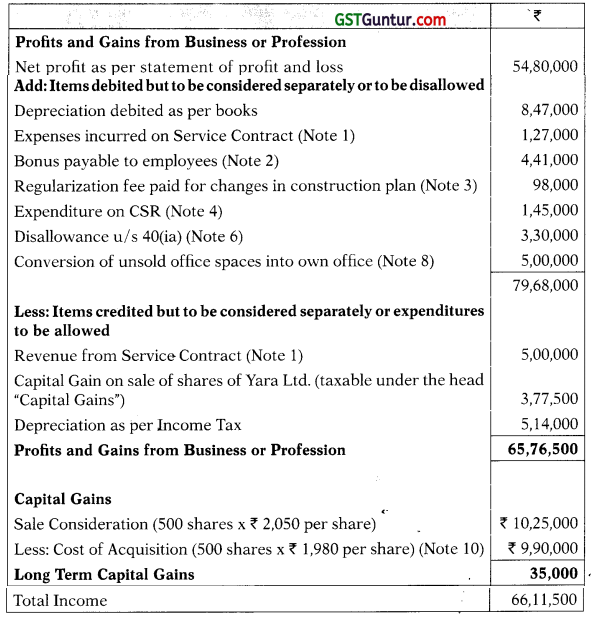
Notes:
1. As per Sec. 43 CB, profits and gains from contract for providing services with duration of not more than 90 days shall be determined on the basis of project completion method. However, ICDS IV provides that revenue from service contracts with duration of not more 90 days may be recognised on the completion of the contract or on percentage completion method.
Whenever, there is conflict between the provisions of the Act and the notified ICDSs, the provisions of Act shall prevail. Therefore, Sec. 43CB shall be applicable and the revenue and expense ; of a service contract for maintenance of the office building shall be recognised when the contract gets completed i.e. on 30th April, 2021. Hence, revenue from service contract shall be reduced and expenses in respect of service contract which are included in other expenses shall be added back.

2. The Supreme Court in the case of Shasun Chemicals & Drugs Ltd. held that where payment of Bonus to employees is paid to a trust and subsequently paid to employees from such trust before the stipulated due date as per section 43B, the same would be allowable u/s 36(1) (ii) while computing business income. As the amount transferred to trust is paid to the employees after the due date for filing the return of income as per section 43B, the same shall not be allowed as deduction and as it is debited to profit & loss account, it needs to be added back.
3. The amount paid as regularisation fee in respect of changes made in the construction plan is inevitably a penalty and the mere fact that it has been described as regularisation fee cannot, in any way, alter the character of the payment which is in the nature of penalty and hence, is not allowable as revenue expenditure [Millennia Developers P Ltd. v. Deputy CIT (2010) (Kar.)].
4. Any expenditure incurred on CSR shall not be deemed to be an expense incurred for the purpose of business and profession and shall not be allowed as deduction u/s 37.
5. Assessee has deposited 1,75,000 with the concerned authority for the expansion of the business and opening a retail petrol outlet. However, as the assessee could not start this operation, the amount has been forfeited. It was held in the case of Priya Village Roadshows Ltd. that where the expenditure has been incurred for expansion of the project and the same does not result into a new asset, it shall be classified as Revenue expenditure only. Since, the assessee could not start the operation in respect of new petrol outlet, the amount forfeited shall be treated as revenue expenditure.
6. Section 40( ia) disallows 30% of any sum payable to a resident on which tax has not been deducted or after deduction has not been paid to the credit of central government on or before the due date mentioned u/s 139(1). The assessee paid 11 lakhs without deduction of tax at source on 1.6.2020 as non-compete fee on which tax was required to be deducted u/s 194J and thus 30% of the same (i.e. 11,00,000 × 30%= 3,30,000) shall be added back to the statement of profit & loss.
7. In the case of Southern Petrochemicals Industries, it was held that the assessee is entitled to depreciation on spare parts which are stand by items like Firefighting equipment even though they were not taken for use during the previous year.
8. As per section 28, where an inventory is converted into capital asset, the FMV of the inventory as on the date of conversion shall be treated as Business Income. Therefore, ₹ 5,00,000 (₹ 15,00,000 – ₹ 10,00,000) shall be added to the net profits.

9. ICDS III Construction Contracts provides that contract revenue shall comprise of initial amount agreed and variations in contract work, I claims and incentive payments to the extent it is probable that they I will result into revenue and they are capable of being reliably measured.
In this case, in respect of claim for escalation price, the court gave its judgment in favour of the company and so there is certainty that the claim shall be received. The company has credited ₹ 2,00,000 in respect of such claim to the statement of profit and loss and by assuming that this has been recognised by following the percentage completion method, no further adjustment is required.
10. As per section 55(2)(ac), Cost of acquisition for Long term equity shares acquired before 01.02.2018 shall be higher of:
(a) Actual cost of acquisition, or
(b) Lower of :
- FMV as on 31.01.2018, or
- Actual sale consideration received or accrued.
Therefore, the cost of acquisition shall be higher of ₹ 1,980 per share, 2 being the FMV on 31.01.2018 and ₹ 540, being the actual cost per share, Hence, cost of acquisition u/s 55(2)(ac) shall be ₹ 1,980 per share. In f respect of bonus shares also, the FMV of shares as on 31.01.2018 may be taken as the cost of acquisition.
![]()
![]()
![]()
![]()
![]()
![]()
![]()
![]()
